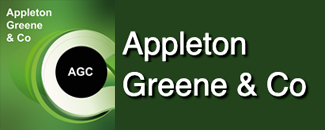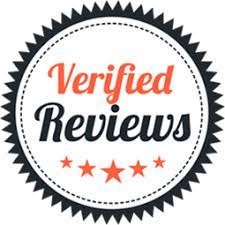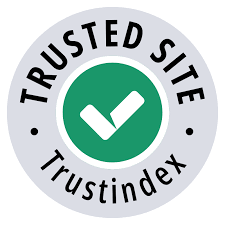Technology Leadership – Workshop 1 (Strategic Vision)

The Appleton Greene Corporate Training Program (CTP) for Technology Leadership is provided by Mr. Prasad Certified Learning Provider (CLP). Program Specifications: Monthly cost USD$2,500.00; Monthly Workshops 6 hours; Monthly Support 4 hours; Program Duration 12 months; Program orders subject to ongoing availability.
If you would like to view the Client Information Hub (CIH) for this program, please Click Here
Learning Provider Profile
Mr. Prasad has over 20 years of distinguished experience in technology leadership. Mr. Prasad has successfully guided startups, SMBs, and enterprises in leveraging technology to scale and drive measurable growth via Fractional CTO/CPO consultancy services.
Mr. Prasad holds a master’s in electrical engineering from the University of Houston and certifications including Project Management Professional and Certified Scrum Master. His extensive professional portfolio spans roles such as CEO at Delence, Vice President of Product & Engineering at TransCore, Senior Technical Project Manager at JPMorgan Chase, and Vice President of Product & Engineering at Servient Inc., where he notably reduced maintenance costs and implemented agile methodologies that significantly improved client outcomes.
Mr. Prasad’s industry expertise spans financial services, software development, education technology, transportation, and digital transformation. He is proficient in Agile methodologies, strategic foresight, cloud technologies, and innovation management. He has a proven track record in assembling high-performing teams and creating tech solutions aligned closely with business objectives.
As a global professional, Mr. Prasad’s unique international experience having been born in India, raised in Nigeria, and settled in Houston allows him to bring diverse cultural and operational perspectives to his technology leadership. He begins each day with yoga and meditation, emphasizing mindfulness and balanced decision-making in leadership roles.
Mr. Prasad is the ideal person to lead this workshop, bringing practical experience, strategic clarity, and actionable insights essential for technology leaders navigating a complex and rapidly evolving technology landscape.
MOST Analysis
Mission Statement
Executives learn the importance of setting a clear strategic vision in a dynamic tech landscape. The workshop focuses on aligning technology strategies with business goals, fostering long-term growth, and remaining agile in competitive environments. Participants will identify their leadership vision and understand how it shapes their organizations’ futures. Participant Outcome: Articulate a forward-looking technology vision aligned with business objectives and establish immediate steps to begin executing that vision.
Objectives
By the end of this workshop, participants will be able to:
• Define a clear strategic vision aligned with business priorities.
• Analyze how emerging technologies impact industry dynamics.
• Apply scenario planning to anticipate future technology trends.
• Identify gaps in current technology strategy and propose improvements.
• Develop decision frameworks to prioritize high-impact initiatives.
• Communicate strategic vision effectively to diverse stakeholders.
• Align technology roadmaps with organizational mission and vision.
• Foster a culture that supports innovation and agile thinking.
• Build cross-functional alignment for digital transformation efforts.
• Evaluate risks and opportunities in strategic technology planning.
• Leverage storytelling techniques to inspire organizational buy-in.
• Measure progress and adapt the vision based on performance metrics.
Strategies
To accomplish these objectives, the workshop will employ the following targeted strategies:
• Break down successful technology vision case studies (e.g., Apple, Amazon, Netflix) to identify replicable strategic patterns.
• Facilitate deep-dive sessions on trend analysis, allowing participants to examine how future technologies may disrupt or enhance their industries.
• Introduce scenario planning frameworks (e.g., STEEP, SWOT) tailored to technology strategy.
• Use guided exercises to help participants draft strategic vision statements and validate them against organizational goals.
• Provide templates and tools to map technology initiatives to business KPIs.
• Include peer review sessions where participants critique each other’s strategic visions.
• Incorporate role-play exercises simulating board presentations to hone executive communication skills.
• Analyze gaps in existing tech portfolios using structured gap analysis tools.
• Train participants on prioritization techniques (e.g., effort-impact matrix, MoSCoW).
• Teach communication techniques using the “hero’s journey” storytelling model to gain executive and team buy-in.
• Facilitate strategic foresight workshops using trend forecasting methods.
• Offer templates for dashboard creation to monitor strategic execution.
Tasks
To achieve the stated objectives effectively, participants will undertake the following structured tasks:
• Draft a personalized strategic vision that aligns with their organization’s mission and future goals.
• Identify and evaluate three emerging technologies relevant to their industry and score them for impact and readiness.
• Complete a scenario planning exercise projecting three future states for their sector, based on key uncertainties.
• Conduct a gap analysis of technology capabilities, tools, and team skills, and document three priority improvement areas.
• Build a prioritization matrix ranking current and proposed initiatives by ROI, urgency, and alignment with strategic goals.
• Create a one-page stakeholder communication plan outlining messages, formats, and delivery strategies by audience.
• Develop a 12-month strategic technology roadmap with quarterly milestones and alignment with business OKRs.
• Identify barriers to innovation in their organization and propose two cultural interventions to support agile thinking.
• Map a cross-functional alignment plan detailing how to engage leaders from key departments in strategic technology execution.
• Conduct a risk analysis on one high-priority initiative and prepare a mitigation plan using a structured risk matrix.
• Write and deliver a compelling technology leadership narrative using the Hero’s Journey structure.
• Design a KPI dashboard for monitoring strategic vision implementation, including data sources, update cadence, and reporting plan.
Introduction
In today’s rapidly evolving digital landscape, the role of technology leaders extends far beyond traditional IT management. Historically, IT roles focused primarily on ensuring system uptime, managing infrastructure, and implementing enterprise software. These responsibilities, while still essential, no longer define the full scope of a technology executive’s contribution to organizational success. The business world is now characterized by rapid innovation, global interconnectivity, and constant disruption, requiring technology leaders to step into new roles as visionaries, strategists, and agents of transformational change.
From the 1970s to the present, the evolution of the technology leader has paralleled the broader arc of technological and organizational transformation. In the 1970s, the technology function was largely back-office and focused on automating routine administrative tasks. This was the era of batch processing, punch cards, and the dominance of IBM mainframes. IT professionals were often isolated from business decision-making, operating as custodians of emerging but limited computing resources. Technology leadership at the time was largely technical, with little influence on business strategy.
The 1980s saw the consolidation of mainframe computing and the emergence of the IT department as a core operational unit. Uptime reliability and centralized data management were the primary focus areas. This decade introduced personal computing to the workplace, but leadership remained focused on controlling access, maintaining security, and ensuring data integrity. Technology leaders began to gain more visibility, though their influence remained tethered to cost efficiency and operational continuity.
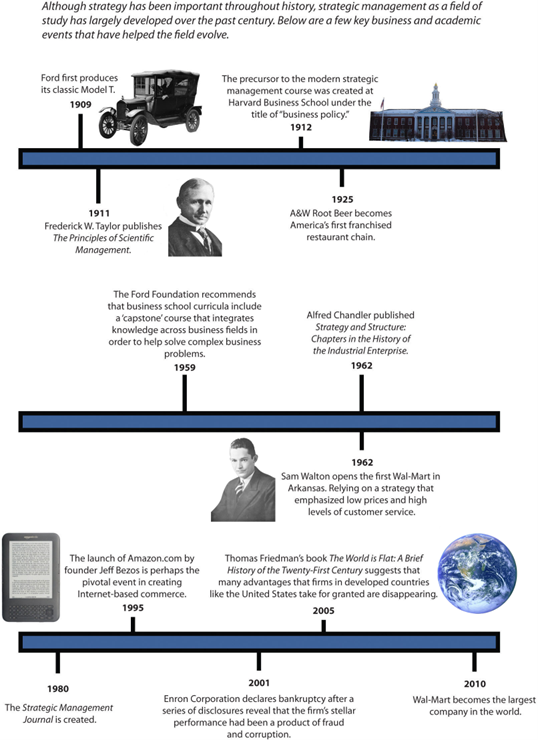
In the 1990s, technology executives faced the dual challenges of the Y2K crisis and the rise of distributed computing. The proliferation of client-server architectures brought new possibilities for business applications but also introduced significant complexity. IT was no longer confined to a central office—it was now decentralized, with servers in departments and data flowing across networks. This shift required technology leaders to become risk managers and system integrators, aligning disparate tools while preparing for the potential chaos of the Y2K rollover.
The 2000s were shaped by globalization and the drive for enterprise efficiency. Enterprise Resource Planning (ERP) systems became the backbone of large organizations, integrating finance, supply chain, HR, and more. This era saw widespread outsourcing of IT operations and the increasing use of offshore development teams. Technology leadership now included vendor management, process optimization, and change leadership. The role expanded beyond infrastructure to enabling strategic business transformation through system integration and automation.
In the 2010s, the cloud revolution reshaped the technology landscape. Cloud computing, mobile technologies, and big data redefined scalability, accessibility, and decision-making. IT leaders had to reimagine security, governance, and architecture for a world where services were no longer confined to physical data centers. The rise of consumer technology also meant that user experience became a boardroom topic, pushing technology leaders to think like product designers and customer advocates.
Now, in the 2020s, the role has grown even more multifaceted. Technology executives are expected to navigate intelligent platforms, machine learning, and AI-driven decision-making while ensuring compliance with fast-changing regulations and societal expectations. Environmental, Social, and Governance (ESG) metrics are influencing technology investment decisions. Trust in AI, ethical use of data, and continuous innovation are at the forefront. The modern technology executive must draw from decades of legacy while staying adaptive to geopolitical uncertainty, workforce transformation, and human-centered design.
This historical arc highlights how technology leadership has matured from a narrowly defined technical maintenance role to a central pillar of enterprise strategy, innovation, and transformation. What was once seen as a function dedicated to maintaining uptime and operational efficiency is now expected to steer organizations through waves of technological disruption, drive sustainable innovation, and shape the digital future of the business. Today’s technology executives must not only understand the intricacies of cloud platforms, cybersecurity, data architecture, and artificial intelligence, but also possess strategic foresight, cross-functional collaboration skills, and a strong grasp of organizational dynamics. They must act as translators between technical teams and business stakeholders, as cultural change agents who build agile and resilient teams, and as ethical stewards of emerging technologies that influence not only corporate outcomes but also societal well-being.
This evolution calls for a new kind of leader, one who is deeply grounded in technology and equally skilled in vision, influence, and adaptability. It is no longer enough to deliver projects on time or maintain systems with high availability. The modern technology leader must anticipate emerging risks, interpret complex global shifts, and position their organization to thrive in a world defined by volatility and rapid transformation. These leaders must cultivate a clear sense of purpose while creating flexible strategies that can evolve with shifting market demands and technological advancements. They need to foster a culture of continuous learning, where experimentation is encouraged, and failure becomes a stepping stone to innovation. They must engage teams across geographies and disciplines, unify fragmented initiatives under a coherent narrative, and drive alignment around long-term goals while still delivering short-term value. They are responsible for designing digital environments that are inclusive, accessible, and secure, while also upholding ethical standards that build trust with customers, employees, regulators, and the public. Ultimately, today’s technology leaders must rise as strategic architects of transformation, capable of inspiring change, shaping future-ready organizations, and leading with integrity in an increasingly interconnected world.
We envision this new paradigm coming to life in a variety of real-world contexts, highlighting the kind of impact participants in this program could ultimately drive. For example, a CTO at a major healthcare provider might lead a data modernization initiative that improves clinical efficiency while ensuring compliance with evolving patient privacy regulations across multiple jurisdictions. In another scenario, a CIO at a global manufacturing firm could implement a digital twin strategy that combines IoT, artificial intelligence, and simulation tools to optimize operations and reduce carbon emissions in alignment with ESG goals. In the public sector, a technology leader working within a large city government might use open data platforms and citizen-centered design to strengthen emergency response systems and foster public trust through transparency and digital equity.
The Technology Leadership Program has been carefully designed to meet these complex and evolving demands. It equips participants with a comprehensive toolkit of strategic thinking models, innovation frameworks, leadership capabilities, and real-world case studies. The program goes beyond traditional leadership development by integrating forward-looking topics such as strategic foresight, AI ethics, ESG-aligned innovation, and adaptive road mapping. Through immersive modules, group exercises, and hands-on projects, participants will learn how to assess organizational readiness, articulate clear visions, align teams, and execute technology strategies that deliver measurable impact.
Ultimately, this program prepares technology leaders not just to respond to change, but to lead it. It empowers them to move beyond tactical execution and become influential architects of transformation, capable of guiding their organizations through complexity, building trust with stakeholders, and creating technology environments that are resilient, equitable, and visionary.
This shift means that today’s technology executives must not only manage infrastructure but also lead digital innovation, shape strategic direction, and build bridges between technology and business functions. They must be prepared to anticipate trends, inspire teams, and guide their organizations through complex and uncertain environments.
As part of this foundational orientation, the workshop highlights several key megatrends that are shaping the future of technology leadership. These include the rise of quantum computing and its implications on encryption, the increasing pressure for tech-enabled ESG accountability, the integration of generative AI into decision-making workflows, the shift toward zero-trust architectures in a hybrid security environment, and the organizational implications of digital twin platforms and immersive collaboration. For example, how will your leadership stance adapt as more cognitive decisions are assisted by AI? What strategies must be employed to meet stakeholder demands for tech-enabled carbon transparency? These framing questions invite introspection and prepare the participant to navigate the intersection of what is possible and what is responsible.
Participants are encouraged from the outset to consider these framing questions:
• How aligned is your current technology portfolio with your organization’s purpose and long-term positioning?
• Where is your leadership presence strongest and where must it evolve for greater ecosystem influence?
• How prepared are you to lead change ethically in a world of continuous disruption?
• In what ways can your technology roadmap create value for both customers and society?
• What legacy are you building through your technology leadership, and how is that legacy experienced by those around you?
• How do you identify and close gaps between your leadership intent and your team’s day-to-day experience?
• What assumptions about your role, your market, or your team need to be challenged to move forward?
• Where are you playing it safe when bold leadership is required?
By confronting these questions at the start, leaders activate their critical thinking and align their learning to the deepest strategic needs of their organization.
Throughout this journey, the introduction amplifies relevance by including vignettes from various industries. For instance, in the financial services industry, a head of digital strategy used this workshop to position their bank as a platform for micro-entrepreneurship, enabled by blockchain and APIs. In healthcare, a chief architect introduced AI-enabled diagnostics as a way to reduce rural health disparities. In energy, a head of IT shifted their company’s narrative from compliance to climate leadership through real-time emissions dashboards.
By weaving these stories into the introduction, the workshop speaks not to a single audience, but to leaders across healthcare, finance, logistics, education, and public service. The message is clear: the principles of visionary technology leadership apply universally, even as implementation varies by context.
By integrating historical insight, foresight analysis, reflective questions, and cross-sector relevance, the introduction to the Technology Leadership Program becomes not just an entry point, but a strategic orientation to the future of leadership itself. It acknowledges the personal and professional challenges faced by emerging and seasoned leaders alike. Many participants enter the program feeling the weight of dual responsibilities: to deliver technical excellence and to act as strategic advisors, often without the clarity or confidence needed to navigate both roles. Others arrive having succeeded in execution but struggle to influence across functions, lead through ambiguity, or articulate a vision that inspires trust. This program creates the space, the structure, and the peer support to confront those leadership inflection points directly.
Participants often begin this journey focused on outputs and emerge focused on outcomes. They start by thinking about systems and architecture, and gradually begin thinking about trust, value, and strategic ecosystems. One leader in the program shared, “Before this experience, I led with technical certainty. Now I lead with moral clarity and cultural alignment.” This kind of transformation is not incidental, it is designed, facilitated, and embedded through the structure of the workshop and the reflections it enables.
The program also continues to build relevance by drawing on leadership stories from across industries. In higher education, a campus CIO used the frameworks in this program to restructure how digital services supported non-traditional learners, resulting in the creation of a mobile-first lifelong learning platform. In transportation, a regional transit authority participant developed a cross-agency data-sharing policy that improved commuter safety while respecting data privacy norms. And in manufacturing, a digital operations leader used agile governance tools from the workshop to unlock a stalled ERP modernization effort by reframing it around frontline workforce empowerment.
Underlying all of these stories is a central insight: leadership is not just a matter of decision-making or authority—it is a matter of identity and intention. This program encourages participants to ask, “What kind of leader do I want to become, and what systems, habits, and support structures do I need to sustain that identity over time?” These questions are more than reflective exercises—they are tools for conscious growth.
Finally, the impact of the Technology Leadership Program is not limited to the workshop itself. Many participants go on to form peer advisory groups, facilitate internal leadership circles in their organizations, or mentor future participants. One graduate launched a biannual leadership symposium at her company to share lessons learned and invite cross-industry insights. Another introduced a change leadership academy within his enterprise using this curriculum as the foundation. The workshop is not a transaction, rather a transformation, and its effects multiply long after the last session ends.
Core Objectives of the Workshop
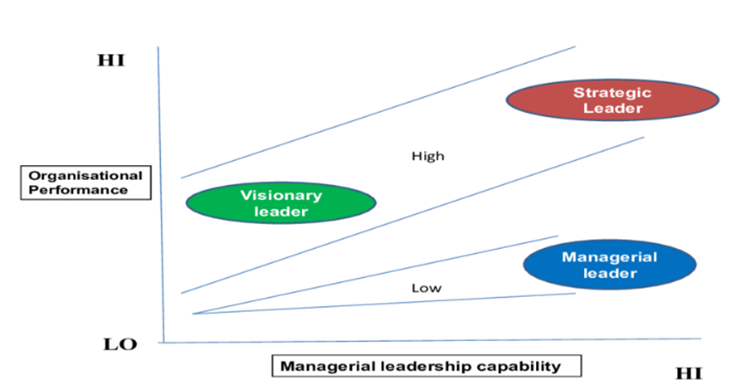
The workshop focuses on developing strategic technology leaders who can:
1. Envision and articulate a future-focused, enterprise-aligned technology vision
Participants will learn to craft a bold yet attainable vision that connects the future of technology to the organization’s core business model. For example, a technology lead in an agricultural logistics firm may create a vision to integrate predictive analytics for crop yield and supply chain optimization, positioning their company as a data-first partner to farmers. Through guided exercises, leaders will practice articulating such visions using narrative frameworks and feedback loops.
2. Interpret and act on emerging trends using foresight frameworks and scenario planning
Participants will work with tools like PESTLE and Horizon Scanning to uncover patterns that signal disruption or opportunity. A participant in the insurance sector, for instance, might identify parametric insurance and climate analytics as rising trends and construct scenarios that prepare their firm to pivot from traditional actuarial models to real-time risk pricing. Scenario exercises simulate the practical process of evaluating trend impact across business lines.
3. Align their vision with organizational purpose, values, and strategy
Participants will gain tools for integrating their technology vision with the company’s mission and brand. For example, a leader at a health tech company committed to “personalized care for all” may align their digital vision with mobile-first diagnostics and equitable access. Exercises include mapping technology objectives to cultural values and customer promises, ensuring vision alignment is both rational and emotionally resonant.
4. Mobilize people, processes, and systems around a unified strategic direction
Participants will learn how to move from vision to alignment by translating broad ambitions into cross-functional initiatives. A government CIO might pilot an inter-agency data exchange platform aligned with transparency and service delivery reforms. The workshop will equip participants with stakeholder mapping tools and alignment canvases to facilitate structured collaboration.
5. Communicate vision with clarity, confidence, and emotional resonance
Participants will learn how to share their vision in a way that motivates and connects. One participant from a global food conglomerate might use storytelling to communicate how supply chain traceability will empower farmers and build consumer trust. Sessions will include communication drills using the Hero’s Journey and the SCQA (Situation, Complication, Question, Answer) model tailored to different stakeholder audiences.
6. Influence organizational culture and build adaptive, high-performing teams
Participants will study how to use rituals, incentives, and feedback systems to shape behaviors aligned with innovation and resilience. A retail technology leader, for instance, may introduce weekly “fail forward” learning circles to encourage experimentation. The program emphasizes leadership actions that shift team mindset from execution to ownership and from risk-aversion to calculated innovation.
7. Translate long-term vision into short-term priorities and roadmaps
Participants will use agile planning and milestone mapping to break down large ambitions into achievable outcomes. A hospital CTO might translate a vision of “AI-assisted clinical decision-making” into phased initiatives, starting with pilot projects in radiology and nursing triage. Sessions focus on balancing quick wins and strategic infrastructure investments.
8. Define and measure the impact of vision through quantitative and qualitative metrics
The program introduces scorecard templates, OKR alignment grids, and storytelling dashboards. A participant leading enterprise AI adoption may define impact by blending customer satisfaction scores, adoption rates, and qualitative anecdotes from frontline users. Peer reviews will allow each participant to iterate on metric design and develop custom dashboards to support visibility.
9. Lead inclusively and ethically in ways that support trust, engagement, and sustainability
Ethical foresight and inclusive design will be core to this objective. For instance, a fintech product leader might identify bias in credit algorithms and lead a redesign using fairness-aware machine learning. Workshops will explore stakeholder empathy, accessibility standards, and stakeholder testing, alongside exercises in ethical risk evaluation and governance design.
10. Strengthen their credibility with executive leadership, boards, and external partners
Participants will refine how to present strategic narratives, defend investment cases, and navigate difficult conversations with confidence. For example, a cybersecurity head might build board credibility by developing a visual risk dashboard and preemptively aligning breach response plans with executive expectations. Mock presentations and storytelling challenges help participants master presence and framing.
Participants will apply these skills immediately through a blend of structured exercises, immersive simulations, and cross-industry case study analysis. Each module is designed with hands-on application in mind—starting with self-assessments and reflection tools to ground participants in their current leadership context. They will then move through interactive workshops where they test new frameworks in small-group settings, receive real-time peer and facilitator feedback, and adapt their approaches in response to dynamic scenarios.
Throughout the workshop, participants will engage in live simulations—such as presenting technology vision briefs to mock executive panels, navigating stakeholder resistance in strategic alignment role plays, and leading cultural change dialogues modeled on real organizational friction points. These experiences are designed to replicate the ambiguity, tension, and speed of real strategic decisions in the field. Participants will work in cross-functional teams to solve a complex technology leadership problem that spans multiple domains—strategy, operations, culture, ethics, and metrics. For example, one team might be tasked with designing a transformation roadmap for a legacy financial institution adopting AI and blockchain, while another team tackles a sustainability-driven digital overhaul for a consumer goods company. Teams will need to articulate a clear vision, align stakeholders, structure the change effort, anticipate risks, and present a compelling strategic narrative to a simulated board or investor group.
By embedding practice into every stage of the workshop, the program ensures that participants not only internalize leadership frameworks but also build the muscle memory and confidence to apply them under pressure. The experience culminates in actionable outputs such as personal leadership maps, team alignment plans, and stakeholder-ready vision statements. Participants can take these learnings back to their organizations and begin using immediately to drive impact.
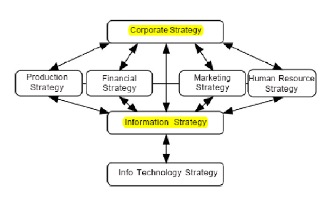
Participant Benefits
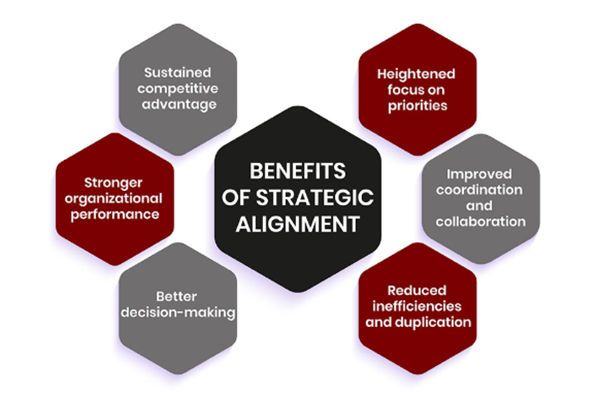
Upon completion of this workshop, participants will experience transformative professional development, positioning them for expanded leadership influence, stronger stakeholder trust, and long-term organizational impact. The benefits of the program extend far beyond theoretical understanding. They are rooted in practical, observable change and supported by specific frameworks and case-based illustrations.
Gain clarity in articulating a compelling leadership and organizational vision
Participants will learn to define and express a bold yet realistic vision that resonates with diverse stakeholders. For example, a participant leading IT at a healthcare nonprofit may develop a vision focused on integrating AI-based patient engagement to reduce no-show rates and increase community health equity. Another participant at a logistics startup may articulate a vision to use automation to democratize access to global supply chains for small businesses. Through structured exercises, participants practice transforming complex aspirations into narratives that generate momentum and trust.
Master frameworks for aligning technology initiatives with broader business strategy
Participants will engage with tools such as Hoshin Kanri, OKRs (Objectives and Key Results), and strategic alignment matrices to ensure their technology roadmap mirrors enterprise priorities. One technology leader from a university system used alignment maps to connect digital campus goals with student retention targets. Another participant in an energy company translated a sustainability mandate into cloud platform design choices that lowered carbon output. The focus is on making strategic alignment operational and measurable.
Develop foresight skills to anticipate disruption and identify innovation opportunities
Leaders will use STEEP and PESTLE analysis along with scenario planning to build anticipatory capability. For example, a financial services executive may create a playbook for responding to emerging fintech competitors by developing a roadmap for open banking APIs and decentralized identity platforms. Another participant in retail may explore trends in immersive commerce and prepare the organization to pilot augmented reality storefronts. Participants will leave with a foresight framework tailored to their sector and internal change rhythms.
Build emotional and social intelligence to lead change with empathy and resolve
Through case studies and feedback labs, participants will learn how to lead with authenticity and navigate tension constructively. A CIO managing a post-acquisition integration may face resistance from legacy teams, and learn to balance transparency with urgency, offering clarity while respecting emotional undercurrents. One technology executive leading a DevOps transition used social feedback techniques to recalibrate how her presence influenced engineers and business stakeholders alike. These experiences build lasting habits of emotional literacy.
Practice inclusive leadership and cultivate cultures of innovation and psychological safety
Inclusive leadership is not an abstract ideal, but a daily practice. A participant from a tech startup may develop rituals for inclusive brainstorming that rotate facilitation among introverted and extroverted team members. A leader in a financial services firm restructured their innovation fund process to include junior staff submissions and blind evaluations. Leaders will build psychological safety by modeling vulnerability and reinforcing team norms that support openness and dissent, fostering environments where diverse perspectives accelerate progress.
Design execution roadmaps with agile methods and outcome-based metrics
Participants will learn to translate vision into agile execution using backlog prioritization, sprint planning, and adaptive KPIs. For instance, a participant leading an internal platform team may create a roadmap that breaks a multi-year vision into quarterly releases, using burn-up charts and team satisfaction scores as health indicators. Another participant introduced user story mapping and customer journey KPIs to drive alignment across product, engineering, and sales.
Reflect on personal purpose and leadership values and define their leadership identity
Leadership identity will be explored through reflection journals, peer dialogue, and personal storytelling. A senior engineer transitioning into leadership may discover their core value is not technical mastery but enabling others’ success. This insight may lead them to shift from hands-on delivery to coaching product squads, unlocking untapped team potential. Another participant might uncover their strength in boundary-spanning leadership, prompting a shift from team lead to enterprise integrator.
Join a growing network of peers for shared learning, mentorship, and ongoing support
Participants will become part of a dynamic alumni network committed to each other’s success. A graduate of the program who becomes CTO of a retail company may later mentor another participant navigating omnichannel transformation. In another case, a leader returned to their organization and initiated a peer-learning circle modeled on the workshop’s reflection exercises. These relationships extend the value of the program and build a leadership fabric that strengthens industries and ecosystems.
Additional Benefits by Leadership Dimension
Strategic Thinking
Participants learn to integrate horizon scanning into regular planning cycles. A director at a logistics company may identify autonomous delivery as a disruptive force and reframe their three-year roadmap to pilot last-mile robotics. They also engage in foresight mapping that reveals adjacent threats and opportunities. For example, another participant might realize the impact of extreme weather on warehouse operations and initiate a data analytics effort to optimize shipping routes by season.
Cross-functional Collaboration
Leaders will understand how to align cross-departmental incentives. A program manager introducing DevSecOps designed a shared success dashboard between security, engineering, and product. They will also learn to dismantle silos by hosting joint planning sprints and cross-training initiatives. One executive working in public infrastructure integrated digital twins by co-developing requirements with both IT architects and operational leaders.
Innovation Culture
Leaders learn how to protect and scale grassroots innovation. A participant at a telecom company may implement a quarterly idea challenge with C-level sponsorship, resulting in higher engagement and breakthrough pilot projects. Others may launch internal incubators with rotational sponsorship or reconfigure reward systems to elevate learning from failure. A leader in a retail enterprise piloted a “Permission to Test” fund that gave every employee $500 to experiment, leading to unexpected process innovations in customer returns.
Resilience and Adaptability
Participants practice crisis simulations to strengthen leadership under pressure. One executive leading cloud migration during a data breach may later apply lessons from the simulation to calm stakeholders and lead an accelerated remediation plan. They also cultivate rapid feedback loops, resilience rituals, and scenario stress-testing. For instance, a regional government leader used these skills to adapt a digital permit system mid-deployment after citizen backlash, transforming resistance into constructive engagement.
By offering these deep, applied, and supported benefits, the Technology Leadership Program positions participants to lead not just with vision but with integrity, agility, and transformative impact. It invites leaders to develop not just as functional experts but as enterprise-wide changemakers. Participants emerge with renewed confidence, a sharpened strategic toolkit, and the ability to communicate their ideas with resonance and credibility. The environment fosters critical reflection, community building, and the discovery of new mental models that endure well beyond the classroom. As alumni of the program, leaders continue to support each other, apply shared language across organizations, and build ecosystems of influence. This is not simply a course, but a catalyst for lifelong strategic evolution.
Current Position
Currently, organizations across sectors recognize that having clearly defined technology strategies aligned with business goals is essential for long-term competitiveness. However, many technology leaders find themselves caught between urgent operational demands and the need to plan for future innovation. They face the pressure of balancing short-term cost efficiency with long-term investment in new capabilities such as AI automation or cloud infrastructure. Leaders must also address resistance from within their organizations as legacy mindsets and siloed structures often slow down progress. Communicating the value of complex technological initiatives to executive boards customers or frontline staff remains a persistent challenge especially when the strategic benefit is not immediately visible. Additionally rapid industry disruption makes it difficult to evaluate and prioritize new technology investments with confidence. Leaders must weigh factors such as risk integration cost and alignment with the company mission often with incomplete information and under tight timelines.
This workshop is designed to address these real-world challenges by offering practical tools case studies and decision-making frameworks. Participants will explore proven methods to articulate compelling technology visions link those visions to organizational values and gain buy-in across diverse stakeholder groups. Through structured exercises leaders will practice turning abstract ideas into actionable strategies that can be communicated clearly measured effectively and executed with cross-functional alignment. The program also provides insights into leading through uncertainty building strategic agility and creating a roadmap that balances innovation with operational stability.
Future Outlook
In the years ahead the importance of strategic vision in technology leadership will only continue to accelerate. As digital ecosystems grow more complex and interdependent future technology leaders will be expected to operate across multiple domains at once. They will not only manage platforms involving artificial intelligence blockchain quantum computing and next-generation cybersecurity but also integrate sustainability goals data ethics and global regulatory compliance into every strategic decision. These evolving responsibilities will demand leaders who are not only technically proficient but also capable of systems thinking scenario analysis and long-range planning.
Emerging technologies are no longer optional experiments but core enablers of competitiveness and growth. For example, the integration of AI into customer service logistics and product development will require thoughtful strategies that balance efficiency with fairness and transparency. The adoption of blockchain for supply chain integrity or financial systems will call for leaders who understand not only technical implications but also governance models and stakeholder trust. Quantum computing though still in its early stages will challenge leaders to rethink security frameworks and data architecture. Each of these innovations introduces both opportunity and risk making strategic clarity an essential leadership trait.
Moreover, the future technology environment will be shaped by forces beyond technology itself. Climate imperatives demographic shifts and rising digital inequality will require leaders to build solutions that are inclusive responsible and adaptable. Organizations will look to their technology leaders to create architectures that support innovation while remaining flexible enough to absorb shocks from sudden market changes geopolitical events or public health crises. Strategic vision will be the compass that keeps organizations grounded and focused amidst this turbulence.
This workshop is designed to help participants cultivate the mindset and skill set needed to lead in this evolving landscape. By focusing on long-term thinking structured planning and ethical foresight it enables participants to not only anticipate change but to shape it. The workshop prepares future-ready leaders who are capable of inspiring cross-functional teams guiding investments navigating uncertainty and turning complex challenges into strategic advantages. These leaders will play a pivotal role in building organizations that are not just digitally enabled but digitally empowered prepared to grow responsibly in an increasingly unpredictable world.

Case Study: Microsoft’s Cloud Transformation under Satya Nadella
A notable example highlighting the profound impact of strategic vision is Microsoft’s remarkable transformation under CEO Satya Nadella. Upon assuming leadership in 2014, Nadella recognized that Microsoft faced considerable challenges. The company was losing ground to competitors like Google and Amazon, particularly in the rapidly expanding cloud services market. Microsoft’s traditional revenue streams from desktop software were stagnating, threatening its relevance in a cloud-first world.
Nadella articulated a new strategic vision: “To empower every person and every organization on the planet to achieve more.” Rather than merely aspirational, this vision became a practical, guiding principle that drove strategic decisions throughout the organization.
Under this new vision, Microsoft strategically pivoted towards cloud computing, launching and significantly investing in Azure, its cloud services platform. Additionally, Microsoft embraced open-source technologies, Linux, and containerization, signaling a dramatic shift from its previously insular corporate culture.
Nadella emphasized a company-wide cultural transformation focused on a growth mindset, empathy, and collaboration. This shift was crucial in aligning the workforce with the strategic vision, ensuring buy-in and collective effort toward shared objectives.
The results of Microsoft’s strategic vision execution were transformative. Azure rapidly became a major global cloud platform, driving substantial revenue growth and positioning Microsoft as a leader in cloud computing alongside AWS and Google Cloud. The acquisition of platforms like GitHub further entrenched Microsoft’s leadership position among developers, fostering a vibrant, supportive community aligned with its vision. Cultural shifts contributed significantly to increased innovation, employee engagement, and talent attraction, solidifying Microsoft’s competitive advantage.
Today, Microsoft’s strategic repositioning is regarded as one of the most successful corporate transformations in recent business history, directly attributable to clearly articulated strategic vision, leadership alignment, and disciplined execution.
Conclusion
This Strategic Vision workshop represents a comprehensive and transformative experience intentionally designed for technology leaders who aspire to elevate their influence at the enterprise level. More than a training session it serves as a leadership accelerator equipping participants with practical frameworks proven methodologies and deeply reflective insights essential for navigating the multifaceted challenges of technology-driven transformation. It is built on the belief that strategic clarity is a skill that can be taught refined and applied across diverse organizational contexts. The content is curated to blend theory with practice ensuring leaders can apply insights immediately within their own unique environments. Through this process participants will begin to shift how they view their role from system enabler to enterprise strategist. They will build the confidence to influence not just their teams but the direction and pace of transformation across the organization.
Throughout the program participants will engage in structured exercises that translate abstract strategic concepts into clear actionable pathways. They will build the capacity to move from tactical problem-solving to visionary leadership from isolated decisions to cohesive strategies and from reactive management to proactive influence. These shifts are not surface level adjustments but deep changes in mindset capability and intention. Participants will practice making strategic decisions under ambiguity using foresight tools and scenario planning techniques to model complexity. They will also learn to communicate strategy with emotional resonance clarity and alignment to stakeholder values. As they move through the modules they will begin to connect disparate initiatives under a unified vision that inspires momentum and accountability.
Participants will also benefit from a rich peer learning environment that fosters collaboration cross-industry dialogue and shared reflection. Through exposure to diverse perspectives and real-world challenges leaders will sharpen their thinking expand their strategic toolkit and form lasting connections that support ongoing development. This community aspect reinforces the idea that leadership growth is both an individual journey and a collective endeavor. Peer groups provide a powerful mirror to reflect on blind spots test assumptions and receive support in navigating difficult trade-offs. Participants will discover that many leadership challenges are universal even across sectors and will draw strength from shared vulnerability and insight. These relationships often continue beyond the program evolving into trusted advisory networks that reinforce continuous learning and shared ambition.
As a result of this experience participants will return to their organizations with enhanced clarity adaptability and strategic fluency. They will be better prepared to foster innovation navigate uncertainty and build cultures grounded in trust inclusion and forward momentum. Whether leading digital transformation shaping new business models or guiding teams through complexity they will do so not only with technical credibility but with the vision and conviction of enterprise architects. They will be able to articulate a strategic direction that connects meaningfully with both internal and external stakeholders. Their ability to link technology initiatives to broader business outcomes will strengthen their executive presence and credibility. More importantly they will serve as catalysts who enable others in the organization to think and act more strategically.
This workshop lays a critical foundation for long-term leadership growth empowering technology professionals to become architects of meaningful change. It affirms their role not just as IT experts but as influential executives with the insight and courage to shape the future with clarity purpose and resilience. Leaders who complete this journey are more likely to advocate for ethical technology adoption inclusive innovation and transparent governance. They leave the program not just with ideas but with a roadmap and a renewed sense of responsibility to lead with impact. Strategic vision is no longer a luxury reserved for a few but a necessity for every leader shaping tomorrow’s digital landscape. This workshop ensures that participants have both the mindset and the methods to meet that responsibility with skill confidence and integrity.
Executive Summary
In a world where disruption is the norm and certainty are rare, the ability to define and communicate a compelling strategic vision has become a critical leadership differentiator. Technology leaders are increasingly expected not only to execute within existing systems but to help reimagine them. They must anticipate shifts, influence stakeholders, and set direction with clarity and conviction. Workshop One of the Technology Leadership Program is designed to meet this imperative by equipping participants with the insight, tools, and frameworks needed to lead with vision in volatile and fast-evolving environments.
At its core, this workshop challenges participants to move beyond reactive task-focused leadership and embrace the mindset of a long-term strategic architect. It empowers leaders to articulate a future that is both ambitious and grounded in business realities. Through structured inquiry, reflection, and practical exercises, participants begin to see vision not as a static declaration but as a living narrative. One that evolves with new information and inspires collective action.
Participants engage in a deep exploration of what it takes to lead strategically in organizations where change is constant. They learn how to evaluate market signals, anticipate disruption, and connect innovation with enterprise value. They are encouraged to interrogate their assumptions, question legacy systems, and uncover the patterns that shape not only their organizations but their own leadership trajectories. Along the way, they gain exposure to tools that help map opportunities, assess organizational readiness, and translate abstract strategy into actionable plans.
What distinguishes this workshop is its balance of introspection and execution. Participants are asked to think strategically. They are taught how to embed vision into day-to-day operations, build alignment across functions, and shape culture in service of long-term goals. The curriculum is infused with real-world case studies, peer feedback, and scenario-based learning that prepares leaders to adapt and respond under pressure. Throughout the workshop, there is a strong emphasis on aligning technology initiatives with broader business goals and creating roadmaps that inspire confidence from both executives and frontline teams.
Equally important is the program’s focus on the human side of leadership. Participants develop the emotional intelligence and communication skills needed to champion vision in a way that engages hearts as well as minds. They learn how to motivate stakeholders, manage resistance, and foster the kind of cultural conditions where strategic intent becomes shared purpose.
By the end of Workshop One, participants leave with a clear articulation of their leadership vision, a framework for prioritizing technology initiatives, and an execution strategy designed for agility and impact. More importantly, they emerge with a renewed sense of identity as leaders. They are equipped not only to anticipate the future but to actively shape it. This workshop serves as a foundation for the entire twelve-month program. It prepares technology leaders to navigate complexity, drive transformation, and lead with purpose in an era that demands more than management. It demands vision.
Chapter 1: Strategic Vision (SV)
The foundation of all effective leadership is a clear and compelling vision. Yet for many technology leaders, articulating that vision in a way that aligns with organizational goals and inspires stakeholder commitment remains an elusive skill. Strategic vision is not simply a mission statement. It is a long-term view of what the organization can become, grounded in emerging trends, core values, and a deep understanding of business context. In today’s high-velocity environment, this clarity is what separates those who react to change from those who lead it.
Workshop One begins by immersing participants in the process of vision formation. They are encouraged to pause and step outside of operational urgency to consider the broader purpose of their work. Through structured frameworks and case studies, participants learn to synthesize external signals, stakeholder expectations, and organizational aspirations into a cohesive strategic direction. This process is both reflective and analytical. Participants examine the narratives that already exist within their organizations and assess whether those stories support or limit future potential.

Central to this chapter is the belief that vision is not purely aspirational. It must also be executable. A successful strategic vision stretches the imagination but remains grounded enough to serve as a blueprint for action. Participants are guided through exercises that help define not only what the future should look like but also why that future matters. They explore the implications of that future on people, products, and processes. In doing so, they build a vision that is emotionally resonant and strategically credible.
Real-world examples play an important role in this phase. Participants analyze leaders who successfully repositioned their organizations by redefining what was possible. A software company that shifted from product delivery to customer success. A hospital system that expanded its vision from clinical care to community health. A retail firm that reimagined itself as a data platform company. These examples demonstrate that vision is not static. It must be continually refined as markets evolve, technologies advance, and organizational maturity deepens.
The module also emphasizes the role of personal leadership in shaping and sustaining vision. Participants reflect on their values and leadership beliefs and how those influence the way they define success. They learn that effective visionaries are not just strategists. They are also stewards of meaning. They create alignment not through authority but through clarity of purpose and consistency of message.
By the end of this chapter, each participant will have developed an initial articulation of their own strategic vision. This is not a final document but a directional statement that will be revisited and refined throughout the rest of the program. It becomes the throughline that connects every subsequent module, from foresight and prioritization to communication and cultural alignment. In essence, this chapter sets the tone for the entire leadership journey. It challenges participants to lead from the future while acting decisively in the present. The act of drafting a vision is not simply an intellectual exercise. It is the beginning of a new leadership identity. One where clarity, conviction, and imagination work together to shape meaningful and lasting impact.

Chapter 2: Strategic Foresight (SF)
Strategic foresight is the discipline that enables technology leaders to anticipate disruption, identify long-term opportunities, and make informed decisions in conditions of uncertainty. In an era where volatility has become a defining feature of the business environment, the ability to look beyond immediate challenges and build credible views of multiple possible futures is not just a useful skill. It is a leadership imperative. This chapter prepares participants to become more future fluent, equipping them with the tools and mindset needed to scan the horizon, interpret weak signals, and create proactive strategies that are resilient over time.
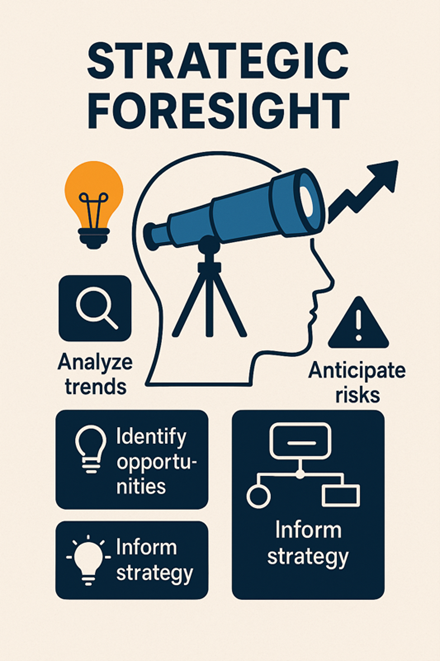
Many leaders are overwhelmed by the pace of technological advancement. Artificial intelligence, automation, climate technology, spatial computing, and digital trust are no longer abstract concepts. They are pressing realities that influence product pipelines, operational structures, and workforce models. Yet in the absence of structured foresight, leaders often fall into one of two traps. They either wait too long to act and fall behind, or they invest too early in trends that do not mature as expected. Strategic foresight provides a third path. It is a way of thinking that blends curiosity with discipline. It enables leaders to monitor change without being consumed by it.
Participants begin this chapter by understanding the difference between forecasting and foresight. Forecasting aims to predict what is likely. Foresight is about preparing for what is possible. Through tools such as PESTLE and STEEP analysis, environmental scanning, and horizon mapping, participants develop a deeper understanding of the external forces shaping their industries. These tools help frame conversations not around whether a particular outcome will occur, but around what an organization should do if it does.
The workshop emphasizes that foresight is not a solitary exercise. It is a participatory process that benefits from diverse perspectives. Leaders engage in structured scenario planning activities in which they explore alternative futures and stress test their current strategies against plausible shifts. These exercises allow participants to examine not just best case or worst-case projections, but a range of futures in between. One leader may explore the implications of tightening AI regulations in their sector. Another may model how geopolitical instability could impact supply chain resilience or customer expectations. Each scenario helps sharpen strategic thinking and surface assumptions that often go unchallenged.
This chapter also reinforces the importance of embedding foresight into daily leadership practices. It is not enough to conduct an annual strategy session and consider the work of future planning complete. Instead, leaders are encouraged to create rhythms of review and renewal. They learn how to establish internal foresight teams, create signal monitoring dashboards, and institutionalize reflection points into project governance cycles. These habits ensure that foresight becomes a source of agility rather than a static report.
Importantly, strategic foresight is not just about the organization. It is also a personal leadership capability. Participants reflect on how their own biases and preferences may limit how they perceive the future. They learn how to stay open to disruptive ideas while maintaining alignment with long-term purpose. They also explore the emotional dimension of foresight. Anticipating disruption requires courage. Acting on it requires confidence. Through coaching and peer dialogue, participants begin to develop a leadership presence that is calm, deliberate, and future aware.
By the end of this chapter, participants will be able to conduct structured foresight exercises within their own organizations. They will know how to identify the trends that matter most and frame those insights in a way that enables decision making rather than confusion. More than that, they will leave with the confidence to navigate ambiguity. They will understand that strategic foresight is not about predicting the future. It is about creating the conditions in which they and their teams can thrive no matter which future emerges.

Chapter 3: Aligning with Business Goals (ABG)
One of the most critical responsibilities of a technology leader is to ensure that innovation efforts do not exist in isolation. Technology should not operate as a silo or as an afterthought to business strategy. It must be intentionally aligned with the core priorities of the organization. This chapter focuses on building that bridge. Participants learn how to ensure that their technology vision supports enterprise-level goals, enhances business value, and advances both operational efficiency and long-term competitiveness.
Too often, digital initiatives lose momentum not because they lack technical soundness but because they fail to connect to what the business truly values. A team might launch a promising AI tool without clearly understanding how it supports revenue growth, customer satisfaction, or risk reduction. In other cases, technology leaders may struggle to translate highly technical opportunities into language that resonates with stakeholders from finance, marketing, or operations. This misalignment leads to underutilized investments, missed opportunities, and diminished influence at the executive table.
Participants begin this chapter by mapping their organization’s strategic objectives. Whether the enterprise is focused on market expansion, operational resilience, customer loyalty, or sustainability, technology leaders must internalize these goals before they can build alignment. The workshop introduces practical tools such as strategy canvases, business capability models, and value stream mapping. These frameworks help leaders trace the direct impact of technology initiatives on financial outcomes, customer experience, and competitive advantage.
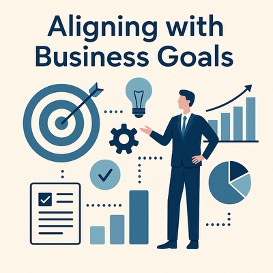
In parallel, participants develop skills to become translators between domains. Technology fluency is only half the equation. The ability to listen to the language of sales, product, legal, and human resources and frame technology strategy in terms of their goals is what distinguishes an aligned leader. Exercises include role reversals, pitch simulations, and cross-functional planning labs where leaders must advocate for technology priorities through a business lens.
The workshop also explores the dynamics of timing and sequencing. Alignment is not a one-time event. Strategic goals shift. Leadership priorities evolve. External conditions change. Participants learn how to continuously refresh their alignment efforts using quarterly recalibration cycles, integrated portfolio reviews, and agile roadmap updates. They are introduced to alignment rituals such as joint planning sessions, strategic retrospectives, and OKR co-creation workshops that embed collaboration into the DNA of execution.
Real-world examples reinforce the value of alignment. A regional bank that positioned cybersecurity investment as a brand differentiator. A healthcare system that linked patient engagement platforms to its mission of equitable care. A manufacturing firm that embedded analytics in its sustainability reporting. In each case, technology was not presented as a separate agenda. It became a lever for achieving business outcomes that mattered to the board, to employees, and to customers.
At a personal level, participants reflect on how well their current role supports business alignment. Are they seen as technical operators or strategic partners. What conversations are they invited into and which ones do they need to initiate. They begin to map their own credibility journey within the enterprise and identify where influence must be strengthened or reframed.
By the end of this chapter, participants will have a working plan to ensure that every technology initiative they lead can be traced to a strategic business priority. They will understand how to structure conversations, dashboards, and governance models that reinforce alignment over time. They will be able to show not only what technology can do, but why it matters to the success of the business. This ability to connect vision with value is what elevates a technology leader from contributor to strategist.

Chapter 4: Gap Analysis for Strategic Decision-Making (GSD)
For technology leaders to guide their organizations toward a bold strategic vision, they must first have a clear understanding of where they stand today. This requires more than intuition or high-level assessments. It demands a structured method for identifying the gaps between current capabilities and future goals. Gap analysis for strategic decision-making enables leaders to uncover blind spots, anticipate resistance, and prioritize investment with clarity and confidence. This chapter introduces participants to the tools and mindsets needed to make these assessments actionable.
Every organization has limitations. These may include outdated systems, fragmented data architectures, talent shortages, cultural resistance, regulatory constraints, or competing internal priorities. While most leaders are aware of some of these issues, very few have a structured approach for surfacing the full spectrum of challenges. Even fewer take the time to map those challenges against the vision they are trying to implement. Without this clarity, teams may pursue disconnected initiatives, misallocate resources, or stall progress because foundational gaps were never addressed.
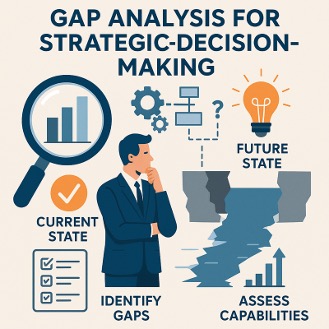
This chapter begins by introducing participants to diagnostic frameworks that help them systematically assess readiness across multiple domains. These include process maturity models, capability heat maps, stakeholder alignment matrices, and digital competency audits. Participants learn how to use these tools to conduct cross-functional interviews, survey key influencers, and gather insights from data sources that already exist within the organization. Rather than starting from scratch, the emphasis is on structuring what is already known and turning tacit understanding into strategic clarity.
Through group exercises and case study simulations, participants learn to differentiate between symptomatic issues and root causes. For example, low adoption of a new platform may reflect poor communication, inadequate training, or even a misalignment with real user needs. Similarly, delays in project delivery may stem from more than capacity problems. They may be the result of unclear prioritization or unresolved organizational tensions. By learning to ask the right questions and interpret both qualitative and quantitative data, participants sharpen their decision-making process.
The chapter also explores how to move from analysis to dialogue. Data alone does not create alignment. Leaders must use insights from gap analysis to engage in meaningful conversations with sponsors, partners, and affected teams. Participants learn how to frame findings in constructive ways that build trust and open pathways for collaboration. They also practice creating visual summaries that communicate urgency without blame. These summaries serve as bridges between strategic insight and operational action.
Real-world examples provide context for applying these tools. A telecommunications company that used a capability maturity model to realign product roadmaps. A university that mapped digital readiness across departments to drive unified technology adoption. A global nonprofit that identified a talent gap in data literacy and created an internal academy to address it. These cases demonstrate that gap analysis is not about pointing out weaknesses. It is about mobilizing the organization toward readiness and resilience.
The final part of this chapter emphasizes the leadership mindset required to approach gap analysis with empathy and rigor. Leaders reflect on their own comfort with complexity and uncertainty. They consider how to balance honesty with optimism when communicating gaps. They explore how to involve others in the diagnostic process so that insights are co-owned and more likely to result in shared action.
By the end of this chapter, participants will have built a toolkit for identifying and addressing the obstacles between vision and execution. They will know how to conduct strategic assessments that inform technology investment, team design, and change readiness. More importantly, they will understand that effective leadership does not begin with having all the answers. It begins with asking the right questions and creating the conditions for insight to emerge. Gap analysis is not a report. It is a leadership practice.

Chapter 5: Prioritizing Technology Initiatives (PTI)
Strategic vision without prioritized action is merely a statement of intent. To bring vision into reality, technology leaders must make deliberate choices about where to focus resources, attention, and effort. Prioritizing technology initiatives is not about choosing what is most exciting or most visible. It is about aligning investments with business value, organizational capacity, and long-term impact. This chapter equips participants with the decision-making frameworks, facilitation skills, and stakeholder engagement strategies necessary to establish a confident and transparent prioritization process.
In fast-moving environments, the number of potential initiatives often outpaces the resources available to pursue them. Example, Innovation teams’ surface emerging technologies, Product leaders propose new features, Operations departments request automation tools, and Leadership expects digital progress while maintaining core system stability. The result is a crowded portfolio, filled with overlapping ambitions and insufficient clarity about what matters most. Without a structured approach, prioritization becomes political. The loudest voices or most familiar problems consume attention, leaving little space for transformative efforts.
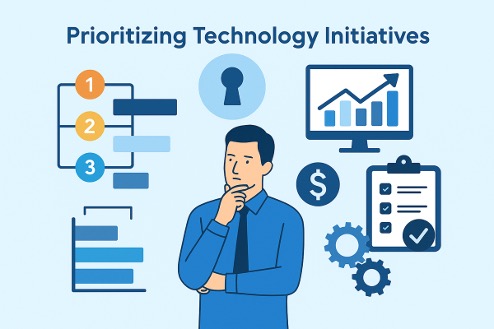
Participants begin this chapter by exploring how to define what value means in their specific organizational context. For some, value may be tied to revenue generation. For others, it may relate to risk reduction, customer experience, compliance, or sustainability. The workshop introduces weighted scoring models, cost versus impact grids, and benefit realization mapping as tools to make this value tangible. Participants use real-world scenarios to practice assigning relative importance to various outcomes, learning how to guide their teams toward consensus even when priorities conflict.
Equally important is the ability to evaluate feasibility. An initiative may be high value but may require capabilities that the organization does not yet possess. Participants assess readiness across dimensions such as technical complexity, data availability, workforce maturity, and cross-functional dependencies. These insights feed into balanced portfolio decisions, where quick wins and foundational investments coexist with longer horizon innovations.
The chapter emphasizes the need to communicate prioritization as a shared process, not a fixed outcome. Leaders are taught to engage stakeholders early and often. Prioritization workshops and collaborative backlog refinement sessions are introduced as methods to foster buy-in and surface hidden risks. Participants also learn how to tell the story of their decisions, framing trade-offs as intentional moves rather than unexplained delays. The result is greater transparency, reduced resistance, and a more resilient execution path.
Real-life examples highlight the power of effective prioritization. A regional energy provider rebalanced its digital roadmap after realizing that a low-profile analytics initiative would unlock insights across five departments. A public sector agency postponed a major system overhaul to invest first in data governance, enabling smoother transformation later. Technology startup integrated user feedback into its backlog process, improving customer satisfaction and feature adoption rates. These cases show that prioritization is not about doing less. It is about doing what matters most, with clarity and conviction.
The final section of the chapter explores how to revisit priorities over time. Conditions shift. New information emerges. What was urgent six months ago may now be irrelevant. Participants learn how to build adaptive planning rhythms, using quarterly reviews and strategic check-ins to update priorities in alignment with evolving business goals.
By the end of this chapter, participants will have a clear framework for evaluating technology opportunities based on strategic fit, impact, and feasibility. They will be prepared to lead prioritization conversations with confidence and empathy. More than that, they will understand how to create momentum through focused action. When everything is important, nothing moves. When priorities are clear, execution accelerates. This chapter ensures that leaders not only see the road ahead but know exactly where to begin.

Chapter 6: Scenario Planning for Agility (SPA)
In a world shaped by uncertainty, agility has become one of the most essential capabilities a technology leader can cultivate. Traditional planning models, which often rely on linear projections and fixed assumptions, are no longer sufficient. Markets shift, technologies evolve, and unforeseen disruptions emerge at a pace that defies prediction. Scenario planning offers an essential solution. It allows leaders to think in terms of multiple futures, challenge conventional thinking, and make decisions that are flexible and informed. This chapter immerses participants in the discipline of scenario planning and equips them to lead with confidence even when certainty is out of reach.
Scenario planning is not about forecasting what will happen. It is about preparing for what could happen. Participants learn how to move beyond single-point predictions and explore a range of plausible futures. The process begins by identifying critical uncertainties. These may include macroeconomic factors, regulatory changes, emerging technologies, societal shifts, or geopolitical risks. Participants then map out the drivers of change and explore how different combinations of those drivers may interact over time.
Using structured templates and guided facilitation, leaders build at least three divergent scenarios. One might describe a future in which AI becomes universally trusted and drives hyper automation. Another may envision a fragmented data landscape in which trust erodes, and governments impose heavy restrictions. A third could focus on a future where climate resilience becomes the dominant force shaping investment and innovation. Each scenario is designed to stretch thinking, surface blind spots, and spark dialogue about what readiness looks like in each possible future.
This chapter emphasizes that the goal of scenario planning is not just strategic imagination. It is practical application. Participants learn how to test their existing roadmaps, priorities, and capabilities against each scenario. They identify which strategies are robust across all futures and which are vulnerable. They also explore early warning signs that would signal which scenario is becoming more likely, allowing for proactive course correction. This process turns uncertainty into insight and reactivity into preparedness.
Participants also engage in role-based exercises where they simulate decision-making within different future states. A chief technology officer must allocate limited funds between cybersecurity and innovation in a scenario marked by economic contraction. A digital product manager must rethink a roadmap under a scenario where customer behaviors shift dramatically due to a global event. These simulations build comfort with ambiguity and teach participants how to anchor decisions in values and long-term goals rather than short-term pressure.

The chapter provides examples of how scenario planning has been applied in real organizations. A healthcare system used it to prepare for alternative regulatory futures, ensuring compliance readiness regardless of policy shifts. A financial institution used scenario narratives to assess risk exposure and stress-test digital transformation investments. A manufacturing company introduced scenario planning into quarterly planning to build resilience in its global supply chain. These stories demonstrate that scenario planning is not theoretical. It is a discipline that drives concrete action and enables long-term adaptability.
Participants also reflect on their own leadership posture in uncertain times. Do they tend to freeze, over-control, or default to past experience. Or can they stay grounded, engage with complexity, and invite others into generative exploration. The workshop provides tools for self-assessment and frameworks for leading scenario discussions with teams and stakeholders.
By the end of this chapter, participants will be able to facilitate basic scenario planning workshops, apply structured frameworks for assessing alternative futures, and incorporate scenario thinking into their regular strategic processes. They will be equipped not just to respond to change but to anticipate it. More importantly, they will build the leadership muscle required to navigate uncertainty with vision, empathy, and agility. Scenario planning is not a theoretical strategy tool. It is a way of thinking that turns disruption into design and complexity into clarity.

Chapter 7: Communicating a Strategic Vision (CSV)
A strategic vision only holds power if it is communicated effectively. Many leaders invest time and energy crafting a thoughtful vision statement, only to see it fall flat when shared with their teams. The words may be inspiring, but if they do not resonate, if they are not repeated, and if they are not reinforced across communication channels, the vision becomes invisible. This chapter addresses the communication gap that often stands between great ideas and lasting impact. It provides participants with the tools, structures, and techniques needed to communicate vision in a way that is clear, engaging, and memorable.
At the heart of this module is the understanding that communication is not a one-time event. It is a continuous process. Participants learn that strategic communication must move beyond formal presentations and top-down announcements. Vision must be embedded into conversations, rituals, decisions, and behaviors. The message should be consistent, but the format and emphasis should vary depending on audience, timing, and context. This level of intentionality transforms vision from an idea into a shared belief system.

The workshop begins with an exploration of common communication pitfalls. Leaders often overestimate how clearly they have communicated because they focus on what they said rather than what others heard. Participants examine case studies of well-meaning vision statements that failed due to jargon, lack of clarity, or disconnect from the listener’s reality. They learn to spot abstract language, identify assumptions, and rewrite messages using language that connects to specific aspirations, concerns, and goals.
Participants are introduced to narrative frameworks that help structure complex ideas into stories that stick. The Hero’s Journey is one such structure. It frames the vision as a collective challenge, inviting the organization to move from the current state to a transformed future. This structure builds emotional engagement by highlighting the stakes, showing the path, and recognizing the contributions of others along the way. The three-act structure is also explored as a way to guide listeners from problem to possibility to resolution.
A significant part of this chapter focuses on audience mapping. Participants identify internal and external stakeholder groups who must understand, support, or act on the vision. Each group has different concerns, motivations, and language preferences. A board of directors may want to see how the vision supports growth and risk mitigation. Frontline teams may want to understand how it affects their day-to-day work. Participants learn to tailor content while preserving the integrity of the message.
Real-world examples illustrate successful communication strategies. A public transportation agency used community storytelling to engage riders in its digital modernization plan. A global consumer brand created a visual cascade map that allowed each function to see how their work aligned with the enterprise vision. A technology services firm created a rotating storytelling circle where leaders and team members co-presented how the strategic vision was taking shape in real projects. These examples show that the most powerful messages are not delivered. They are co-created.
In addition to structure and tone, the chapter addresses medium and cadence. Participants explore how to use visual tools, metaphors, and formats such as town halls, dashboards, newsletters, and informal conversations to reinforce the vision over time. They also learn to select messengers who carry credibility with each audience segment and to embed the vision into onboarding, performance conversations, and recognition moments.
By the end of this chapter, participants will have built a communication plan tailored to their organizational landscape. They will have written and refined key messages, test narratives, and developed a sequence for rollout and reinforcement. More importantly, they will understand that vision is not just what you say. It is what people remember, repeat, and believe. Communicating a strategic vision requires clarity, empathy, and consistency. It is a leadership discipline that transforms ideas into movements and plans into momentum.

Chapter 8: Measuring Strategic Success (MSS)
A strategic vision gains credibility not just through inspiration but through evidence. Without mechanisms for measuring progress, even the most powerful vision can drift into abstraction. Leaders must be able to show whether their strategies are working, where they are gaining traction, and where adjustments are needed. Measurement is more than accountability. It is the bridge between intention and results. This chapter equips participants with the frameworks, tools, and mindsets necessary to define success, track progress, and use data to inform both decision-making and storytelling.
The challenge many leaders face is not a lack of data but an overabundance of it. Dashboards overflow with metrics, yet few truly reflect the long-term outcomes that matter. Participants begin this chapter by reflecting on what success means in their specific context. For some, it may be market expansion or increased customer loyalty. For others, it may be improved internal collaboration, reduced risk, or accelerated time to market. Clarifying the connection between vision and measurable outcomes is the first step in building a meaningful measurement strategy.
Participants are introduced to measurement frameworks that distinguish between leading and lagging indicators. Leading indicators provide early signals of progress and enable course correction. Lagging indicators confirm outcomes after they have occurred. Both are important. Participants explore how to define indicators that are relevant, reliable, and tied directly to their strategic goals. Examples include tracking adoption rates for a new platform, measuring engagement levels during a cultural transformation, or using customer lifetime value to assess the impact of a product strategy.
In addition to selecting indicators, participants learn how to establish clear baselines and performance thresholds. A metric only has meaning when compared to something. Participants use goal setting tools such as OKRs and KPIs to articulate targets, thresholds, and stretch outcomes. They explore how to balance quantitative data with qualitative feedback to create a full picture of progress. One example involves a technology leader using NPS alongside internal sentiment analysis to evaluate the success of a new service model.
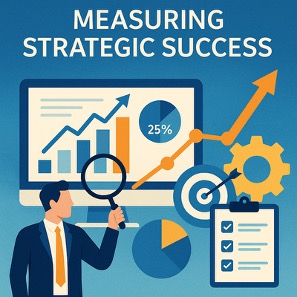
The chapter also introduces scorecards and visual communication tools that make data accessible and actionable. Participants learn how to design executive dashboards that highlight trends, not just snapshots. They explore methods for creating team-level scorecards that build ownership and visibility. Case studies include a digital team that used a weekly momentum report to surface blockers and celebrate small wins. Another example features a nonprofit that used a visual impact map to communicate how each project contributed to long-term strategic outcomes.
Importantly, participants learn how to use measurement not just for validation but for learning. When a target is missed, it becomes a prompt for inquiry rather than blame. Leaders are coached on how to foster a culture of data-informed experimentation, where failure provides feedback and metrics support reflection. This mindset helps shift conversations from compliance to capability building.
Participants also examine the political dimensions of measurement. Metrics can shape narratives, influence funding, and affect reputations. Leaders are encouraged to consider who controls the data, how it is interpreted, and how to ensure transparency without oversimplification. By navigating these dynamics thoughtfully, they increase both the credibility and integrity of their measurement systems.
By the end of this chapter, participants will be able to define success in concrete terms, build aligned metrics at multiple levels, and communicate progress with clarity. They will understand that measurement is not a passive act. It is an active leadership behavior. One that signals priorities, reinforces culture, and enables agility. Strategic success is not just about reaching a goal. It is about creating a system that tracks momentum, invites learning, and supports the realization of vision over time.

Chapter 9: Leadership & Cultural Alignment (LCA)
Strategic vision does not thrive in isolation. It is sustained through people, systems, behaviors, and values that reflect and reinforce that vision every day. Without cultural alignment, even the most well-crafted strategy will stall. People may hear the message but not believe it. They may understand the roadmap but not feel ownership of the destination. This chapter focuses on how leaders shape culture deliberately to support strategic execution. It helps participants understand how culture forms, how it can be shifted, and how leadership behavior either accelerates or obstructs alignment.
Culture is often described as the way things are done around here. It is built from the accumulation of shared experiences, implicit rules, and visible behaviors. It can support agility or resist change. It can spark innovation or slow progress. For technology leaders in particular, cultural alignment is essential. Digital transformation requires not just new tools but new mindsets. Cross-functional collaboration, customer-centricity, data literacy, and experimentation all depend on cultural cues. Leaders must learn to recognize those cues and guide them toward the desired future state.
Participants begin this chapter by assessing the current state of culture in their organization. Using tools such as culture mapping, behavioral diagnostics, and employee feedback loops, they gain a clearer picture of how people experience the organization at all levels. They analyze alignment between stated values and actual behaviors, looking for gaps that weaken trust or undermine momentum. For example, an organization may claim to value innovation but discourage risk taking. It may promote collaboration but reward siloed performance. These contradictions erode alignment and must be addressed.
This chapter introduces a framework for culture shaping based on visible behaviors, embedded rituals, and consistent reinforcement. Participants explore how leadership presence, team norms, decision making processes, and language all contribute to cultural signals. They learn how to model the behaviors they want to see and how to cascade those behaviors through their teams. A leader who consistently invites dissent, shares vulnerability, and celebrates learning from failure can create a ripple effect across an entire function.
The workshop highlights case studies from organizations that successfully shifted culture to support a new strategic direction. A media company that democratized access to data to increase transparency and empowerment. A healthcare system that created frontline innovation labs to bring culture change closer to service delivery. A financial firm that changed its promotion criteria to include collaboration and mentorship, not just technical achievement. These examples demonstrate that culture change is not abstract. It is tangible, deliberate, and leader led.

Participants also reflect on their own role as culture carriers. They examine how their behavior is interpreted by others and how to align their actions with the culture they wish to create. They consider how to influence upward, across, and downward in ways that reinforce shared values. They learn how to build coalitions, engage informal influencers, and use storytelling to make cultural ideals feel real.
The final component of this chapter explores how to sustain alignment over time. Culture work is not a one-time effort. It requires rituals, reinforcement, and refreshment. Participants learn how to embed culture into onboarding, performance reviews, leadership development, and recognition programs. They explore how to measure cultural alignment and how to use those insights to recalibrate when needed.
By the end of this chapter, participants will have a practical plan to align culture with strategy. They will know how to shape mindsets, shift behaviors, and signal priorities through daily leadership actions. More importantly, they will understand that leadership is not just about driving outcomes. It is about shaping the environment where those outcomes become possible. Culture is not something leaders observe. It is something they create. When culture and strategy move together, transformation becomes not only possible but sustainable.

Chapter 10: Execution & Roadmap Development (ERD)
A compelling vision gains its full power only when it is translated into consistent execution. The most inspiring strategies risk irrelevance if they do not move into action, produce measurable outcomes, and evolve through learning. In this final chapter, participants focus on bridging the gap between strategy and delivery. They explore how to design roadmaps that inspire confidence, allocate resources effectively, and adapt in real time to changing conditions. This is not about project management in the traditional sense. It is about designing a strategic path that connects people, priorities, and performance across the organization.
Participants begin by reflecting on the purpose of a roadmap. A roadmap is more than a list of projects or a timeline of releases. It is a visual narrative that communicates intent, builds alignment, and invites commitment. It provides structure without rigidity and direction without micromanagement. When crafted well, a roadmap helps teams see where they are going, why it matters, and how their work contributes to something larger.
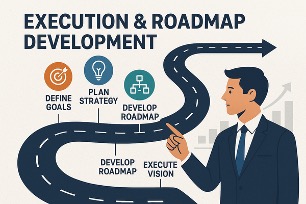
The workshop introduces multiple approaches to roadmap development. These include theme-based planning, outcome-driven sequencing, capability building phases, and layered time horizons. Participants learn to group initiatives not just by function but by strategic purpose. For example, one layer of the roadmap may focus on technology infrastructure, another on customer value, and a third on culture or talent development. These layers allow leaders to balance foundational investments with visible quick wins and transformative bets.
Participants engage in exercises where they construct draft roadmaps for their own initiatives. They explore how to use backlogs, milestones, and dependency mapping to bring order to complexity. Special attention is paid to identifying blockers early, assigning clear ownership, and building in capacity for iteration. The goal is not to create a perfect plan but a living framework that can evolve as conditions change.
The chapter also emphasizes the importance of stakeholder engagement during execution. Leaders learn how to frame the roadmap not just as a technical plan but as a leadership tool. They develop communication strategies to align sponsors, inform cross-functional teams, and motivate execution partners. Case studies show how regular review rituals, transparent progress tracking, and visible wins can reinforce momentum and build trust.
Real-world examples bring these principles to life. A national logistics firm created a customer journey roadmap that aligned product, engineering, and marketing around common outcomes. A digital health startup built a modular platform roadmap that allowed new features to be prioritized as user feedback evolved. A government technology office used public-facing roadmaps to increase accountability and community engagement. In each case, execution succeeded not because of perfect planning but because of responsive leadership and shared commitment.
Participants also reflect on their role as roadmap stewards. They examine how to sustain focus without becoming rigid, how to respond to disruption without losing direction, and how to keep long-term vision visible even amid day-to-day demands. Tools such as retrospectives, sprint reviews, and quarterly recalibration sessions are introduced to help leaders remain adaptive without drifting.
By the end of this chapter, participants will have developed a strategic roadmap that brings their vision into reality. They will know how to sequence work across time, align execution with purpose, and communicate progress with credibility. Most importantly, they will understand that execution is not separate from vision. It is the way vision becomes real. Leadership is not only about where you are going. It is about how you get there. Roadmaps ensure that the journey is intentional, inclusive, and capable of delivering meaningful results.
Curriculum
Technology Leadership – Workshop 1 – Strategic Vision
- Strategic Vision (SV)
- Strategic Foresight (SF)
- Aligning with Business Goals (ABG)
- Gap Analysis for Strategic Decision-Making (GSD)
- Prioritizing Technology Initiatives (PTI)
- Scenario Planning for Agility (SPA)
- Communicating a Strategic Vision (CSV)
- Measuring Strategic Success (MSS)
- Leadership & Cultural Alignment (LCA)
- Execution & Roadmap Development (ERD)
Distance Learning
Introduction
Welcome to Appleton Greene and thank you for enrolling on the Technology Leadership corporate training program. You will be learning through our unique facilitation via distance-learning method, which will enable you to practically implement everything that you learn academically. The methods and materials used in your program have been designed and developed to ensure that you derive the maximum benefits and enjoyment possible. We hope that you find the program challenging and fun to do. However, if you have never been a distance-learner before, you may be experiencing some trepidation at the task before you. So we will get you started by giving you some basic information and guidance on how you can make the best use of the modules, how you should manage the materials and what you should be doing as you work through them. This guide is designed to point you in the right direction and help you to become an effective distance-learner. Take a few hours or so to study this guide and your guide to tutorial support for students, while making notes, before you start to study in earnest.
Study environment
You will need to locate a quiet and private place to study, preferably a room where you can easily be isolated from external disturbances or distractions. Make sure the room is well-lit and incorporates a relaxed, pleasant feel. If you can spoil yourself within your study environment, you will have much more of a chance to ensure that you are always in the right frame of mind when you do devote time to study. For example, a nice fire, the ability to play soft soothing background music, soft but effective lighting, perhaps a nice view if possible and a good size desk with a comfortable chair. Make sure that your family know when you are studying and understand your study rules. Your study environment is very important. The ideal situation, if at all possible, is to have a separate study, which can be devoted to you. If this is not possible then you will need to pay a lot more attention to developing and managing your study schedule, because it will affect other people as well as yourself. The better your study environment, the more productive you will be.
Study tools & rules
Try and make sure that your study tools are sufficient and in good working order. You will need to have access to a computer, scanner and printer, with access to the internet. You will need a very comfortable chair, which supports your lower back, and you will need a good filing system. It can be very frustrating if you are spending valuable study time trying to fix study tools that are unreliable, or unsuitable for the task. Make sure that your study tools are up to date. You will also need to consider some study rules. Some of these rules will apply to you and will be intended to help you to be more disciplined about when and how you study. This distance-learning guide will help you and after you have read it you can put some thought into what your study rules should be. You will also need to negotiate some study rules for your family, friends or anyone who lives with you. They too will need to be disciplined in order to ensure that they can support you while you study. It is important to ensure that your family and friends are an integral part of your study team. Having their support and encouragement can prove to be a crucial contribution to your successful completion of the program. Involve them in as much as you can.
Successful distance-learning
Distance-learners are freed from the necessity of attending regular classes or workshops, since they can study in their own way, at their own pace and for their own purposes. But unlike traditional internal training courses, it is the student’s responsibility, with a distance-learning program, to ensure that they manage their own study contribution. This requires strong self-discipline and self-motivation skills and there must be a clear will to succeed. Those students who are used to managing themselves, are good at managing others and who enjoy working in isolation, are more likely to be good distance-learners. It is also important to be aware of the main reasons why you are studying and of the main objectives that you are hoping to achieve as a result. You will need to remind yourself of these objectives at times when you need to motivate yourself. Never lose sight of your long-term goals and your short-term objectives. There is nobody available here to pamper you, or to look after you, or to spoon-feed you with information, so you will need to find ways to encourage and appreciate yourself while you are studying. Make sure that you chart your study progress, so that you can be sure of your achievements and re-evaluate your goals and objectives regularly.
Self-assessment
Appleton Greene training programs are in all cases post-graduate programs. Consequently, you should already have obtained a business-related degree and be an experienced learner. You should therefore already be aware of your study strengths and weaknesses. For example, which time of the day are you at your most productive? Are you a lark or an owl? What study methods do you respond to the most? Are you a consistent learner? How do you discipline yourself? How do you ensure that you enjoy yourself while studying? It is important to understand yourself as a learner and so some self-assessment early on will be necessary if you are to apply yourself correctly. Perform a SWOT analysis on yourself as a student. List your internal strengths and weaknesses as a student and your external opportunities and threats. This will help you later on when you are creating a study plan. You can then incorporate features within your study plan that can ensure that you are playing to your strengths, while compensating for your weaknesses. You can also ensure that you make the most of your opportunities, while avoiding the potential threats to your success.
Accepting responsibility as a student
Training programs invariably require a significant investment, both in terms of what they cost and in the time that you need to contribute to study and the responsibility for successful completion of training programs rests entirely with the student. This is never more apparent than when a student is learning via distance-learning. Accepting responsibility as a student is an important step towards ensuring that you can successfully complete your training program. It is easy to instantly blame other people or factors when things go wrong. But the fact of the matter is that if a failure is your failure, then you have the power to do something about it, it is entirely in your own hands. If it is always someone else’s failure, then you are powerless to do anything about it. All students study in entirely different ways, this is because we are all individuals and what is right for one student, is not necessarily right for another. In order to succeed, you will have to accept personal responsibility for finding a way to plan, implement and manage a personal study plan that works for you. If you do not succeed, you only have yourself to blame.
Planning
By far the most critical contribution to stress, is the feeling of not being in control. In the absence of planning we tend to be reactive and can stumble from pillar to post in the hope that things will turn out fine in the end. Invariably they don’t! In order to be in control, we need to have firm ideas about how and when we want to do things. We also need to consider as many possible eventualities as we can, so that we are prepared for them when they happen. Prescriptive Change, is far easier to manage and control, than Emergent Change. The same is true with distance-learning. It is much easier and much more enjoyable, if you feel that you are in control and that things are going to plan. Even when things do go wrong, you are prepared for them and can act accordingly without any unnecessary stress. It is important therefore that you do take time to plan your studies properly.
Management
Once you have developed a clear study plan, it is of equal importance to ensure that you manage the implementation of it. Most of us usually enjoy planning, but it is usually during implementation when things go wrong. Targets are not met and we do not understand why. Sometimes we do not even know if targets are being met. It is not enough for us to conclude that the study plan just failed. If it is failing, you will need to understand what you can do about it. Similarly if your study plan is succeeding, it is still important to understand why, so that you can improve upon your success. You therefore need to have guidelines for self-assessment so that you can be consistent with performance improvement throughout the program. If you manage things correctly, then your performance should constantly improve throughout the program.
Study objectives & tasks
The first place to start is developing your program objectives. These should feature your reasons for undertaking the training program in order of priority. Keep them succinct and to the point in order to avoid confusion. Do not just write the first things that come into your head because they are likely to be too similar to each other. Make a list of possible departmental headings, such as: Customer Service; E-business; Finance; Globalization; Human Resources; Technology; Legal; Management; Marketing and Production. Then brainstorm for ideas by listing as many things that you want to achieve under each heading and later re-arrange these things in order of priority. Finally, select the top item from each department heading and choose these as your program objectives. Try and restrict yourself to five because it will enable you to focus clearly. It is likely that the other things that you listed will be achieved if each of the top objectives are achieved. If this does not prove to be the case, then simply work through the process again.
Study forecast
As a guide, the Appleton Greene Technology Leadership corporate training program should take 12-18 months to complete, depending upon your availability and current commitments. The reason why there is such a variance in time estimates is because every student is an individual, with differing productivity levels and different commitments. These differentiations are then exaggerated by the fact that this is a distance-learning program, which incorporates the practical integration of academic theory as an as a part of the training program. Consequently all of the project studies are real, which means that important decisions and compromises need to be made. You will want to get things right and will need to be patient with your expectations in order to ensure that they are. We would always recommend that you are prudent with your own task and time forecasts, but you still need to develop them and have a clear indication of what are realistic expectations in your case. With reference to your time planning: consider the time that you can realistically dedicate towards study with the program every week; calculate how long it should take you to complete the program, using the guidelines featured here; then break the program down into logical modules and allocate a suitable proportion of time to each of them, these will be your milestones; you can create a time plan by using a spreadsheet on your computer, or a personal organizer such as MS Outlook, you could also use a financial forecasting software; break your time forecasts down into manageable chunks of time, the more specific you can be, the more productive and accurate your time management will be; finally, use formulas where possible to do your time calculations for you, because this will help later on when your forecasts need to change in line with actual performance. With reference to your task planning: refer to your list of tasks that need to be undertaken in order to achieve your program objectives; with reference to your time plan, calculate when each task should be implemented; remember that you are not estimating when your objectives will be achieved, but when you will need to focus upon implementing the corresponding tasks; you also need to ensure that each task is implemented in conjunction with the associated training modules which are relevant; then break each single task down into a list of specific to do’s, say approximately ten to do’s for each task and enter these into your study plan; once again you could use MS Outlook to incorporate both your time and task planning and this could constitute your study plan; you could also use a project management software like MS Project. You should now have a clear and realistic forecast detailing when you can expect to be able to do something about undertaking the tasks to achieve your program objectives.
Performance management
It is one thing to develop your study forecast, it is quite another to monitor your progress. Ultimately it is less important whether you achieve your original study forecast and more important that you update it so that it constantly remains realistic in line with your performance. As you begin to work through the program, you will begin to have more of an idea about your own personal performance and productivity levels as a distance-learner. Once you have completed your first study module, you should re-evaluate your study forecast for both time and tasks, so that they reflect your actual performance level achieved. In order to achieve this you must first time yourself while training by using an alarm clock. Set the alarm for hourly intervals and make a note of how far you have come within that time. You can then make a note of your actual performance on your study plan and then compare your performance against your forecast. Then consider the reasons that have contributed towards your performance level, whether they are positive or negative and make a considered adjustment to your future forecasts as a result. Given time, you should start achieving your forecasts regularly.
With reference to time management: time yourself while you are studying and make a note of the actual time taken in your study plan; consider your successes with time-efficiency and the reasons for the success in each case and take this into consideration when reviewing future time planning; consider your failures with time-efficiency and the reasons for the failures in each case and take this into consideration when reviewing future time planning; re-evaluate your study forecast in relation to time planning for the remainder of your training program to ensure that you continue to be realistic about your time expectations. You need to be consistent with your time management, otherwise you will never complete your studies. This will either be because you are not contributing enough time to your studies, or you will become less efficient with the time that you do allocate to your studies. Remember, if you are not in control of your studies, they can just become yet another cause of stress for you.
With reference to your task management: time yourself while you are studying and make a note of the actual tasks that you have undertaken in your study plan; consider your successes with task-efficiency and the reasons for the success in each case; take this into consideration when reviewing future task planning; consider your failures with task-efficiency and the reasons for the failures in each case and take this into consideration when reviewing future task planning; re-evaluate your study forecast in relation to task planning for the remainder of your training program to ensure that you continue to be realistic about your task expectations. You need to be consistent with your task management, otherwise you will never know whether you are achieving your program objectives or not.
Keeping in touch
You will have access to qualified and experienced professors and tutors who are responsible for providing tutorial support for your particular training program. So don’t be shy about letting them know how you are getting on. We keep electronic records of all tutorial support emails so that professors and tutors can review previous correspondence before considering an individual response. It also means that there is a record of all communications between you and your professors and tutors and this helps to avoid any unnecessary duplication, misunderstanding, or misinterpretation. If you have a problem relating to the program, share it with them via email. It is likely that they have come across the same problem before and are usually able to make helpful suggestions and steer you in the right direction. To learn more about when and how to use tutorial support, please refer to the Tutorial Support section of this student information guide. This will help you to ensure that you are making the most of tutorial support that is available to you and will ultimately contribute towards your success and enjoyment with your training program.
Work colleagues and family
You should certainly discuss your program study progress with your colleagues, friends and your family. Appleton Greene training programs are very practical. They require you to seek information from other people, to plan, develop and implement processes with other people and to achieve feedback from other people in relation to viability and productivity. You will therefore have plenty of opportunities to test your ideas and enlist the views of others. People tend to be sympathetic towards distance-learners, so don’t bottle it all up in yourself. Get out there and share it! It is also likely that your family and colleagues are going to benefit from your labors with the program, so they are likely to be much more interested in being involved than you might think. Be bold about delegating work to those who might benefit themselves. This is a great way to achieve understanding and commitment from people who you may later rely upon for process implementation. Share your experiences with your friends and family.
Making it relevant
The key to successful learning is to make it relevant to your own individual circumstances. At all times you should be trying to make bridges between the content of the program and your own situation. Whether you achieve this through quiet reflection or through interactive discussion with your colleagues, client partners or your family, remember that it is the most important and rewarding aspect of translating your studies into real self-improvement. You should be clear about how you want the program to benefit you. This involves setting clear study objectives in relation to the content of the course in terms of understanding, concepts, completing research or reviewing activities and relating the content of the modules to your own situation. Your objectives may understandably change as you work through the program, in which case you should enter the revised objectives on your study plan so that you have a permanent reminder of what you are trying to achieve, when and why.
Distance-learning check-list
Prepare your study environment, your study tools and rules.
Undertake detailed self-assessment in terms of your ability as a learner.
Create a format for your study plan.
Consider your study objectives and tasks.
Create a study forecast.
Assess your study performance.
Re-evaluate your study forecast.
Be consistent when managing your study plan.
Use your Appleton Greene Certified Learning Provider (CLP) for tutorial support.
Make sure you keep in touch with those around you.

Tutorial Support
Programs
Appleton Greene uses standard and bespoke corporate training programs as vessels to transfer business process improvement knowledge into the heart of our clients’ organizations. Each individual program focuses upon the implementation of a specific business process, which enables clients to easily quantify their return on investment. There are hundreds of established Appleton Greene corporate training products now available to clients within customer services, e-business, finance, globalization, human resources, information technology, legal, management, marketing and production. It does not matter whether a client’s employees are located within one office, or an unlimited number of international offices, we can still bring them together to learn and implement specific business processes collectively. Our approach to global localization enables us to provide clients with a truly international service with that all important personal touch. Appleton Greene corporate training programs can be provided virtually or locally and they are all unique in that they individually focus upon a specific business function. They are implemented over a sustainable period of time and professional support is consistently provided by qualified learning providers and specialist consultants.
Support available
You will have a designated Certified Learning Provider (CLP) and an Accredited Consultant and we encourage you to communicate with them as much as possible. In all cases tutorial support is provided online because we can then keep a record of all communications to ensure that tutorial support remains consistent. You would also be forwarding your work to the tutorial support unit for evaluation and assessment. You will receive individual feedback on all of the work that you undertake on a one-to-one basis, together with specific recommendations for anything that may need to be changed in order to achieve a pass with merit or a pass with distinction and you then have as many opportunities as you may need to re-submit project studies until they meet with the required standard. Consequently the only reason that you should really fail (CLP) is if you do not do the work. It makes no difference to us whether a student takes 12 months or 18 months to complete the program, what matters is that in all cases the same quality standard will have been achieved.
Support Process
Please forward all of your future emails to the designated (CLP) Tutorial Support Unit email address that has been provided and please do not duplicate or copy your emails to other AGC email accounts as this will just cause unnecessary administration. Please note that emails are always answered as quickly as possible but you will need to allow a period of up to 20 business days for responses to general tutorial support emails during busy periods, because emails are answered strictly within the order in which they are received. You will also need to allow a period of up to 30 business days for the evaluation and assessment of project studies. This does not include weekends or public holidays. Please therefore kindly allow for this within your time planning. All communications are managed online via email because it enables tutorial service support managers to review other communications which have been received before responding and it ensures that there is a copy of all communications retained on file for future reference. All communications will be stored within your personal (CLP) study file here at Appleton Greene throughout your designated study period. If you need any assistance or clarification at any time, please do not hesitate to contact us by forwarding an email and remember that we are here to help. If you have any questions, please list and number your questions succinctly and you can then be sure of receiving specific answers to each and every query.
Time Management
It takes approximately 1 Year to complete the Technology Leadership corporate training program, incorporating 12 x 6-hour monthly workshops. Each student will also need to contribute approximately 4 hours per week over 1 Year of their personal time. Students can study from home or work at their own pace and are responsible for managing their own study plan. There are no formal examinations and students are evaluated and assessed based upon their project study submissions, together with the quality of their internal analysis and supporting documents. They can contribute more time towards study when they have the time to do so and can contribute less time when they are busy. All students tend to be in full time employment while studying and the Technology Leadership program is purposely designed to accommodate this, so there is plenty of flexibility in terms of time management. It makes no difference to us at Appleton Greene, whether individuals take 12-18 months to complete this program. What matters is that in all cases the same standard of quality will have been achieved with the standard and bespoke programs that have been developed.
Distance Learning Guide
The distance learning guide should be your first port of call when starting your training program. It will help you when you are planning how and when to study, how to create the right environment and how to establish the right frame of mind. If you can lay the foundations properly during the planning stage, then it will contribute to your enjoyment and productivity while training later. The guide helps to change your lifestyle in order to accommodate time for study and to cultivate good study habits. It helps you to chart your progress so that you can measure your performance and achieve your goals. It explains the tools that you will need for study and how to make them work. It also explains how to translate academic theory into practical reality. Spend some time now working through your distance learning guide and make sure that you have firm foundations in place so that you can make the most of your distance learning program. There is no requirement for you to attend training workshops or classes at Appleton Greene offices. The entire program is undertaken online, program course manuals and project studies are administered via the Appleton Greene web site and via email, so you are able to study at your own pace and in the comfort of your own home or office as long as you have a computer and access to the internet.
How To Study
The how to study guide provides students with a clear understanding of the Appleton Greene facilitation via distance learning training methods and enables students to obtain a clear overview of the training program content. It enables students to understand the step-by-step training methods used by Appleton Greene and how course manuals are integrated with project studies. It explains the research and development that is required and the need to provide evidence and references to support your statements. It also enables students to understand precisely what will be required of them in order to achieve a pass with merit and a pass with distinction for individual project studies and provides useful guidance on how to be innovative and creative when developing your Unique Program Proposition (UPP).
Tutorial Support
Tutorial support for the Appleton Greene Technology Leadership corporate training program is provided online either through the Appleton Greene Client Support Portal (CSP), or via email. All tutorial support requests are facilitated by a designated Program Administration Manager (PAM). They are responsible for deciding which professor or tutor is the most appropriate option relating to the support required and then the tutorial support request is forwarded onto them. Once the professor or tutor has completed the tutorial support request and answered any questions that have been asked, this communication is then returned to the student via email by the designated Program Administration Manager (PAM). This enables all tutorial support, between students, professors and tutors, to be facilitated by the designated Program Administration Manager (PAM) efficiently and securely through the email account. You will therefore need to allow a period of up to 20 business days for responses to general support queries and up to 30 business days for the evaluation and assessment of project studies, because all tutorial support requests are answered strictly within the order in which they are received. This does not include weekends or public holidays. Consequently you need to put some thought into the management of your tutorial support procedure in order to ensure that your study plan is feasible and to obtain the maximum possible benefit from tutorial support during your period of study. Please retain copies of your tutorial support emails for future reference. Please ensure that ALL of your tutorial support emails are set out using the format as suggested within your guide to tutorial support. Your tutorial support emails need to be referenced clearly to the specific part of the course manual or project study which you are working on at any given time. You also need to list and number any questions that you would like to ask, up to a maximum of five questions within each tutorial support email. Remember the more specific you can be with your questions the more specific your answers will be too and this will help you to avoid any unnecessary misunderstanding, misinterpretation, or duplication. The guide to tutorial support is intended to help you to understand how and when to use support in order to ensure that you get the most out of your training program. Appleton Greene training programs are designed to enable you to do things for yourself. They provide you with a structure or a framework and we use tutorial support to facilitate students while they practically implement what they learn. In other words, we are enabling students to do things for themselves. The benefits of distance learning via facilitation are considerable and are much more sustainable in the long-term than traditional short-term knowledge sharing programs. Consequently you should learn how and when to use tutorial support so that you can maximize the benefits from your learning experience with Appleton Greene. This guide describes the purpose of each training function and how to use them and how to use tutorial support in relation to each aspect of the training program. It also provides useful tips and guidance with regard to best practice.
Tutorial Support Tips
Students are often unsure about how and when to use tutorial support with Appleton Greene. This Tip List will help you to understand more about how to achieve the most from using tutorial support. Refer to it regularly to ensure that you are continuing to use the service properly. Tutorial support is critical to the success of your training experience, but it is important to understand when and how to use it in order to maximize the benefit that you receive. It is no coincidence that those students who succeed are those that learn how to be positive, proactive and productive when using tutorial support.
Be positive and friendly with your tutorial support emails
Remember that if you forward an email to the tutorial support unit, you are dealing with real people. “Do unto others as you would expect others to do unto you”. If you are positive, complimentary and generally friendly in your emails, you will generate a similar response in return. This will be more enjoyable, productive and rewarding for you in the long-term.
Think about the impression that you want to create
Every time that you communicate, you create an impression, which can be either positive or negative, so put some thought into the impression that you want to create. Remember that copies of all tutorial support emails are stored electronically and tutors will always refer to prior correspondence before responding to any current emails. Over a period of time, a general opinion will be arrived at in relation to your character, attitude and ability. Try to manage your own frustrations, mood swings and temperament professionally, without involving the tutorial support team. Demonstrating frustration or a lack of patience is a weakness and will be interpreted as such. The good thing about communicating in writing, is that you will have the time to consider your content carefully, you can review it and proof-read it before sending your email to Appleton Greene and this should help you to communicate more professionally, consistently and to avoid any unnecessary knee-jerk reactions to individual situations as and when they may arise. Please also remember that the CLP Tutorial Support Unit will not just be responsible for evaluating and assessing the quality of your work, they will also be responsible for providing recommendations to other learning providers and to client contacts within the Appleton Greene global client network, so do be in control of your own emotions and try to create a good impression.
Remember that quality is preferred to quantity
Please remember that when you send an email to the tutorial support team, you are not using Twitter or Text Messaging. Try not to forward an email every time that you have a thought. This will not prove to be productive either for you or for the tutorial support team. Take time to prepare your communications properly, as if you were writing a professional letter to a business colleague and make a list of queries that you are likely to have and then incorporate them within one email, say once every month, so that the tutorial support team can understand more about context, application and your methodology for study. Get yourself into a consistent routine with your tutorial support requests and use the tutorial support template provided with ALL of your emails. The (CLP) Tutorial Support Unit will not spoon-feed you with information. They need to be able to evaluate and assess your tutorial support requests carefully and professionally.
Be specific about your questions in order to receive specific answers
Try not to write essays by thinking as you are writing tutorial support emails. The tutorial support unit can be unclear about what in fact you are asking, or what you are looking to achieve. Be specific about asking questions that you want answers to. Number your questions. You will then receive specific answers to each and every question. This is the main purpose of tutorial support via email.
Keep a record of your tutorial support emails
It is important that you keep a record of all tutorial support emails that are forwarded to you. You can then refer to them when necessary and it avoids any unnecessary duplication, misunderstanding, or misinterpretation.
Individual training workshops or telephone support
Please be advised that Appleton Greene does not provide separate or individual tutorial support meetings, workshops, or provide telephone support for individual students. Appleton Greene is an equal opportunities learning and service provider and we are therefore understandably bound to treat all students equally. We cannot therefore broker special financial or study arrangements with individual students regardless of the circumstances. All tutorial support is provided online and this enables Appleton Greene to keep a record of all communications between students, professors and tutors on file for future reference, in accordance with our quality management procedure and your terms and conditions of enrolment. All tutorial support is provided online via email because it enables us to have time to consider support content carefully, it ensures that you receive a considered and detailed response to your queries. You can number questions that you would like to ask, which relate to things that you do not understand or where clarification may be required. You can then be sure of receiving specific answers to each individual query. You will also then have a record of these communications and of all tutorial support, which has been provided to you. This makes tutorial support administration more productive by avoiding any unnecessary duplication, misunderstanding, or misinterpretation.
Tutorial Support Email Format
You should use this tutorial support format if you need to request clarification or assistance while studying with your training program. Please note that ALL of your tutorial support request emails should use the same format. You should therefore set up a standard email template, which you can then use as and when you need to. Emails that are forwarded to Appleton Greene, which do not use the following format, may be rejected and returned to you by the (CLP) Program Administration Manager. A detailed response will then be forwarded to you via email usually within 20 business days of receipt for general support queries and 30 business days for the evaluation and assessment of project studies. This does not include weekends or public holidays. Your tutorial support request, together with the corresponding TSU reply, will then be saved and stored within your electronic TSU file at Appleton Greene for future reference.
Subject line of your email
Please insert: Appleton Greene (CLP) Tutorial Support Request: (Your Full Name) (Date), within the subject line of your email.
Main body of your email
Please insert:
1. Appleton Greene Certified Learning Provider (CLP) Tutorial Support Request
2. Your Full Name
3. Date of TS request
4. Preferred email address
5. Backup email address
6. Course manual page name or number (reference)
7. Project study page name or number (reference)
Subject of enquiry
Please insert a maximum of 50 words (please be succinct)
Briefly outline the subject matter of your inquiry, or what your questions relate to.
Question 1
Maximum of 50 words (please be succinct)
Maximum of 50 words (please be succinct)
Question 3
Maximum of 50 words (please be succinct)
Question 4
Maximum of 50 words (please be succinct)
Question 5
Maximum of 50 words (please be succinct)
Please note that a maximum of 5 questions is permitted with each individual tutorial support request email.
Procedure
* List the questions that you want to ask first, then re-arrange them in order of priority. Make sure that you reference them, where necessary, to the course manuals or project studies.
* Make sure that you are specific about your questions and number them. Try to plan the content within your emails to make sure that it is relevant.
* Make sure that your tutorial support emails are set out correctly, using the Tutorial Support Email Format provided here.
* Save a copy of your email and incorporate the date sent after the subject title. Keep your tutorial support emails within the same file and in date order for easy reference.
* Allow up to 20 business days for a response to general tutorial support emails and up to 30 business days for the evaluation and assessment of project studies, because detailed individual responses will be made in all cases and tutorial support emails are answered strictly within the order in which they are received.
* Emails can and do get lost. So if you have not received a reply within the appropriate time, forward another copy or a reminder to the tutorial support unit to be sure that it has been received but do not forward reminders unless the appropriate time has elapsed.
* When you receive a reply, save it immediately featuring the date of receipt after the subject heading for easy reference. In most cases the tutorial support unit replies to your questions individually, so you will have a record of the questions that you asked as well as the answers offered. With project studies however, separate emails are usually forwarded by the tutorial support unit, so do keep a record of your own original emails as well.
* Remember to be positive and friendly in your emails. You are dealing with real people who will respond to the same things that you respond to.
* Try not to repeat questions that have already been asked in previous emails. If this happens the tutorial support unit will probably just refer you to the appropriate answers that have already been provided within previous emails.
* If you lose your tutorial support email records you can write to Appleton Greene to receive a copy of your tutorial support file, but a separate administration charge may be levied for this service.

How To Study
Your Certified Learning Provider (CLP) and Accredited Consultant can help you to plan a task list for getting started so that you can be clear about your direction and your priorities in relation to your training program. It is also a good way to introduce yourself to the tutorial support team.
Planning your study environment
Your study conditions are of great importance and will have a direct effect on how much you enjoy your training program. Consider how much space you will have, whether it is comfortable and private and whether you are likely to be disturbed. The study tools and facilities at your disposal are also important to the success of your distance-learning experience. Your tutorial support unit can help with useful tips and guidance, regardless of your starting position. It is important to get this right before you start working on your training program.
Planning your program objectives
It is important that you have a clear list of study objectives, in order of priority, before you start working on your training program. Your tutorial support unit can offer assistance here to ensure that your study objectives have been afforded due consideration and priority.
Planning how and when to study
Distance-learners are freed from the necessity of attending regular classes, since they can study in their own way, at their own pace and for their own purposes. This approach is designed to let you study efficiently away from the traditional classroom environment. It is important however, that you plan how and when to study, so that you are making the most of your natural attributes, strengths and opportunities. Your tutorial support unit can offer assistance and useful tips to ensure that you are playing to your strengths.
Planning your study tasks
You should have a clear understanding of the study tasks that you should be undertaking and the priority associated with each task. These tasks should also be integrated with your program objectives. The distance learning guide and the guide to tutorial support for students should help you here, but if you need any clarification or assistance, please contact your tutorial support unit.
Planning your time
You will need to allocate specific times during your calendar when you intend to study if you are to have a realistic chance of completing your program on time. You are responsible for planning and managing your own study time, so it is important that you are successful with this. Your tutorial support unit can help you with this if your time plan is not working.
Keeping in touch
Consistency is the key here. If you communicate too frequently in short bursts, or too infrequently with no pattern, then your management ability with your studies will be questioned, both by you and by your tutorial support unit. It is obvious when a student is in control and when one is not and this will depend how able you are at sticking with your study plan. Inconsistency invariably leads to in-completion.
Charting your progress
Your tutorial support team can help you to chart your own study progress. Refer to your distance learning guide for further details.
Making it work
To succeed, all that you will need to do is apply yourself to undertaking your training program and interpreting it correctly. Success or failure lies in your hands and your hands alone, so be sure that you have a strategy for making it work. Your Certified Learning Provider (CLP) and Accredited Consultant can guide you through the process of program planning, development and implementation.
Reading methods
Interpretation is often unique to the individual but it can be improved and even quantified by implementing consistent interpretation methods. Interpretation can be affected by outside interference such as family members, TV, or the Internet, or simply by other thoughts which are demanding priority in our minds. One thing that can improve our productivity is using recognized reading methods. This helps us to focus and to be more structured when reading information for reasons of importance, rather than relaxation.
Speed reading
When reading through course manuals for the first time, subconsciously set your reading speed to be just fast enough that you cannot dwell on individual words or tables. With practice, you should be able to read an A4 sheet of paper in one minute. You will not achieve much in the way of a detailed understanding, but your brain will retain a useful overview. This overview will be important later on and will enable you to keep individual issues in perspective with a more generic picture because speed reading appeals to the memory part of the brain. Do not worry about what you do or do not remember at this stage.
Content reading
Once you have speed read everything, you can then start work in earnest. You now need to read a particular section of your course manual thoroughly, by making detailed notes while you read. This process is called Content Reading and it will help to consolidate your understanding and interpretation of the information that has been provided.
Making structured notes on the course manuals
When you are content reading, you should be making detailed notes, which are both structured and informative. Make these notes in a MS Word document on your computer, because you can then amend and update these as and when you deem it to be necessary. List your notes under three headings: 1. Interpretation – 2. Questions – 3. Tasks. The purpose of the 1st section is to clarify your interpretation by writing it down. The purpose of the 2nd section is to list any questions that the issue raises for you. The purpose of the 3rd section is to list any tasks that you should undertake as a result. Anyone who has graduated with a business-related degree should already be familiar with this process.
Organizing structured notes separately
You should then transfer your notes to a separate study notebook, preferably one that enables easy referencing, such as a MS Word Document, a MS Excel Spreadsheet, a MS Access Database, or a personal organizer on your cell phone. Transferring your notes allows you to have the opportunity of cross-checking and verifying them, which assists considerably with understanding and interpretation. You will also find that the better you are at doing this, the more chance you will have of ensuring that you achieve your study objectives.
Question your understanding
Do challenge your understanding. Explain things to yourself in your own words by writing things down.
Clarifying your understanding
If you are at all unsure, forward an email to your tutorial support unit and they will help to clarify your understanding.
Question your interpretation
Do challenge your interpretation. Qualify your interpretation by writing it down.
Clarifying your interpretation
If you are at all unsure, forward an email to your tutorial support unit and they will help to clarify your interpretation.
Qualification Requirements
The student will need to successfully complete the project study and all of the exercises relating to the Technology Leadership corporate training program, achieving a pass with merit or distinction in each case, in order to qualify as an Accredited Technology Leadership Specialist (ATLS). All monthly workshops need to be tried and tested within your company. These project studies can be completed in your own time and at your own pace and in the comfort of your own home or office. There are no formal examinations, assessment is based upon the successful completion of the project studies. They are called project studies because, unlike case studies, these projects are not theoretical, they incorporate real program processes that need to be properly researched and developed. The project studies assist us in measuring your understanding and interpretation of the training program and enable us to assess qualification merits. All of the project studies are based entirely upon the content within the training program and they enable you to integrate what you have learnt into your corporate training practice.
Technology Leadership – Grading Contribution
Project Study – Grading Contribution
Customer Service – 10%
E-business – 05%
Finance – 10%
Globalization – 10%
Human Resources – 10%
Information Technology – 10%
Legal – 05%
Management – 10%
Marketing – 10%
Production – 10%
Education – 05%
Logistics – 05%
TOTAL GRADING – 100%
Qualification grades
A mark of 90% = Pass with Distinction.
A mark of 75% = Pass with Merit.
A mark of less than 75% = Fail.
If you fail to achieve a mark of 75% with a project study, you will receive detailed feedback from the Certified Learning Provider (CLP) and/or Accredited Consultant, together with a list of tasks which you will need to complete, in order to ensure that your project study meets with the minimum quality standard that is required by Appleton Greene. You can then re-submit your project study for further evaluation and assessment. Indeed you can re-submit as many drafts of your project studies as you need to, until such a time as they eventually meet with the required standard by Appleton Greene, so you need not worry about this, it is all part of the learning process.
When marking project studies, Appleton Greene is looking for sufficient evidence of the following:
Pass with merit
A satisfactory level of program understanding
A satisfactory level of program interpretation
A satisfactory level of project study content presentation
A satisfactory level of Unique Program Proposition (UPP) quality
A satisfactory level of the practical integration of academic theory
Pass with distinction
An exceptional level of program understanding
An exceptional level of program interpretation
An exceptional level of project study content presentation
An exceptional level of Unique Program Proposition (UPP) quality
An exceptional level of the practical integration of academic theory
Preliminary Analysis

The Technology Leadership course requires participants to first understand and reflect on their current capabilities, organizational context, and the strategic challenges they face. This preliminary analysis is an essential preparatory step designed to ensure participants effectively engage with the strategic content of the course.
Preliminary Readings
Participants are encouraged to engage with foundational readings from prominent thought leaders and experts in technology leadership and strategy. Although not mandatory, these resources will significantly enhance participants’ ability to contribute actively during the workshops by providing essential insights and a broader perspective on strategic technology management. Recommended foundational readings include:
Books:
• Blue Ocean Strategy, by W. Chan Kim and Renée Mauborgne
• Measure What Matters, by John Doerr
• The Innovator’s Dilemma, by Clayton Christensen
• Leading Digital: Turning Technology into Business Transformation, by George Westerman, Didier Bonnet, and Andrew McAfee
• Digital Transformation: Survive and Thrive in an Era of Mass Extinction, by Thomas M. Siebel
• The Technology Fallacy: How People Are the Real Key to Digital Transformation, by Gerald C. Kane et al.
• Competing in the Age of AI, by Marco Lansiti and Karim R. Lakhani
• The Fourth Industrial Revolution, by Klaus Schwab
• Digital to the Core, by Mark Raskino and Graham Waller
• Platform Revolution, by Geoffrey Parker, Marshall Van Alstyne, and Sangeet Paul Choudary

Research Articles and Reports:
• Why Digital Transformations Fail: Closing the $900 Billion Hole, Forbes Insights.
• Gartner CIO Agenda (Annual Report), Gartner.
• Deloitte Tech Trends (Annual Report), Deloitte.
• Accelerating Digital Transformation, by Tom Puthiyamadam, PwC Insights.
• Digital Transformation: A Roadmap for Billion-Dollar Organizations, MIT Sloan Management Review.
• Embracing Agile, Darrell Rigby, Jeff Sutherland, and Hirotaka Takeuchi, Harvard Business Review.
• The Nine Elements of Digital Transformation, Westerman, Bonnet, and McAfee, MIT Sloan Management Review.
• Scaling Agile @ Spotify, Henrik Kniberg and Anders Ivarsson, Spotify Engineering Culture.
• Leading Through Digital Disruption, Jacques Bughin and Nicolas van Zeebroeck, McKinsey Quarterly.
• Strategy in the Age of Digital Disruption, Michael Porter and James Heppelmann, Harvard Business Review.

Skills and Contextual Self-Assessment
Participants should conduct a reflective self-assessment addressing key strategic areas to gain clarity on their current competencies, capabilities, and challenges:
Knowledge: Reflect on the strategic leadership frameworks and technological trends with which you are familiar. Document formal training, certifications, or education relevant to technology management and strategic leadership.
Know-how: Evaluate which strategic methodologies and frameworks (e.g., agile methodologies, strategic foresight, scenario planning) you have implemented or experienced within your organization. Identify specific examples and lessons learned from successful or unsuccessful strategic technology initiatives.
Organizational Context: Describe your current organizational structure, culture, and approach to technology leadership and innovation. Clearly outline the primary technological challenges or barriers facing your organization today, focusing on issues such as resistance to change, technology adoption, or strategic alignment gaps.

Outcome of Preliminary Analysis
Through thoughtful engagement with these readings and assessments, participants will gain essential insights into their strategic strengths, areas for improvement, and a comprehensive understanding of current industry practices. This enriched analysis provides a robust foundation, enabling participants to engage meaningfully with course materials and ensuring a personalized, contextually relevant learning experience tailored to their organizational and professional contexts.
Course Manuals 1-10
Technology leadership in today’s rapidly evolving landscape requires a clear and actionable strategic vision. Leaders must navigate emerging trends such as artificial intelligence, IoT, cloud computing, and blockchain while ensuring alignment with business objectives. The “Strategic Vision” workshop provides participants with frameworks to develop and communicate an effective technology vision that fosters innovation and long-term growth.

Course Manual 1: Strategic Vision (SV)
Introduction
In the evolving landscape of global business and technology, the role of a technology leader has shifted dramatically from being an operational manager to becoming a strategic architect of the organization’s future. Vision is no longer a luxury. It is a necessity. In times of ambiguity and rapid change, a clearly defined strategic vision acts as a compass. It provides direction when certainty is not available. It unifies stakeholders who may have different priorities. And it inspires resilience when the road ahead is unpredictable. In this first module of the Technology Leadership Program, we focus on building this foundational capability. Participants will learn what it means to craft a strategic vision that is bold, relevant, and grounded in both foresight and feasibility.
Strategic vision is often misunderstood as a mission statement or a high-level ambition that lives on a slide deck. In reality, it is a leadership discipline. It is the ability to look forward with clarity and to translate that view into a set of organizing principles that guide decisions, investments, and actions. Technology leaders who succeed in this domain are those who understand the context in which they operate, who know how to balance external trends with internal capabilities, and who can communicate a future state that others believe in and want to help create.
This module begins by challenging participants to rethink what vision actually means. They will examine how vision differs from mission, goals, and tactical objectives. A mission defines purpose. Goals define outcomes. Tactics define actions. Vision defines where we are going and why that destination matters. It is the anchor for long-term thinking. It is the starting point for prioritization, and it is the thread that connects innovation with enterprise value.
The need for strong vision has never been more urgent. Organizations today are navigating unprecedented complexity. Emerging technologies such as artificial intelligence, spatial computing, and blockchain are reshaping every industry. Market expectations are accelerating. Geopolitical shifts are altering supply chains and risk landscapes. Stakeholders are demanding that companies take stands on social and environmental issues. In this context, leaders who cannot offer a compelling vision will struggle to build trust and align action.
Participants in this module will explore the challenges and opportunities of vision building through multiple lenses. They will engage in environmental scanning exercises to identify the external drivers that shape their industry. They will learn how to use foresight tools such as STEEP and PESTLE analysis to anticipate disruptions and prepare for multiple futures. They will conduct internal readiness assessments to understand the capabilities and gaps that influence their strategic options. And they will use structured vision frameworks to draft initial vision statements that can be tested and refined.
The module also emphasizes the human dimension of vision. A vision is not just a set of words. It is a message that must be communicated in a way that resonates emotionally and intellectually. Leaders must learn to tell the story of their vision. They must make it relevant to different audiences. They must embed it into conversations, decisions, and behaviors so that it becomes part of the organizational culture. Participants will learn how to craft compelling narratives using storytelling frameworks such as the Hero’s Journey. They will explore how vision is reinforced through rituals, leadership presence, and communication cadence.
Case studies from technology firms, public sector agencies, healthcare systems, and global enterprises are used throughout the module to show how vision building plays out in real-world contexts. Participants will examine how successful leaders framed their strategic narratives, how they gained alignment, and how they turned abstract goals into tangible momentum. These stories serve as both inspiration and instruction. They demonstrate that vision is not a soft skill. It is a strategic asset that drives transformation.
Another focus of the module is the dynamic nature of vision. A strategic vision is not fixed. It must evolve as new information becomes available, as markets shift, and as the organization learns. Leaders must build feedback loops that allow them to listen to signals, assess relevance, and adjust without losing coherence. Participants will learn how to keep vision alive through periodic refresh, transparent recalibration, and open dialogue.
By engaging with this module, participants will begin to shift their leadership identity. They will see themselves not only as problem solvers but as possibility architects. They will learn that vision is not about certainty. It is about clarity of intent. They will gain confidence in speaking about the future, even when that future is uncertain. They will practice aligning teams around long-term goals while maintaining short-term agility.
The exercises and discussions in this module are designed to be both reflective and practical. Participants will have the opportunity to assess their current leadership presence and its alignment with their strategic intent. They will explore what holds them back from leading with vision. They will receive peer feedback on how their vision is perceived. And they will create a first draft of a vision statement that reflects their leadership aspirations and their organizational context.
This module also sets the tone for the rest of the Technology Leadership Program. Every subsequent topic build upon the foundation of strategic vision. Without a clear vision, foresight is directionless. Without a vision, priorities become reactive. Without a vision, communication loses coherence. Vision is the seed from which strategy grows. It is the energy source that activates leadership.
In summary, this introduction to strategic vision is not only about developing a deliverable. It is about becoming a different kind of leader. One who can see beyond the noise. One who can connect ideas with purpose. One who can lead with courage, clarity, and compassion. Strategic vision requires discipline, imagination, and commitment. It requires leaders to step back from the busyness of daily execution and ask deeper questions about meaning, direction, and impact. The work is not easy, but it is essential.
Participants will leave this module with a renewed sense of direction and the practical tools to make that direction visible to others. They will be prepared to guide their teams and organizations into the future not with fear or hesitation but with vision. Strategic vision is where leadership begins. It is the signature trait of leaders who not only manage change but shape it. It transforms uncertainty into opportunity and confusion into clarity. Above all, it connects today’s actions to tomorrow’s outcomes, ensuring that technology leaders act not just as builders of systems but as stewards of the future.
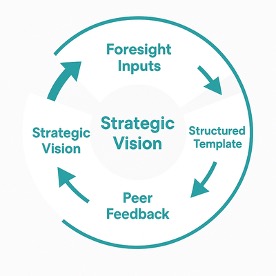
Learning Objectives
By the end of this module, participants will be able to define a strategic technology vision that is tightly aligned with their organization’s mission, market realities, and long-term objectives. They will be able to analyze both internal capabilities and external forces to identify the most relevant drivers shaping strategic direction. This includes evaluating customer needs, regulatory pressures, emerging technologies, and shifting economic or political landscapes. Participants will gain a nuanced understanding of what makes vision statements effective and enduring, including characteristics such as clarity, specificity, ambition, and relevance. They will study examples from different sectors and learn how to assess whether a vision merely sounds good or genuinely supports transformative leadership.
Throughout the module, participants will be guided through exercises that help them draft and refine their own strategic vision statement using structured templates that translate high-level thinking into actionable and communicable language. These frameworks support participants in moving from abstract ambitions to clearly articulated commitments. As part of this process, participants will learn how to tailor their message to resonate with different audiences including executives, cross-functional teams, and external stakeholders. They will consider the tone, timing, and channel of delivery to ensure the message achieves both emotional and cognitive impact. This communication lens is reinforced through storytelling techniques and strategic narrative design.
Additionally, participants will strengthen their ability to differentiate between mission, vision, goals, and values. They will learn to place their vision at the center of decision-making, using it to guide prioritization, investment planning, and team engagement. Through case studies and peer feedback, they will build confidence in articulating their vision and defending its rationale. Ultimately, participants will walk away with not just a vision statement but a leadership tool they can apply to drive alignment, shape culture, and guide long-term innovation. This module ensures that participants are equipped with both the conceptual understanding and the practical capabilities to lead with strategic vision in complex, high-stakes environments.
Content Overview
This module is structured around five integrated components that progressively develop participants’ ability to create and communicate a strategic vision. Each component builds upon the last, equipping leaders with a complete toolkit for vision creation and execution. The approach blends theory, analysis, storytelling, and practical application, enabling technology leaders to develop a well-rounded vision strategy that is both compelling and actionable.
The first component is Understanding Strategic Vision. Participants begin by exploring the defining features of effective vision statements. These include clarity, ambition, alignment, and relevance. Clarity ensures that the vision is not lost in abstraction but communicates a clear direction. Ambition elevates the statement beyond operational tasks to transformative outcomes. Alignment guarantees the vision supports business goals and reflects the organization’s purpose. Relevance ensures that the vision speaks to the present challenges and future aspirations of all stakeholders. Participants learn how vision differs from mission, values, and tactical planning. While a mission defines why the organization exists, and values define how people behave, vision defines where the organization is heading and what impact it aims to achieve. Through group analysis, participants examine how technology leaders have used vision to guide resource allocation, inspire innovation, and unify distributed teams. They analyze model statements such as enabling small businesses to thrive through intelligent automation, transforming education through immersive digital learning, or empowering global health through decentralized diagnostics. These examples demonstrate how vision can serve as both a directional guide and a unifying force for change.
The second component focuses on Environmental Scanning and Strategic Foresight. To ensure their vision is future-ready, participants are introduced to foresight tools such as STEEP and PESTLE analysis. STEEP examines five categories of external drivers: Social, Technological, Economic, Environmental, and Political. For instance, a fintech organization might consider youth financial literacy under social drivers, blockchain adoption under technology, fluctuating interest rates under economics, the rise of green investments under environmental factors, and evolving fintech regulations under political influences. PESTLE extends this by incorporating Legal and Ethical dimensions. A telehealth startup might evaluate how regional data privacy regulations affect their compliance strategy and whether their AI diagnostic tools meet ethical standards of fairness and transparency. These tools help participants anticipate external disruptions, validate the assumptions behind their vision, and proactively identify trends that may accelerate or threaten progress. By engaging in these scanning exercises, participants learn how to think critically about external forces and refine their vision to account for both challenges and opportunities that lie ahead.
The third component of the module introduces Vision Creation Frameworks. With the insights gathered from environmental scanning, participants begin drafting their strategic vision statements using structured templates. These frameworks guide participants in transforming complex aspirations into concise and memorable language. Some common templates include statements such as to achieve a strategic purpose by enabling a specific condition for a defined target audience or envisioning a future where an aspirational outcome is made possible through a core technology capability. Another template focuses on empowerment, such as empowering users to achieve transformational goals using a particular platform or strategy. Participants draft and refine these statements using peer feedback sessions that simulate the kinds of iterative conversations required to gain alignment with leadership teams. They are encouraged to develop a core statement along with variations that are audience specific. For example, one version may be tailored for the executive board, another for team members, and another for customers or partners. This component emphasizes that clarity and adaptability are not mutually exclusive. A strong vision statement must be memorable, but it must also translate across different touchpoints.
The fourth component is Organizational Readiness and Gap Analysis. A powerful vision must be grounded in a realistic understanding of the organization’s current state. Participants conduct an internal scan across four core pillars: infrastructure, talent and skills, governance and agility, and data and systems. They compare their current capabilities to the demands of the envisioned future. For example, if a vision involves a shift to real-time customer analytics, but current data architecture is fragmented and siloed, that gap must be addressed as a priority. Through structured self-assessment tools, participants identify critical capability gaps and begin forming initiative roadmaps to close them. The gap analysis also includes evaluating organizational culture, leadership alignment, and operational readiness. By understanding where misalignments exist, leaders can better sequence their actions, allocate resources effectively, and build momentum behind their vision. Participants also learn how to communicate these gaps constructively, framing them not as failures but as opportunities for targeted investment and strategic development.
The final component is Communicating Vision that Sticks. Crafting a strong vision is only the beginning. Without strategic communication, even the best vision will remain inert. Participants learn how to deliver their vision in a way that is clear, consistent, relevant, and emotionally compelling. Clarity involves avoiding jargon and using simple language. Consistency involves repeating the message across channels, decisions, and leadership behaviors. Relevance means linking the vision to the concerns and goals of different stakeholders. Emotional resonance means telling stories that inspire belief and participation. To support this, the module introduces the Hero’s Journey, a storytelling framework popularized by Joseph Campbell. This narrative arc is ideal for communicating strategic transformation.
The Hero’s Journey begins with the Ordinary World, which describes the current state or status quo. This is followed by the Call to Adventure, when a challenge or opportunity emerges. The Crossing of the Threshold signifies the organization’s commitment to transformation. Along the journey, there are Tests, Allies, and Enemies, which represent internal resistance, unexpected complications, and the need for partnership. The Transformation is the breakthrough moment when a new capability or mindset emerges. Finally, the Return with the Elixir symbolizes how this transformation creates value not only for the team or department but for the entire organization or ecosystem.
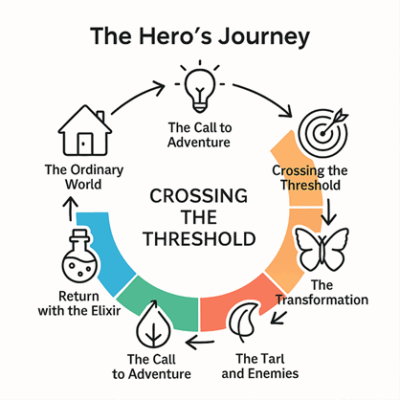 Participants practice mapping their vision stories to this framework. They identify the starting point, the turning point, the key moments of resistance and resolve, and the final value delivered. One example used in the workshop involves a healthtech company that began as a legacy system provider. During the pandemic, the company faced a dramatic shift in demand for remote patient care. They committed to transforming their platform and culture, overcoming initial skepticism and infrastructure constraints. Eventually, they piloted a successful telehealth model and began sharing best practices with other institutions. This story maps directly onto the Hero’s Journey. It provides a clear, emotional, and strategic narrative that reinforces the company’s broader vision.
Participants practice mapping their vision stories to this framework. They identify the starting point, the turning point, the key moments of resistance and resolve, and the final value delivered. One example used in the workshop involves a healthtech company that began as a legacy system provider. During the pandemic, the company faced a dramatic shift in demand for remote patient care. They committed to transforming their platform and culture, overcoming initial skepticism and infrastructure constraints. Eventually, they piloted a successful telehealth model and began sharing best practices with other institutions. This story maps directly onto the Hero’s Journey. It provides a clear, emotional, and strategic narrative that reinforces the company’s broader vision.
By the end of this module, participants will not only understand how to write a vision. They will know how to ground it in foresight, test it against organizational reality, communicate it across audiences, and adapt it as conditions evolve. Vision is not a slide. It is a living force. This module gives leaders the frameworks and confidence to let that force move their organizations forward. They will also recognize that vision requires sustained commitment and leadership modeling. Leaders must consistently reinforce the vision through the choices they make and the stories they tell. This includes aligning project portfolios with long-term aspirations, designing team rituals that echo vision themes, and recognizing individuals who embody the change narrative. Ultimately, participants will leave with a deeper belief that strategic vision is not just about the future. It is about making the future tangible in the present, through aligned decisions, courageous conversations, and shared direction.

Case Study: Patagonia’s Strategic Vision and Sustainable Innovation
Patagonia, the outdoor apparel company founded in 1973, is globally recognized for its unwavering commitment to environmental responsibility and ethical business practices. At the heart of its long-term success lies a powerful and consistent strategic vision:
“We’re in business to save our home planet.”
Unlike many mission statements that are aspirational but disconnected from business operations, Patagonia’s vision is deeply embedded in every facet of the organization—from product design and supply chain decisions to marketing campaigns and corporate governance.
Defining a Vision Beyond Profit
Patagonia, the outdoor apparel company founded in 1973 by Yvon Chouinard, has become a benchmark for values-based business and sustainable innovation. Its strategic vision, “We’re in business to save our home planet” is more than a tagline. It is a guiding principle that has reshaped product design, supply chain operations, internal culture, and governance. This case study explores the transformation of Patagonia through the lens of strategic vision development and execution, offering a detailed roadmap for embedding purpose into the DNA of an organization.
In the early years, Patagonia’s focus was on building high-quality outdoor gear. However, the leadership quickly realized that their business model, if left unchecked, could negatively impact the very environment their customers sought to enjoy. This recognition became the catalyst for redefining the company’s direction. The shift began with small, symbolic moves such as switching from conventional to organic cotton, even at a higher cost and logistical complexity. These early experiments laid the foundation for a larger strategy that would span decades.
By the 1990s, Patagonia moved into what can be described as a strategic structuring phase. Leadership commissioned a comprehensive product lifecycle audit, identifying environmental hotspots across their value chain. Based on the findings, the company launched the Common Threads Initiative, urging customers to reduce, reuse, and recycle. The initiative included programs such as Worn Wear, which encouraged customers to repair and extend the life of their garments, reducing overall consumption. Around this time, Patagonia also began donating 1% of sales to grassroots environmental causes, formalizing this commitment by becoming a founding member of “1% for the Planet.”
The next phase focused on cultural activation. Patagonia sought to make its vision not just a strategic north star, but a part of the daily work experience of every employee. Activism training became part of employee onboarding. Values such as “cause no unnecessary harm” and “use business to inspire solutions to the environmental crisis” were incorporated into performance reviews, hiring processes, and team rituals. Employees were encouraged—and in some cases even funded—to participate in environmental protests. The culture was empowered, not imposed, and reflected a deep alignment between internal behavior and external messaging.
One of the most defining moments came in 2022, when Yvon Chouinard transferred 100% of the company’s voting stock to a trust designed to preserve Patagonia’s values. All future profits—estimated at around $100 million annually—would go toward climate action and environmental causes. This governance innovation ensured that the vision would be protected in perpetuity, regardless of future leadership changes.
Throughout this journey, Patagonia used several tools to guide its decisions. One was the STEEP framework—Social, Technological, Economic, Environmental, and Political analysis. Socially, there was a rising demand for ethical products. Technologically, innovations in traceability enabled Patagonia to verify sustainable sourcing. Economically, customers were willing to pay a premium for purpose-driven brands. Environmentally, the climate crisis was growing urgent. Politically, regulations around waste and carbon emissions were increasing. These insights informed key moves, such as investing in regenerative agriculture and publishing supply chain transparency reports.
Patagonia also mastered the use of narrative in communicating vision. Borrowing from the Hero’s Journey framework, the company positioned itself as a rebel in a broken system—challenging fast fashion, corporate greed, and planned obsolescence. Campaigns like “Don’t Buy This Jacket” during Black Friday drew attention not just for their shock value but because they made the customer a co-conspirator in a mission to reduce consumption.
Strategic vision was reinforced through performance metrics. Patagonia developed a dashboard that included the percentage of recycled materials in its products, customer retention and Net Promoter Scores, and CO2 emissions per unit. These metrics were not hidden in annual reports—they were made accessible to employees, customers, and the public to build trust and accountability.
What made Patagonia’s vision stick was the consistency of its execution. The message was simple and bold. The leadership took symbolic and structural actions to demonstrate sincerity. The vision was embedded into governance, operations, customer interactions, and employee culture. It became both a strategic differentiator and a cultural glue.
Patagonia’s clear strategic vision helped it achieve lasting differentiation in a competitive industry. Financially, the company has remained profitable and resilient despite economic downturns. Operationally, it has built a circular model that encourages durability, reusability, and reduced waste. Culturally, it has one of the most engaged workforces in its sector, with extremely low employee turnover. From a societal impact perspective, Patagonia has mobilized millions of dollars for environmental causes and influenced industry-wide sustainability standards.
leaders can learn from Patagonia’s approach to vision by recognizing that a strong strategic vision is not an abstract concept—it’s a lever for innovation, culture, and competitive advantage. Vision must be specific, values-driven, and continuously reinforced through systems, storytelling, and structures. It should inform which technologies to adopt, which metrics to measure, and how to build trust with internal and external stakeholders. By aligning every operational decision with a compelling purpose, leaders can build adaptive, future-proof organizations with clear strategic intent. The Patagonia case is a reminder that vision is the blueprint for transformation—and when executed consistently, it becomes a force multiplier across the enterprise.
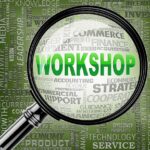
Group Exercise: Strategic Vision Workshop
Develop a clear and actionable strategic vision aligned with organizational goals.
As a group, list your organization’s:
Top 2 strategic priorities
One key challenge or opportunity technology could address
Step 2: Select One Key Trend
Pick one critical technology trend (e.g., AI, cybersecurity) impacting your industry. Briefly discuss its potential impact using just two factors from PESTLE (Political, Economic, Social, Technological, Legal, Environmental).
Step 3: Craft Your Vision Statement
Together, draft a simple and inspiring strategic vision statement using the format:
“We exist to [impact] by [action] for [audience].”
Ensure it clearly aligns with your identified priorities and trend.
Confirm the vision is clear, actionable, and motivating for your stakeholders.
Summary
This foundational module equips technology leaders with the essential skills to create, communicate, and implement a compelling strategic vision. Participants learn rigorous foresight methodologies, tools like STEEP and PESTLE, and frameworks such as the Hero’s Journey to craft impactful narratives. Through in-depth case studies, including Patagonia’s sustainable innovation journey, leaders understand how vision drives alignment, resilience, and differentiation. The module concludes with practical exercises to embed vision into actionable strategies, ensuring organizations can anticipate disruption, inspire teams, and confidently navigate future opportunities.

Course Manual 2: Strategic Foresight (SF)
Introduction
In an era marked by exponential change, strategic foresight is no longer a leadership luxury. It is an essential capacity. As emerging technologies reshape entire sectors, customer expectations shift at unprecedented speed, and systemic risks increase in both frequency and complexity, leaders must move beyond reactive planning. They must embrace a mindset of anticipation, resilience, and adaptability. Strategic foresight empowers leaders not just to cope with change but to position themselves and their organizations ahead of it. This module is designed to equip technology and business leaders with the frameworks, tools, and cognitive flexibility required to navigate uncertainty and to proactively shape their preferred futures.
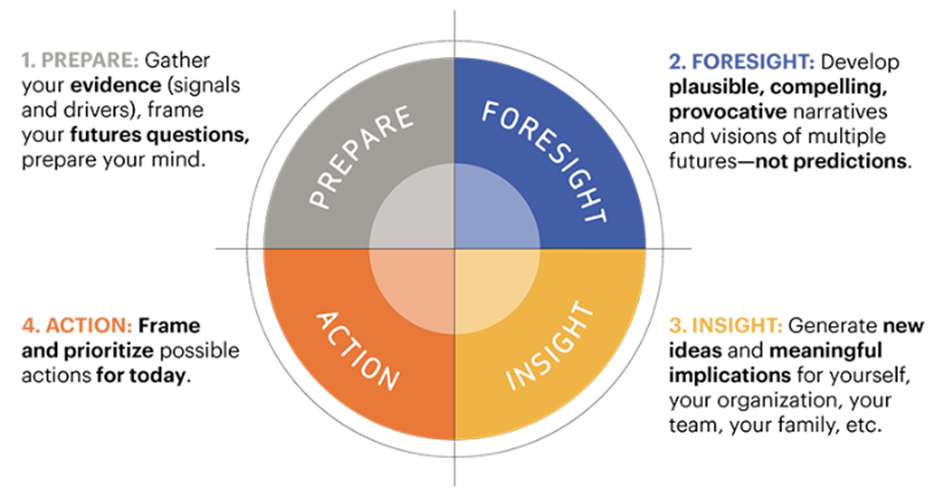
Strategic foresight is the disciplined exploration of possible, probable, and preferable futures to inform present-day decision-making. It is not a tool for prediction. It is a tool for preparation. Through foresight, leaders learn to detect patterns, interpret early signals of change, and construct alternative future scenarios that challenge the status quo. These activities stretch thinking, surface blind spots, and invite bold yet informed conversations. When practiced consistently, foresight transforms uncertainty from a source of fear into a source of strategic insight.
This module invites participants to step into the role of futures thinker. They will explore the difference between conventional forecasting and strategic foresight. Forecasting tends to extend past trends into the future, assuming that patterns will remain stable. Foresight, by contrast, prepares for discontinuities. It encourages leaders to scan the edges of their environments, ask better questions, and consider implications that may not yet be visible in their performance dashboards. In this way, foresight creates strategic agility and cultural readiness.
For technology executives, the stakes are especially high. Every day brings new developments in artificial intelligence, bioengineering, quantum computing, and climate tech. Regulatory frameworks struggle to keep pace. Customer loyalty shifts as values evolve. Business models that were sound five years ago may no longer hold. In this context, foresight is not a luxury. It becomes a lens through which investment choices, innovation pathways, and risk strategies are evaluated. The most effective technology leaders are not those with perfect knowledge. They are those who create processes for navigating what they cannot yet know.
Participants in this module will be introduced to a range of foundational foresight models. These include the Futures Cone, which illustrates different categories of futures including possible, plausible, probable, and preferable. The Horizon Scanning method, which helps identify emerging trends and weak signals before they become mainstream. The Delphi Method, which engages diverse expert opinions to test assumptions and surface hidden insights. And Scenario Planning, a tool for crafting narratives around alternative futures that allow for more robust and flexible planning. These models provide participants with a vocabulary and methodology for engaging with the future in more structured and meaningful ways.
Equally important is the application of foresight within existing strategic processes. Participants will explore how to embed foresight into annual planning cycles, innovation pipelines, portfolio management, and product development sprints. They will learn to use foresight to design trigger points, develop contingency options, and build scenario-based budgets and governance frameworks. Case studies from organizations that have used foresight to navigate technological disruption, public policy shifts, and environmental change will illustrate what effective integration looks like in practice.
The module also emphasizes the shift in mindset that foresight requires. Leaders are encouraged to cultivate intellectual humility, recognizing that their current view of the world is incomplete and constantly evolving. They are taught to suspend judgment in early stages of futures exploration, allowing ideas to surface that may seem unlikely today but could become pivotal tomorrow. This process builds tolerance for ambiguity and the ability to act without full information, a hallmark of strong strategic leadership.
One of the unique strengths of foresight is its ability to unify teams around shared long-term thinking. Participants will practice facilitating conversations that elevate beyond quarterly goals and engage teams in co-imagining future opportunities and threats. They will explore how to democratize foresight by engaging frontline staff, customers, and ecosystem partners in futures exploration. These inclusive practices not only strengthen the quality of foresight but also increase buy-in for strategic direction.
The psychological dimension of foresight is also addressed. Thinking about the future often evokes anxiety, particularly when dealing with volatility, disruption, or existential risks. This module introduces techniques to process and harness that emotion constructively. Through guided journaling, scenario immersion, and visual storytelling, participants learn to engage the future with curiosity instead of fear. This emotional shift is vital for enabling teams to embrace change, take initiative, and stay grounded in purpose.
To reinforce the practicality of foresight, participants will complete hands-on exercises using real data and challenges from their own organizations. They will build trend matrices, develop signal libraries, and generate scenario drafts that can be shared and refined with colleagues. They will also develop personal foresight practices, such as maintaining a futures journal or conducting monthly horizon scans, that build ongoing capacity beyond the workshop setting.
By the end of this module, participants will have developed a strategic foresight toolkit tailored to their context. They will be able to identify and categorize emerging trends, apply structured models to explore multiple futures, and translate foresight insights into strategic guidance. More importantly, they will have cultivated a new way of thinking. One that is anticipatory rather than reactive. One that is inclusive rather than insular. One that sees disruption not only as a risk but also as a space for leadership.
As Peter Schwartz, co-founder of the Global Business Network, once said, the best way to predict the future is to invent multiple possibilities and be prepared for all of them. This module builds the mindset and skillset to do just that. It transforms leaders from planners to navigators. From managers of certainty to architects of possibility. Strategic foresight is not just about seeing what comes next. It is about building the resilience and imagination to lead when the future is uncertain.
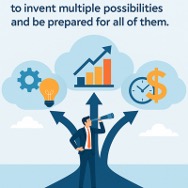 Participants who fully engage in this module will leave with a deeper awareness of the forces shaping their environment and a stronger capacity to lead through complexity. They will understand that while no one can control the future, every leader can shape their organization’s readiness for it. This preparation involves not only technical proficiency in using foresight tools but also the courage to advocate for long-term thinking in short-term cultures. They will be better positioned to design adaptive strategies, mobilize teams in response to change, and influence decision-making at every level of their organization. With this insight, they move forward not only better equipped but fundamentally transformed as leaders capable of turning uncertainty into momentum and ambiguity into opportunity. They will understand that while no one can control the future, every leader can shape their organization’s readiness for it. With this insight, they move forward not only better equipped but fundamentally transformed.
Participants who fully engage in this module will leave with a deeper awareness of the forces shaping their environment and a stronger capacity to lead through complexity. They will understand that while no one can control the future, every leader can shape their organization’s readiness for it. This preparation involves not only technical proficiency in using foresight tools but also the courage to advocate for long-term thinking in short-term cultures. They will be better positioned to design adaptive strategies, mobilize teams in response to change, and influence decision-making at every level of their organization. With this insight, they move forward not only better equipped but fundamentally transformed as leaders capable of turning uncertainty into momentum and ambiguity into opportunity. They will understand that while no one can control the future, every leader can shape their organization’s readiness for it. With this insight, they move forward not only better equipped but fundamentally transformed.
Learning Objectives
By the end of this module, participants will be able to define the concept of strategic foresight and explain how it differs from conventional forecasting, predictive analytics, and traditional long-term planning. They will understand that foresight is not about predicting one future but about preparing for multiple plausible futures by identifying drivers of change and crafting adaptive strategies. Participants will learn how to identify, interpret, and prioritize weak signals, emerging trends, and long-term drivers of change by applying structured environmental scanning tools. This includes the use of methods such as STEEP and PESTLE analysis to explore shifts across social, technological, economic, environmental, political, legal, and ethical dimensions.
They will gain proficiency in applying foresight frameworks including the Futures Cone, which categorizes futures based on possibility, probability, and preference. Participants will also learn to conduct Horizon Scanning to detect early indicators of change and Scenario Planning to build a narrative-based exploration of future possibilities. Through practical exercises, they will construct multiple future scenarios that are contextually relevant to their organization and assess the implications of each for business strategy, innovation, and resilience planning.
A core learning outcome of this module is the ability to evaluate how emerging technologies and societal trends such as generative AI, climate adaptation, geopolitical volatility, and shifts in consumer behavior could reshape their industries across near, mid, and long-term time horizons. Participants will learn to integrate these insights into their strategic planning processes to support organizational agility and foster innovation.
In addition, participants will build confidence in facilitating future-oriented conversations within their teams. They will practice leading structured dialogues that cultivate open-mindedness, curiosity, and collaborative imagination. Finally, participants will translate foresight into strategic action by connecting insights to real-world priorities. This includes guiding technology investment decisions, designing risk mitigation strategies, and identifying new growth opportunities. Together, these objectives prepare leaders to embed foresight into their leadership practice and position their organizations for long-term success in uncertain and evolving environments.
Content Overview
The content of this module is structured into five integrated components that build upon each other to provide a comprehensive foundation in strategic foresight. Each component serves a distinct purpose in equipping leaders with the insight, skills, and practical tools needed to explore the future systematically and translate those insights into strategic guidance. These components are intentionally sequenced to take participants from conceptual grounding to application and reflection. The structure ensures that foresight is not treated as a theoretical exercise but as a leadership capacity that enhances agility, insight, and long-term preparedness. Each segment is supported by curated resources, guided facilitation, and peer-based collaboration.
The first component focuses on the Foundations of Strategic Foresight. Participants begin by developing a clear understanding of what foresight is and how it compares to other approaches such as forecasting or predictive analytics. This distinction is important because while forecasting is about projecting the most likely outcome based on existing trends, foresight is about preparing for multiple outcomes including those that are unlikely but impactful. Leaders explore the principles of foresight and its role in helping organizations become more resilient and adaptive. They study the evolution of foresight as a discipline and how it has been applied by governments, corporations, nonprofits, and innovation labs around the world. Through historical examples and facilitated discussion, participants examine how a failure to engage in foresight has led to missed opportunities or crises and how proactive foresight has positioned organizations for success. They also reflect on their personal mindset and consider how comfort with uncertainty and curiosity about the future can become strategic assets in their leadership journey. By examining their assumptions about change and control, participants expand their comfort with ambiguity and begin developing a readiness to embrace diverse possibilities. This reframing helps them recognize that foresight is not reserved for futurists or strategic planners but is accessible to all leaders. It lays the foundation for the rest of the module by establishing foresight as a mindset, a method, and a muscle.
The second component introduces key Tools and Frameworks for foresight. Participants are guided through practical application of models such as the Futures Cone, which illustrates the spectrum of future possibilities from impossible to preferable. This visual model helps participants expand their thinking beyond linear extrapolation and embrace a wider field of imagination. They learn how to use Horizon Scanning as a technique to identify emerging trends and weak signals from a variety of sources including industry reports, academic research, media, and thought leadership. The Delphi Method is also explored as a structured group process for gathering insights and building consensus among experts. Scenario Planning is taught in depth as a cornerstone of strategic foresight. Participants learn how to identify key uncertainties, map critical drivers of change, and build narrative scenarios that help teams explore implications and stress test existing strategies. They practice creating scenarios for different strategic questions such as the future of work, the evolution of digital trust, or the role of artificial intelligence in healthcare. These exercises help participants internalize the value of scenario thinking not just as a planning tool but as a mindset for navigating complexity. Tools are also supplemented with templates and visual aids so that participants can apply them easily within their teams and organizations. Emphasis is placed on interpretation, synthesis, and translation of insights, ensuring that foresight activities generate actionable ideas. Through this process, foresight becomes a structured way to enhance creativity, clarify risk, and build long-term resilience.
The third component emphasizes the Application of Foresight in Organizational Contexts. Participants explore how foresight can be embedded into existing strategic processes rather than treated as a standalone activity. They examine how companies use foresight in their product development roadmaps, R&D portfolios, and strategic innovation labs. They learn how public sector institutions use foresight to inform policy design and crisis preparation. Through case studies and role plays, participants practice integrating foresight into quarterly reviews, board-level discussions, and cross-functional workshops. They also learn how to design early warning systems and trigger points that signal when a strategy may need to pivot. Special attention is given to how foresight can help bridge the gap between long-term vision and short-term execution. Participants analyze examples of organizations that use foresight to create adaptive strategies which evolve over time rather than remain static. This component reinforces the idea that foresight is not just for the planning department. It is a distributed capability that every leader can learn to apply within their sphere of influence. Participants also explore how foresight enhances prioritization by allowing leaders to balance immediate opportunities with longer-term risks and possibilities. Real-world cases illustrate how organizations pivoted early by acting on weak signals and insights gathered through disciplined foresight. The process encourages leaders to think of foresight as a continuous feedback loop embedded in governance rather than a one-time workshop.
The fourth component is Building Futures Literacy Across Teams. Participants learn how to build a foresight culture by creating space for future-oriented dialogue in everyday conversations. They explore how to facilitate futures thinking exercises within their teams using visual storytelling, timelines, and speculative prompts. Participants are introduced to techniques for helping teams suspend judgment and engage with improbable scenarios constructively. The module emphasizes that foresight is not the responsibility of a few experts but a shared practice that benefits from diversity of thought. Leaders are encouraged to involve team members from different functions, backgrounds, and levels of experience in foresight conversations. This inclusivity not only strengthens the quality of insights but also deepens engagement with strategic direction. Participants practice facilitating foresight workshops and retrospectives that balance creativity with discipline. They also learn how to use foresight tools during team offsites, innovation sprints, and strategic planning sessions to build alignment and momentum around long-term priorities. This component introduces strategies for building team rituals that reinforce long-term thinking, such as trend discussions in staff meetings or scanning activities during project kickoffs. Leaders receive support in handling resistance and skepticism by connecting foresight to familiar decision-making frameworks. As they gain fluency in facilitating futures conversations, participants increase their ability to cultivate curiosity and foster innovation across their organizations.
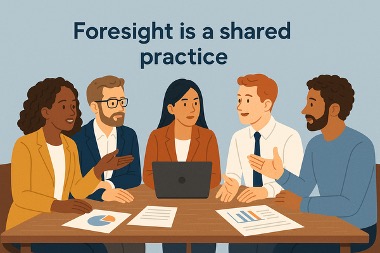 The final component focuses on Translating Insight into Action. Participants reflect on how to use what they have learned to make tangible changes in how they lead. They create foresight action plans tailored to their own organizational challenges and strategic goals. These plans include defining strategic questions, identifying scanning sources, selecting foresight tools, and designing team engagement strategies. Participants are introduced to frameworks for evaluating the impact of foresight activities over time. They explore how to connect foresight insights with investment decisions, product roadmaps, and resource allocation. They also learn how to communicate foresight findings in ways that resonate with stakeholders who may be more focused on immediate results. By the end of the module, each participant will have a draft foresight implementation roadmap and a set of personal leadership commitments to help integrate foresight into their daily work. This final section reinforces foresight as a habit of mind and practice. It challenges leaders to consider how they will reinforce foresight through governance, metrics, and capacity building. Participants identify internal allies and routines to ensure that foresight does not remain theoretical but becomes embedded in their operating systems.
The final component focuses on Translating Insight into Action. Participants reflect on how to use what they have learned to make tangible changes in how they lead. They create foresight action plans tailored to their own organizational challenges and strategic goals. These plans include defining strategic questions, identifying scanning sources, selecting foresight tools, and designing team engagement strategies. Participants are introduced to frameworks for evaluating the impact of foresight activities over time. They explore how to connect foresight insights with investment decisions, product roadmaps, and resource allocation. They also learn how to communicate foresight findings in ways that resonate with stakeholders who may be more focused on immediate results. By the end of the module, each participant will have a draft foresight implementation roadmap and a set of personal leadership commitments to help integrate foresight into their daily work. This final section reinforces foresight as a habit of mind and practice. It challenges leaders to consider how they will reinforce foresight through governance, metrics, and capacity building. Participants identify internal allies and routines to ensure that foresight does not remain theoretical but becomes embedded in their operating systems.
Together, these five components provide a robust and immersive learning experience. Participants will leave the module with a deeper understanding of foresight not only as a discipline but as a mindset. They will know how to build futures capacity within their organizations and how to lead with greater strategic agility. Most importantly, they will gain confidence in facing uncertainty and using it as a catalyst for meaningful action. Strategic foresight is not about predicting what comes next. It is about shaping what happens next through better questions, broader perspectives, and deliberate choices. This module provides the structure and support for leaders to begin that journey with purpose and clarity. In cultivating a future-oriented posture, participants contribute to a more adaptive, innovative, and opportunity-rich culture in their organizations. They also develop personal clarity about the kind of impact they want to make as leaders in an unpredictable world. The module concludes with a call to action to continue building foresight capacity as a lifelong leadership competency.
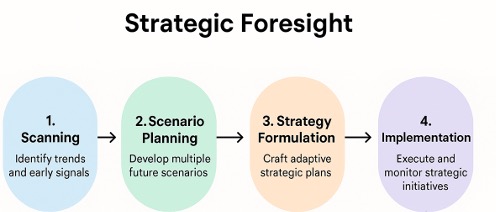

Case Study: Microsoft’s Anticipatory Strategy for the AI Revolution
In the early 2010s, Microsoft found itself at a strategic crossroads. While still dominant in enterprise software, it was facing stagnation in consumer markets, missed opportunities in mobile, and growing irrelevance in cloud-native innovation. Recognizing these signals, Microsoft embarked on a foresight-driven transformation—one that would later position it at the forefront of the artificial intelligence (AI) revolution.
Horizon Scanning: Sensing the Signals
Microsoft’s internal strategy and research teams began identifying weak signals in the AI landscape. These included:
Advances in deep learning (notably, breakthroughs in image and speech recognition).
The growing availability of data from cloud-connected devices.
Increased compute power from GPUs and specialized chips like FPGAs.
The rise of open-source AI tools (e.g., TensorFlow, PyTorch).
Externally, Microsoft observed that competitors like Google and Amazon were embedding AI into consumer experiences, from voice assistants to smart recommendations. Internally, engineers and researchers were experimenting with language models and neural networks, but these efforts were siloed, and the executive narrative lacked cohesion.
Scenario Development and Strategic Framing
Rather than betting on one AI future, Microsoft crafted multiple plausible scenarios:
Scenario A: AI Commoditization – Cloud providers compete on infrastructure cost; AI becomes a cheap utility.
Scenario B: AI-First Platforms – Developers build new apps entirely around intelligent capabilities, bypassing legacy platforms.
Scenario C: Regulated AI Ecosystems – Governments impose strict ethical and compliance constraints, fragmenting global adoption.
Each scenario posed different challenges and opportunities. Microsoft mapped how its existing products, partnerships, and internal capabilities would need to shift to remain relevant—or lead.
This process revealed strategic gaps: while the company had strong R&D, it lacked a unified AI platform and a coherent strategy to embed AI across its enterprise offerings.
Backcasting from a Preferred Future
Microsoft defined a preferred future: to become the trusted AI platform for enterprises, offering ethical, scalable, and developer-friendly tools. Working backward from this vision, the company developed a strategic roadmap that included:
Centralizing AI research under Microsoft Research and building Azure AI as a unified platform.
Acquiring and integrating startups like Maluuba (for NLP) and Bonsai (for industrial AI).
Embedding AI features into flagship products—like Excel, Dynamics, and Office—turning them into intelligent productivity tools.
Launching AI Ethics frameworks and co-chairing industry consortiums on responsible AI.
This vision was reinforced by a rebranding of purpose under Satya Nadella’s leadership: empowering every person and every organization on the planet to achieve more—an ambition clearly aligned with democratizing AI.
Outcomes and Ongoing Foresight
By the early 2020s, Microsoft had become a leader in enterprise AI. Its Azure Cognitive Services were being used across sectors. Its integration with OpenAI (including exclusive licenses for GPT models) positioned it at the leading edge of foundation model deployment. And its reputation for ethical AI governance gave it an edge in regulated industries.
Just as importantly, Microsoft institutionalized foresight:
Regular “Technology Outlook” sessions were established across teams.
A Future of Work initiative explored hybrid collaboration and AI augmentation scenarios.
Product teams used strategic assumptions testing as part of design sprints.
Microsoft’s transformation wasn’t reactive—it was anticipatory. Rather than waiting for AI disruption, it shaped its own future by combining early signal detection, scenario planning, and internal realignment.
Key Takeaways for Technology Leaders
• Foresight is not a luxury—it’s a strategic imperative in sectors shaped by exponential change.
• Scenario planning helps leaders prepare for multiple futures rather than commit prematurely to one.
• Backcasting turns vision into a structured, executable plan.
• Embedding foresight in governance ensures continuous adaptation and avoids strategy drift.
The ability to institutionalize learning from weak signals can differentiate tomorrow’s leaders from today’s incumbents.

Group Exercise: Designing Foresight-Driven Strategy
Create adaptable, future-focused strategies by leveraging strategic foresight.
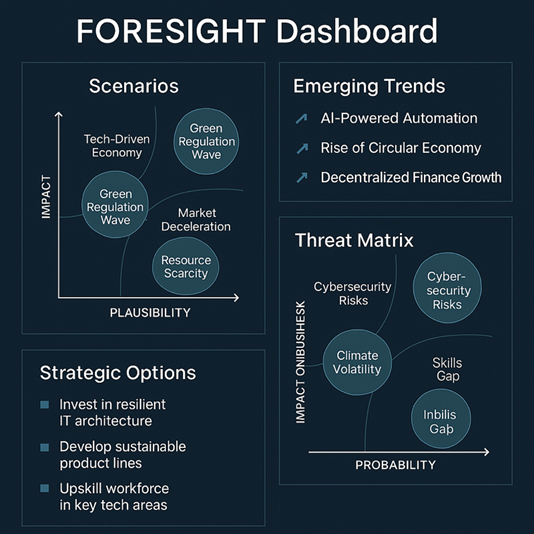
As a group, list two significant trends shaping your organization or industry.
Together, envision one plausible future scenario (5–7 years ahead) based on your identified trends and disruption. Briefly describe:
The external environment
Customer and competitor behavior
Emerging opportunities or risks
For your scenario, outline:
One proactive strategic initiative.
One key assumption underlying your scenario.
One critical indicator or signal you’ll monitor to anticipate future changes.
Confirm your strategies are robust and adaptable, ready to respond to unexpected changes.
Summary
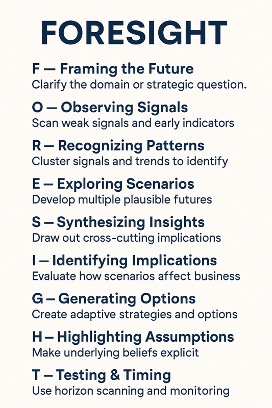
Strategic foresight is an essential leadership discipline that empowers technology leaders to anticipate change rather than merely react to it. This module introduces participants to structured foresight methodologies, including horizon scanning, trend mapping, scenario planning, and signal detection that sharpen strategic vision and inform resilient decision-making. Through real-world case studies and a collaborative group exercise, leaders learn how to distinguish between weak signals and true disruptors, design plausible future scenarios, and embed foresight into ongoing strategy cycles. Equipped with these tools, participants will be prepared to guide their organizations through complexity with agility, creativity, and clarity of direction.
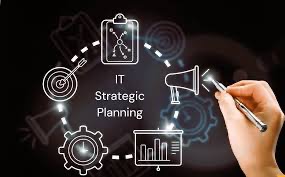
Course Manual 3: Aligning with Business Goals (ABG)
Introduction
A strategic vision without alignment is like a compass without a map. It may offer a sense of direction, but it fails to define the terrain, the waypoints, or the obstacles that shape real progress. For technology leaders, defining an inspiring vision and applying foresight tools are essential starting points. However, the true test of leadership lies in execution. More specifically, it lies in the ability to convert that vision into concrete initiatives that align with business strategy and generate measurable impact. This module focuses on the leadership discipline of strategic alignment. It explores how to ensure that technology investments, team goals, and innovation roadmaps consistently advance enterprise-level objectives.
In many organizations, there is a persistent disconnect between strategic ambition and operational execution. This gap often exists because various parts of the organization function on different time horizons, use different metrics, and speak different languages. Business leaders may focus on revenue growth, customer acquisition, risk reduction, and market expansion. Meanwhile, technology teams may be preoccupied with feature releases, infrastructure stability, and deployment velocity. Although both groups are committed to success, their lack of shared context leads to misalignment. This results in duplicated effort, missed opportunities, and underwhelming outcomes. Strategic alignment addresses this challenge by creating a shared sense of purpose, a unified planning structure, and a rhythm of collaboration that brings clarity across silos.
Participants in this module will be introduced to alignment as both a mindset and a management system. Alignment is not just about mapping goals. It is about fostering a culture in which teams understand not only what they are working on but why it matters. It is about ensuring that every technology initiative is connected to business outcomes such as customer satisfaction, operational efficiency, revenue enablement, or competitive differentiation. To make this possible, leaders must bridge the gap between technical planning and strategic communication. They must speak both languages fluently, translating between engineering logic and enterprise value.
This module will introduce participants to proven frameworks for strategic alignment. These include Objectives and Key Results, the Balanced Scorecard, and Hoshin Kanri. Each of these methods offers a structure for cascading enterprise goals into team-level objectives and key activities. Objectives and Key Results help teams focus on what matters most and track progress through measurable outcomes. The Balanced Scorecard provides a multi-dimensional lens through which to view organizational health, incorporating financial, customer, process, and learning goals. Hoshin Kanri, a Japanese planning system, aligns long-term strategy with daily management through a process of policy deployment and continuous feedback. Participants will explore how to choose the right framework for their organization’s size, culture, and maturity. They will also learn how to adapt these tools to the realities of hybrid teams, agile delivery models, and fast-moving product environments.
Equally important is understanding why alignment breaks down. This module examines common barriers to alignment, including misaligned metrics, isolated planning processes, unclear role definitions, and inconsistent prioritization. For example, an IT team may invest heavily in automating a legacy system, while the business has shifted focus to customer acquisition. Or a data science team may pursue experimental use cases without input from operational teams who will be responsible for implementation. These are not failures of intent. They are failures of alignment. Participants will diagnose real-world examples of these breakdowns and learn how to prevent them by implementing cross-functional planning sessions, shared scorecards, and unified success metrics.
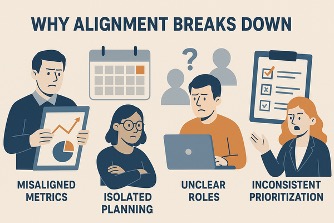 Through interactive simulations and case study analysis, participants will practice the skill of cascading goals from the executive level to functional and team levels. A featured case study of Salesforce demonstrates how strategic priorities are translated into quarterly themes, team OKRs, and individual accountability. Participants will explore how Salesforce uses alignment as a growth driver, linking values with execution and consistently revisiting progress through review rituals and communication cadences. In their group exercise, participants will be asked to simulate a similar process for a hypothetical company, taking enterprise goals and translating them into product development plans, infrastructure roadmaps, and team-level deliverables. This hands-on experience helps leaders build fluency in alignment mechanisms and exposes gaps in their own organizations’ processes.
Through interactive simulations and case study analysis, participants will practice the skill of cascading goals from the executive level to functional and team levels. A featured case study of Salesforce demonstrates how strategic priorities are translated into quarterly themes, team OKRs, and individual accountability. Participants will explore how Salesforce uses alignment as a growth driver, linking values with execution and consistently revisiting progress through review rituals and communication cadences. In their group exercise, participants will be asked to simulate a similar process for a hypothetical company, taking enterprise goals and translating them into product development plans, infrastructure roadmaps, and team-level deliverables. This hands-on experience helps leaders build fluency in alignment mechanisms and exposes gaps in their own organizations’ processes.
The module also focuses on the cadence of alignment. Strategic alignment is not a one-time planning event. It is an ongoing process that requires attention, recalibration, and discipline. Participants will learn how to set up review rhythms that include quarterly business reviews, OKR check-ins, and cross-team syncs. These touchpoints ensure that teams remain focused on the most critical goals, that emerging risks are addressed early, and that strategic assumptions are challenged and updated. Participants will explore how to lead alignment conversations that are both data-driven and purpose-centered, ensuring accountability while maintaining strategic clarity.
Adaptability is another critical theme in this module. Alignment must be dynamic. Business priorities shift in response to market dynamics, regulatory changes, customer feedback, and competitive pressure. Technology leaders must be prepared to adjust their roadmaps accordingly while ensuring that teams remain focused and engaged. This requires transparency, trust, and the courage to say no to initiatives that no longer serve the strategy. Leaders will explore how to evaluate existing initiatives through the lens of relevance and impact. They will practice asking tough but necessary questions such as: What should we stop doing? What must we accelerate? Where are we spreading ourselves too thin? By embedding these questions into decision-making routines, leaders create organizations that are both aligned and agile.
Participants will also explore the role of metrics in sustaining alignment. Measurement reinforces clarity. When metrics are tied to outcomes that matter to both business and technology stakeholders, they become powerful tools for alignment. Participants will learn how to define key performance indicators that reflect strategic objectives and ensure that those metrics are visible, actionable, and updated regularly. They will examine dashboards from real companies and explore how to use these tools in leadership meetings, team stand-ups, and executive updates. Through this work, leaders will develop the ability to shift alignment from aspiration to execution.
Finally, the module reinforces the human element of alignment. Alignment is not only structural. It is cultural. It requires mutual understanding, respect, and collaboration across disciplines. Leaders will reflect on their own alignment practices and identify areas where their communication, prioritization, or delegation could be improved. They will engage in peer coaching sessions to surface hidden misalignments and develop strategies for strengthening cross-functional trust. By doing this, they will not only become better planners but also better partners in enterprise transformation.
By the end of this module, participants will be equipped with a robust alignment toolkit. They will know how to clarify organizational goals, map those goals into technology initiatives, and create communication flows that sustain alignment across time. They will understand how to identify and remove obstacles to alignment, how to use metrics to guide decision-making, and how to foster a culture where alignment is not a mandate but a shared discipline. This will prepare them to lead with clarity and confidence in complex, fast-paced environments where alignment is the difference between motion and momentum.
Strategic alignment is the heartbeat of enterprise transformation. When technology, operations, and strategy beat in sync, organizations move faster, waste less, and deliver more. This module empowers technology leaders to become not just builders of systems but builders of aligned purpose-driven enterprises.
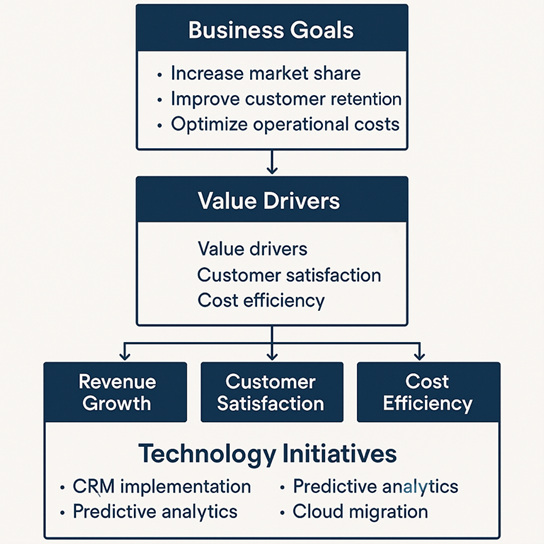
Learning Objectives
By the end of this module, participants will possess the ability to identify and clearly articulate their organization’s core business objectives and success metrics. They will understand how to interpret top-level strategies and translate them into specific, outcome-driven statements that provide meaningful direction to technology teams. Participants will also gain experience in converting business goals into actionable technology strategies, ensuring that system architecture, software development, platform investments, and process improvements directly serve measurable enterprise priorities.
In order to enable effective alignment, participants will become familiar with widely adopted frameworks such as Objectives and Key Results, the Balanced Scorecard, and Hoshin Kanri. Through practical application, they will learn to use these tools to bridge long-range vision with operational planning and execution. This includes setting relevant objectives, establishing key results or KPIs, and deploying mechanisms for organizational accountability. Participants will explore how these frameworks help structure alignment conversations across departments, provide clarity on ownership, and define metrics that resonate across business and technical stakeholders.
Additionally, participants will be trained to diagnose common sources of misalignment, such as conflicting departmental goals, vague accountability structures, or inconsistent prioritization. They will examine real-world breakdowns in alignment and explore how to address them through collaborative planning sessions, transparency in decision-making, and regular calibration between leadership tiers. Participants will practice facilitating cross-functional goal-setting exercises and learn how to ensure that team-level objectives and key activities cascade meaningfully from executive strategy.
To sustain alignment over time, participants will build measurable alignment dashboards that track progress, identify risk areas, and highlight impact. These dashboards will be designed not only to measure outcomes but also to promote accountability and communication across teams. Finally, participants will explore the importance of adaptability. They will learn how to build feedback loops into their alignment processes, allowing them to respond to changing business conditions or strategic pivots while maintaining coherence and momentum. By mastering these objectives, participants will enhance their ability to lead with precision, clarity, and alignment in high-growth, complex environments.
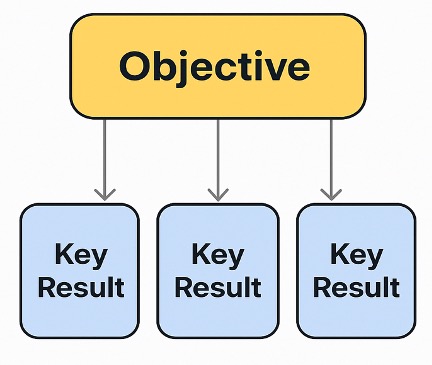
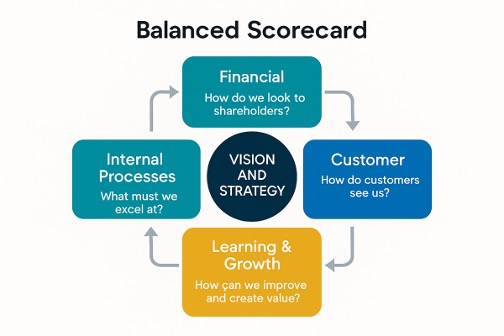
Content Overview
This module on aligning technology initiatives with business goals is structured around four key learning pillars, each building on the other to help participants develop an actionable understanding of how alignment becomes a strategic enabler rather than a reactive afterthought. These pillars include strategic context mapping, application of alignment frameworks, diagnosing misalignment and realignment systems, and sustaining cross-functional coherence through metrics and rituals. Each element of the content is delivered through a combination of expert-led instruction, case study analysis, peer discussion, and real-world simulation exercises to ensure participants can internalize and apply alignment principles across diverse organizational settings. Leaders will be encouraged to test their understanding by applying concepts to live challenges within their current organizational context. This approach ensures that learning remains practical, context-specific, and transferable beyond the workshop.
The first component is Strategic Context Mapping. Participants begin by understanding how to surface and clarify their organization’s most critical business objectives. They learn to differentiate between aspirational goals and operational imperatives, helping their teams make informed tradeoffs. By engaging in stakeholder mapping and strategic listening, participants identify the drivers behind executive-level initiatives and translate them into clearly stated value propositions. Exercises focus on framing these goals in a way that links back to customer impact, revenue growth, market expansion, or risk mitigation. Through this, technology leaders learn to build context maps that anchor decisions, clarify resource allocation, and support cross-functional transparency. This component also introduces participants to strategic goal decomposition, allowing them to practice unpacking complex, high-level goals into actionable subcomponents for technical teams. Discussions include how to align with customer experience goals, ESG commitments, digital transformation imperatives, and regional expansion strategies. As participants gain clarity on their organization’s strategic landscape, they are better equipped to identify opportunities where technology can become a competitive differentiator.
The second component introduces Alignment Frameworks in Action. Participants explore three foundational models for aligning strategy with execution—OKRs, the Balanced Scorecard, and Hoshin Kanri. Through guided walkthroughs and scenario-based labs, they learn the nuances of each system. OKRs are used to connect mission-level goals with specific key results, ensuring progress is tracked with measurable indicators. The Balanced Scorecard emphasizes four dimensions—financial, customer, internal processes, and learning and growth—to create a balanced alignment view across business units. Hoshin Kanri introduces the discipline of strategic policy deployment, which emphasizes aligning daily actions with long-term breakthroughs. Participants will apply each of these frameworks to fictional and real-life organizational contexts. They will draft objectives, identify leading and lagging indicators, and design goal trees that ensure alignment from senior leadership to front-line engineers. Special emphasis is placed on choosing the right framework based on an organization’s maturity, governance structure, and preferred decision-making culture. Leaders reflect on how their teams currently define success and where shared definitions of impact may be lacking or misaligned. They also explore how these frameworks can be adapted for agile environments, matrixed organizations, and cross-border teams. Emphasis is placed on real-time feedback and learning loops that reinforce alignment without slowing innovation.
The third component focuses on Diagnosing Misalignment and Rebuilding Trust. Participants examine common failure points in strategic alignment. These include siloed goal-setting processes, unclear accountability, conflicting metrics, and ambiguous prioritization. They study case examples where misalignment between business and technology teams delayed outcomes, reduced value realization, or eroded trust between leadership and delivery functions. Participants practice identifying signals of misalignment such as duplicated efforts, resistance to prioritization changes, or divergent timelines between teams. They learn how to use structured diagnostics such as alignment heatmaps and stakeholder interviews to pinpoint systemic breakdowns. Through simulated exercises, participants then practice leading alignment recovery sessions. These conversations are designed to restore clarity, rebuild commitment, and create shared definitions of value. Leaders explore techniques such as alignment retrospectives, role negotiation conversations, and the use of shared OKRs to reestablish coordination. They also examine how to deal with tensions between long-term innovation efforts and short-term revenue pressures, ensuring that technology leaders are prepared to navigate both tactical and strategic alignment tensions. In doing so, participants build skills not only in technical alignment planning but also in conflict resolution and stakeholder empathy, essential to rebuilding trust in cross-functional settings.
The fourth component emphasizes Sustaining Alignment Over Time. Achieving alignment is not a one-time event but an ongoing leadership responsibility. Participants explore how to create systems that reinforce alignment through planning rhythms, performance rituals, and transparent communication. They learn how to establish quarterly business reviews, team goal check-ins, and mid-cycle adjustments that maintain alignment momentum. They also explore how to use visual management tools such as alignment dashboards and digital canvases to keep alignment visible and actionable. This section includes a toolkit for designing alignment governance processes, including how to structure leadership meetings, feedback loops, and escalation paths that support continuous realignment. Participants practice crafting alignment scorecards that combine leading and lagging indicators, cross-team dependencies, and initiative health metrics. They also learn how to lead alignment moments during crises or rapid pivots—when clarity and cohesion are most critical. Emphasis is placed on learning from misalignment by treating deviations as learning signals rather than compliance failures. This section also emphasizes psychological safety and inclusion, ensuring that alignment conversations remain constructive and focused on solutions rather than blame. Leaders finish this segment with confidence in their ability to lead adaptive alignment across product launches, digital transformations, and cross-functional initiatives.
In addition to these four core components, the module integrates a range of case studies, including Salesforce, Adobe, and Toyota. These companies are studied for their alignment practices across product strategy, customer success, and operations. Participants analyze how these organizations used alignment to accelerate transformation, reduce waste, and deepen employee engagement. They discuss the cultural habits, leadership behaviors, and structural mechanisms that sustained alignment in complex and evolving environments. These examples offer participants a realistic and aspirational benchmark for what enterprise-level alignment can look like when executed effectively. The stories also surface the importance of leadership commitment, clear vision anchoring, and continuous stakeholder involvement. Participants leave with a set of replicable principles and templates that they can adapt within their own organization’s context.
Throughout the module, participants are invited to bring their own alignment challenges into peer coaching sessions. They receive structured feedback on current misalignment issues and support from peers in developing plans for resolution. They also draft a custom alignment blueprint for their own teams. This document includes alignment priorities, chosen frameworks, key stakeholder commitments, and a 90-day alignment action plan. This ensures that participants leave with not only a conceptual understanding but a practical application plan. Peer learning deepens insight and helps surface blind spots that may be invisible in one’s own organizational lens. The final blueprint serves as a living strategy tool, revisited and updated throughout the program to ensure continuous learning and progress.
By the conclusion of this module, participants will have a comprehensive view of what alignment really entails. They will understand how to translate goals into outcomes, how to manage the interpersonal and structural barriers to coherence, and how to lead alignment as a continuous process. With this knowledge, participants will be able to lead strategic conversations that unite business and technology stakeholders, prioritize with clarity, and support execution with shared understanding. They will become catalysts of cohesion, empowered to bring unity and momentum to enterprise strategy through deliberate alignment. The skills gained in this module help reinforce their evolving identity as a strategic leader who drives clarity across systems, people, and outcomes. This foundation prepares participants for future modules in which execution, measurement, and agility will be examined through the lens of scalable, sustainable leadership alignment.
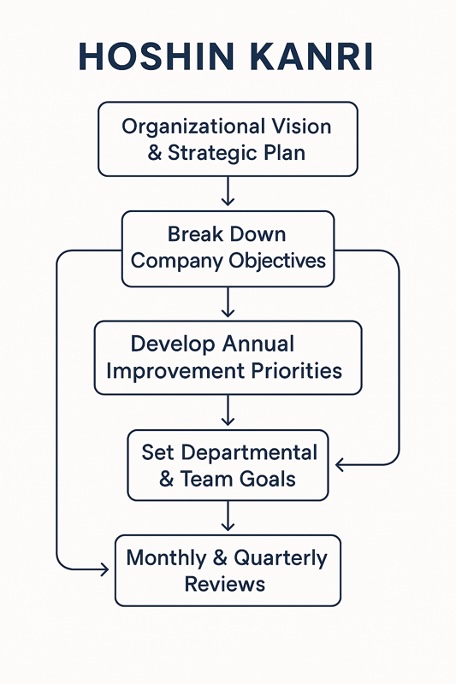

Case Study: Salesforce – Aligning Vision, Values, and Business Goals for Scalable Growth
Salesforce, founded in 1999 by Marc Benioff, has become a dominant force in enterprise SaaS by aligning its business goals with a bold strategic vision: “to bring companies and customers together.” From its inception, Salesforce aimed to redefine customer relationship management (CRM) through the cloud, while simultaneously embedding a values-based operating model across all business functions.
This case illustrates how alignment across vision, business priorities, product innovation, and stakeholder values can create a high-growth, future-resilient organization.
Step 1: Anchoring Vision to Customer Success
Salesforce’s strategic vision—Customer Success is Our Success—shaped its business goal to become the go-to platform for managing customer experiences. Instead of building disconnected applications, the company committed to an integrated Customer 360 platform. This aligned vision with a measurable business goal: increasing customer lifetime value and retention.
Every product line (e.g., Sales Cloud, Service Cloud, Marketing Cloud) was evaluated for its contribution to a unified customer experience. This clarity enabled prioritization of R&D investments and cross-functional team efforts.
Step 2: Embedding OKRs Across Business Functions
Salesforce uses Objectives and Key Results (OKRs) to align business outcomes across departments. Example:
Objective: Grow penetration in healthcare verticals
Key Results: Launch Health Cloud updates with HIPAA compliance; onboard 30 new healthcare clients; increase user adoption by 15%
These OKRs tie directly to the company’s annual strategic plan and are reviewed quarterly by cross-functional leadership teams.
Step 3: Strategic Acquisitions Aligned with Business Goals
Unlike opportunistic M&A strategies, Salesforce uses acquisitions to directly support its strategic themes.
The acquisition of MuleSoft (2018) strengthened integration capabilities.
Tableau (2019) expanded data visualization for enterprise clients.
Slack (2020) accelerated its vision for the digital HQ and team collaboration.
Each move was assessed for fit against the company’s Customer 360 platform vision and its core business growth objectives.
Step 4: Values-Driven Alignment through the V2MOM Framework
Salesforce developed a proprietary alignment tool: V2MOM – Vision, Values, Methods, Obstacles, Measures.
Vision: What do we want to achieve?
Values: What’s important about it?
Methods: How do we get it done?
Obstacles: What challenges must we overcome?
Measures: How do we know we’ve succeeded?
Every employee creates a personal V2MOM linked to the company’s top-level priorities. This creates horizontal and vertical alignment, fostering both clarity and autonomy.
Step 5: Aligning Stakeholders Through Communication Rituals
To sustain alignment at scale, Salesforce implements the following:
Monthly “All Hands” meetings to cascade key strategic priorities
Town halls hosted by functional leaders to localize goals
Performance dashboards that track adoption, revenue impact, and customer satisfaction across all products
Executive alignment meetings every quarter to recalibrate product, marketing, and sales focus
Results and Impact
Annual revenue grew from $4 billion in 2014 to over $34 billion in 2024
Maintained a Net Revenue Retention (NRR) rate of over 115%
Salesforce is now the #1 CRM provider globally for over a decade
The company has consistently ranked among “World’s Most Admired Companies” and “Best Places to Work,” signaling strong internal alignment and stakeholder trust
Lessons for Technology Leaders
Alignment must be operationalized through structured tools (like OKRs or V2MOM), not just through leadership speeches
Acquisitions and innovation should ladder up to clearly defined business goals and strategic themes
Shared rituals and dashboards maintain visibility, accountability, and real-time calibration
Cultural alignment amplifies the execution of strategic priorities across geographies and roles
Salesforce shows that aligning business goals with customer value, innovation strategy, and cultural DNA creates a flywheel of long-term, scalable success.

Group Exercise: Strategic Alignment Simulation – Bridging Tech Vision with Business Goals
Two primary business goals your organization must achieve in the next year.
One critical challenge related to these goals.
List two technology initiatives that directly support your identified business goals. Briefly note how each initiative impacts the business positively.
Discuss briefly any potential misalignments or conflicts. Agree on:
The top-priority initiative
One key risk or concern associated with implementing it
Clearly articulate a simple alignment statement:
“Our priority is [technology initiative] to achieve [business goal], addressing [challenge or risk].”
Ensure your statement is concise, actionable, and clearly aligned across the group.
Summary
Aligning technology strategy with business goals is not a one-time task but an ongoing discipline of translation, negotiation, and focus. This module provided leaders with the mindset and tools to ensure that every digital initiative directly supports measurable business outcomes.
Through real-world examples, stakeholder simulations, and structured frameworks, participants practiced bridging strategic vision with execution. By understanding how to map tech capabilities to value drivers—such as revenue growth, operational efficiency, and customer experience—leaders sharpened their ability to influence, prioritize, and lead from a place of impact. The tools explored here serve as the foundation for building business credibility and creating a resilient, innovation-ready enterprise.

Course Manual 4: Gap Analysis for Strategic Decision-Making (GSD)
Introduction
In technology leadership, a well-defined strategy must be grounded in reality. Vision and ambition must be matched with clear-eyed assessments of current capabilities. This is where gap analysis becomes indispensable. It acts as a strategic mirror helping leaders identify the space between where the organization is and where it needs to be to achieve its long-term goals. While vision charts a path toward a desired future, gap analysis tells you how far away that future is and what it will take to get there. It transforms aspiration into action and highlights not only what is possible but what is necessary.
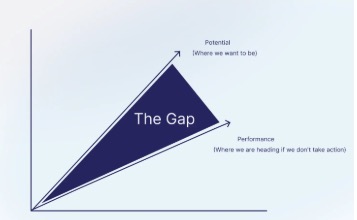
Gap analysis is not merely a diagnostic tool. It is a decision-making engine. By systematically comparing the current state with a desired future state, technology leaders can uncover blind spots, prioritize investments, and align teams around the most critical areas for improvement. It brings clarity to complexity by identifying disconnects between strategy and capability. It enables leaders to focus their attention and resources on closing performance, process, or capability gaps that would otherwise stall progress. Importantly, it also enables more honest conversations across stakeholders and breaks down assumptions that often mask the true reasons for organizational inertia.
For technology executives leading digital transformation, product modernization, or innovation portfolios, gap analysis becomes a non-negotiable step. It provides the foundation for execution by highlighting readiness or lack thereof across systems, teams, processes, and cultural dimensions. Whether launching a new AI platform, migrating to the cloud, or transforming a legacy IT environment, leaders must begin by asking one essential question. What stands between where we are today and the outcomes we are trying to deliver. Gap analysis provides the tools and frameworks to answer that question with specificity and objectivity.
This module introduces structured approaches to conducting gap analysis in a technology and innovation context. Participants will learn how to assess organizational, technical, and cultural readiness against strategic objectives. They will explore methods for surfacing hidden weaknesses, evaluating solution trade-offs, and designing interventions that close the gap without overextending resources. The emphasis is on pragmatism, transparency, and focus equipping leaders with the tools to make hard choices and advance with confidence. Gap analysis also introduces a new level of granularity to strategic planning, allowing participants to identify capability shortfalls not just at a system level but across governance structures, skillsets, data maturity, and operational alignment.
Participants will be introduced to several categories of gap analysis. These include capability gaps which measure what the organization can do today versus what it needs to do. Process gaps which examine how current workflows or governance models hinder progress. Technology gaps which look at systems, platforms, or integration readiness. Culture gaps which analyze mindset, change readiness, and leadership alignment. Each of these dimensions contributes to a comprehensive understanding of organizational readiness. Through structured interviews, surveys, workshops, and benchmarking exercises, participants will learn to gather the data necessary to conduct a well-rounded analysis. More importantly, they will learn to interpret that data and use it to drive prioritization.
The module emphasizes that gap analysis is not about identifying every weakness. It is about identifying the most important ones. Leaders are encouraged to focus on the gaps that directly affect strategic outcomes or pose existential risks to transformation efforts. Through prioritization frameworks such as impact effort matrices and risk alignment tools, participants will learn to sort gaps into categories. Critical must close gaps. Important should close gaps. Peripheral monitor for now gaps. This triage approach helps leaders manage complexity and prevents analysis from becoming paralysis.
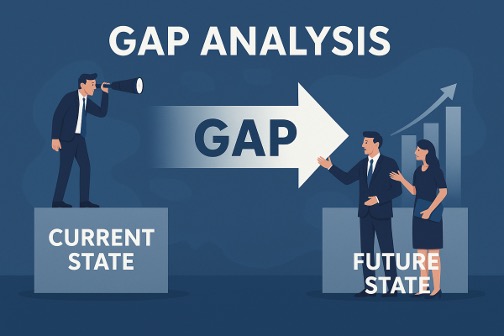
Participants will also explore the human dynamics of gap analysis. When done poorly, it can feel like a blame exercise or a compliance audit. When done well, it becomes a catalyst for learning and improvement. Leaders will learn how to conduct gap assessments with psychological safety, transparency, and clarity of purpose. They will explore how to frame gaps as shared challenges rather than personal failures. This framing is essential to engaging teams in the process and generating momentum toward improvement. Gap analysis must be viewed as a leadership behavior that fosters trust and invites collaboration.
Throughout the module, real-world case studies illustrate how gap analysis has been used to drive successful change initiatives. These include companies that used capability gap assessments to define their AI talent strategy. Organizations that used process mapping to redesign their digital onboarding experience. Enterprises that conducted culture gap analysis to align leadership behaviors with innovation goals. These examples help ground the methodology in real decisions and outcomes. Participants are encouraged to reflect on how they might apply similar methods within their own contexts and begin developing a roadmap for their own analysis.
The module also introduces participants to gap analysis visualizations such as radar charts, capability maturity models, and gap heatmaps. These tools not only communicate findings effectively but also create alignment across teams and stakeholders. Participants will learn how to use these visual tools in workshops, leadership briefings, and planning sessions to support shared understanding and decision-making. They will also explore how to connect gap analysis to investment planning, allowing leaders to justify budgets and timelines based on concrete readiness data.
Another important element of this module is the link between gap analysis and agility. In a rapidly changing environment, gaps may shift over time. Leaders will learn how to conduct ongoing readiness assessments and integrate them into quarterly reviews, strategic retrospectives, or initiative health checks. This enables them to keep strategy and execution tightly connected as conditions evolve. It also supports adaptive leadership by ensuring that initiatives are not delayed by hidden blockers or unsupported assumptions.
By the end of the module, participants will have a practical framework for conducting and using gap analysis in their leadership context. They will be able to define the desired future state with clarity, assess the current state with objectivity, and build actionable bridges between the two. They will be prepared to lead diagnostic conversations, facilitate cross-functional assessments, and translate findings into execution plans. This includes understanding when to initiate capability building, when to buy or partner, and when to stop or reframe an initiative based on gap severity.
As Peter Drucker famously stated, plans are only good intentions unless they immediately degenerate into hard work. Gap analysis is the starting point for that hard work. It brings leadership attention to the friction points that matter most. It builds the discipline of strategic honesty. And it ensures that bold ideas are supported by grounded execution. This module helps participants move from aspiration to accountability and prepares them to lead with clarity, discipline, and action in the face of complex challenges and ambitious goals.

Learning Objectives
By the end of this module, participants will develop a thorough understanding of the strategic purpose of gap analysis and how it functions as a bridge between high-level vision and operational execution. They will recognize that while setting a compelling vision is vital for inspiring innovation and transformation, its success ultimately depends on the organization’s capacity to deliver against it. Gap analysis provides the structure and discipline necessary to align execution efforts with strategic intent. Participants will learn how to articulate the rationale for gap analysis to stakeholders and how to use it to make the strategy not only visionary but also executable and grounded in current realities.
Participants will also be able to distinguish between different types of organizational gaps. These include capability gaps that highlight where competencies or systems fall short of strategic demands, performance gaps that reflect inconsistencies between expected and actual outcomes, process gaps that indicate breakdowns in workflows or governance, and resource gaps where staffing, funding, or infrastructure are insufficient to support initiatives. By learning how to categorize these gaps effectively, participants can prioritize and respond with precision. They will also learn that not all gaps are equally urgent or impactful, and understanding the type and scope of a gap helps determine the appropriate intervention.
Participants will apply structured frameworks to conduct comprehensive gap assessments. These frameworks include side-by-side comparisons of current and future states using tools such as maturity models, readiness scorecards, and gap heatmaps. These tools offer structured approaches for gathering data, facilitating team assessments, and framing diagnostic findings in a way that is both objective and actionable. By practicing these methods, participants gain the skills needed to lead structured diagnostic conversations and extract clear, evidence-based insights from their teams and stakeholders. This empowers leaders to approach strategic decision-making with clarity and confidence.
Participants will also learn to identify hidden risks, misalignments, and constraints that can silently derail even the most promising initiatives. These risks might include cultural resistance, siloed communication, lack of shared understanding across functions, or technology that is incompatible with future-state needs. Participants will learn how to detect these early through both qualitative interviews and quantitative assessments. They will gain insight into interpreting signals of misalignment and addressing root causes rather than superficial symptoms. This level of diagnostic accuracy helps leaders resolve the real challenges that block progress and avoid the trap of treating the wrong problem.
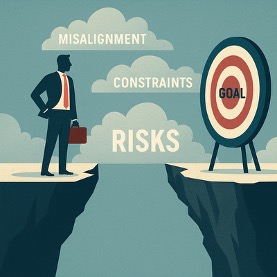 Participants will be equipped to develop targeted strategies to close priority gaps with a focus on both impact and feasibility. They will explore how to design interventions that align with enterprise goals while also respecting constraints such as budget, time, and organizational capacity. This includes building phased execution plans, identifying required resources, and defining ownership structures. Participants will practice sequencing initiatives and evaluating trade-offs to ensure that the most important gaps are addressed first. The goal is not to fix everything at once but to create a prioritized, strategic roadmap that builds momentum and credibility.
Participants will be equipped to develop targeted strategies to close priority gaps with a focus on both impact and feasibility. They will explore how to design interventions that align with enterprise goals while also respecting constraints such as budget, time, and organizational capacity. This includes building phased execution plans, identifying required resources, and defining ownership structures. Participants will practice sequencing initiatives and evaluating trade-offs to ensure that the most important gaps are addressed first. The goal is not to fix everything at once but to create a prioritized, strategic roadmap that builds momentum and credibility.
This module will also help participants learn how to integrate gap analysis into broader strategic planning and governance cycles. Rather than treating gap assessments as a one-time activity, participants will learn how to embed them into quarterly planning, annual budget reviews, project gating decisions, and executive steering committee updates. This recurring use of gap analysis ensures that strategies remain grounded in current-state realities and that assumptions are regularly revisited and validated. It creates a culture of adaptive execution where feedback drives continuous improvement and alignment.
Finally, participants will learn how to translate diagnostic insights into a focused improvement roadmap. This roadmap will serve as a communication tool to engage stakeholders, secure resources, and track progress. Participants will practice developing gap closure plans that define actions, assign accountability, establish timelines, and outline success criteria. They will explore how to use dashboards, visual management tools, and storytelling techniques to ensure that the roadmap inspires ownership and action across the organization. By the end of the module, participants will have built the confidence and capability to lead gap analysis not just as a tactical exercise but as a strategic discipline that supports enterprise alignment and drives transformation forward.
Content Overview
In this module, participants will develop the analytical mindset and practical skill set required to diagnose and close the gaps that prevent organizations from reaching their strategic objectives. Gap analysis serves as the connective tissue between vision and execution. It ensures that bold aspirations are grounded in operational reality and supported by tangible, measurable capabilities. While strategic ambition is essential, it must be tempered with clarity about what an organization can do today and what it must develop or acquire to succeed in the future. This module provides a structured framework for understanding and closing those gaps.
We begin by establishing the different types of gaps that affect strategic decision-making. These include capability gaps which refer to what the organization cannot yet do effectively or at scale. Performance gaps arise when current activities are being executed inefficiently or below standard. Process gaps emerge from broken workflows, outdated systems, or misaligned cross-functional handoffs. Finally, resource gaps occur when the organization lacks the budget, tools, skills, or capacity needed to execute its goals. Participants will explore how these gaps interact across departments and functions. For example, a resource gap in IT staffing might be contributing to a broader capability gap in data analytics. Or a process gap in product development might be causing performance issues in speed to market.
The module highlights how these types of gaps are particularly relevant in initiatives related to digital transformation, product innovation, and cultural alignment. In transformation work, for example, the organization might have a strong vision for modernizing its infrastructure but lack the cloud governance or DevOps maturity to support deployment. In innovation efforts, product teams might generate compelling ideas but be constrained by rigid compliance processes or legacy systems. In culture change initiatives, leaders may articulate a vision of inclusivity or agility but fail to address deep-seated behaviors and incentive systems that perpetuate status quo thinking. By categorizing gaps across these domains, participants learn to take a holistic view of organizational readiness and intervene with specificity.
The module introduces a blend of classic and modern diagnostic tools that help leaders systematically identify and prioritize gaps. McKinsey’s 7-S Framework is used to examine the interdependencies between structure, strategy, systems, style, staff, skills, and shared values. Participants learn how misalignment across any of these dimensions can reveal hidden weaknesses that inhibit strategic progress. The Strategic Capability Matrix is introduced as a way to map required versus existing capabilities and plot investment decisions accordingly. A newly designed Decision Alignment Map helps technology leaders assess how decision-making processes, incentives, and authority structures either support or obstruct strategic execution. These tools are paired with real-world case examples that show how small misalignments, left unresolved, can compound over time and derail even well-resourced transformation programs.
Participants will engage in a series of interactive reflection exercises and peer simulations to sharpen their diagnostic instincts. They will assess internal capabilities through structured inventories and self-assessment models. They will map cross-functional dependencies to uncover hidden bottlenecks. They will also simulate trade-offs between speed and scale, innovation and risk, autonomy and control. These hands-on activities bring the tools to life and help participants internalize the process of strategic diagnosis. For example, one exercise may involve analyzing a stalled AI implementation and tracing the root causes to overlapping ownership, incomplete training plans, and misaligned KPIs. Another simulation may ask participants to role-play a leadership team negotiating investment priorities based on gap heatmaps and capability maturity scores.
Throughout the module, participants will explore how to lead constructive conversations about gaps without creating defensiveness or blame. They will practice presenting gap findings using visual models such as radar charts, maturity curves, and capability dashboards. They will also explore how to build psychological safety around diagnostic efforts by clearly framing them as learning exercises rather than audits. Emphasis is placed on facilitation skills, communication tone, and question design. Leaders will explore how to ask better questions such as What assumptions are we making about our readiness and What signals suggest we may not be as prepared as we think. These inquiry techniques help surface systemic barriers that may not be obvious in traditional reporting.

The content emphasizes the importance of translating gap analysis into targeted action. Participants will learn how to develop action plans that are focused, feasible, and aligned to organizational priorities. They will practice creating closure plans that define specific actions, success measures, timelines, and resource requirements. They will also explore how to align these plans with stakeholder expectations and governance rhythms. The goal is not to fix everything at once but to drive strategic clarity and momentum by addressing the most critical barriers to progress. Participants will also be encouraged to think in terms of sequencing—addressing foundational gaps first to unlock downstream gains.
Another core theme is the integration of gap analysis into ongoing strategy cycles. Rather than treating diagnosis as a one-time prelude to planning, participants learn how to embed it into quarterly business reviews, initiative health checks, and transformation retrospectives. They will explore how to use gap data as a continuous feedback loop to recalibrate strategies and refine roadmaps. For example, a dashboard showing declining readiness in cybersecurity practices might prompt a reallocation of funding during an annual planning cycle. This ongoing integration ensures that gap analysis becomes a strategic reflex rather than a reactive fix.
The module concludes with a focus on capability building. Participants will reflect on the role of leadership in building not only systems but also mindsets that embrace diagnostic rigor. They will explore how to create cultures where asking what is missing is valued as much as celebrating what is achieved. This includes fostering team habits of regular reflection, postmortems, and lessons learned. By embedding gap analysis into team rituals and leadership routines, participants help shift the organization toward continuous alignment and improvement.
By the end of this module, participants will have a deep appreciation for gap analysis as a leadership discipline that unites strategic clarity with operational realism. They will be equipped to identify what is missing, prioritize what matters most, and lead their teams through structured improvement. Gap analysis becomes more than a tool. It becomes a way of thinking that supports transparency, focus, and strategic coherence in an ever-changing environment.

Case Study: Audi’s Digital Transformation and Strategic Capability Gaps
Audi AG, part of the Volkswagen Group, is a premium German automaker known for its design, engineering precision, and commitment to innovation. In the 2010s, as the automotive industry faced disruption from electrification, digitalization, and autonomous technologies, Audi launched a sweeping digital transformation initiative to remain competitive in a future defined by software and mobility services.
Audi’s future vision was encapsulated in its corporate strategy “Vorsprung 2030” (Advancement 2030), which aimed to shift the company from a traditional automotive manufacturer to a software-driven mobility provider, with bold goals around sustainability, electrification, and customer experience innovation.
As Audi implemented this new vision, it conducted an in-depth strategic gap analysis across its operations using two key frameworks:
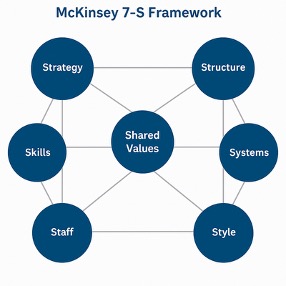
McKinsey 7-S Framework (Strategy, Structure, Systems, Skills, Staff, Style, Shared Values)
Strategic Capability Matrix (Internal capability vs. external market demand)
The Key Gaps Identified included:
• Skills Gap:
– Audi’s workforce was heavily skewed toward mechanical engineering and lacked sufficient expertise in AI, cloud computing, and software development.
– To close this gap, Audi invested €500 million in upskilling employees and created the Audi.AI think tank, recruiting hundreds of data scientists and engineers.
• System Gap:
– Legacy IT systems were not designed for scalable over-the-air updates or real-time data collection from vehicles.
– Audi partnered with Amazon Web Services (AWS) to build a cloud-native infrastructure for vehicle data services.
• Structural Misalignment:
– Traditional silos between engineering, R&D, and software led to inefficiencies in innovation cycles.
– Audi launched Artemis, an internal agile unit, tasked with developing new EV platforms faster by bypassing bureaucratic bottlenecks.
• Style & Leadership Culture:
– The culture was hierarchical and risk-averse, misaligned with the experimental ethos required for digital product development.
– Leadership implemented new KPIs tied to innovation velocity and customer-centricity to reinforce behavioral change.
• Customer Experience Gap:
– As Tesla and other competitors raised customer expectations with seamless digital interfaces, Audi’s customer touchpoints lagged behind.
– Audi responded by launching a fully digital car-buying experience in select markets and integrating personalized infotainment systems in their EV lineup.
By systematically identifying and addressing these strategic gaps, Audi achieved several key milestones:
-Launched the Audi e-tron family of electric vehicles, with 30% of its global lineup now electric.
-Reduced time-to-market for new EV platforms by 50% through the Artemis initiative.
-Established new revenue streams through connected services and data monetization.
This case demonstrates that gap analysis is not just a diagnostic tool—it is a catalyst for transformation. Audi’s success came from:
-Tying capability assessments directly to bold strategic outcomes,
-Investing in both people and platforms,
-And creating agile structures to enable sustained innovation.
For leaders driving transformation, closing the gap between vision and readiness is the difference between relevance and obsolescence.

Group Exercise: Gap Analysis for Strategic Decision-Making
As a group, choose one strategic initiative relevant to your organization, clearly stating the goal and its business importance.
Briefly describe the ideal outcome when your initiative is fully realized, focusing on:
-Key capabilities
-Essential technologies
-One measurable success metric
-Assess your current readiness in these three areas:
-Infrastructure (tools and systems)
-Talent & skills
-Governance & processes
Identify one major gap for each area rated Moderate or Needs Improvement.
-For each identified gap, list one immediate action to close it, specifying:
-Action
-Responsible stakeholder
-Desired quick-win outcome
Ensure actions are clear, achievable, and directly address your strategic gaps.
Summary
Gap analysis serves as a strategic bridge between vision and execution. By systematically identifying misalignments between an organization’s current capabilities and its future objectives, technology leaders can prioritize investments, mitigate risks, and drive focused transformation. This module has equipped participants with proven frameworks, real-world case examples, and a guided group exercise to practice diagnosing readiness and mobilizing change. Whether launching a new digital platform or scaling an AI initiative, leaders who master gap analysis are better positioned to make informed decisions, optimize resources, and build resilient, future-ready organizations.

Course Manual 5: Prioritizing Technology Initiatives (PTI)
Introduction
In the dynamic realm of technology leadership, vision and foresight alone are insufficient. The true differentiator is execution, specifically the ability to choose the right initiatives to pursue at the right time. With finite resources, increasing complexity, and a rapidly shifting landscape, organizations must be intentional about where they invest their time, capital, and talent. This module addresses that critical challenge by focusing on how to systematically evaluate, prioritize, justify, and sequence technology initiatives to drive enterprise value. It supports leaders in aligning technology decisions with overarching strategy while maintaining the flexibility required to adapt in fast-paced, competitive markets. Making these decisions effectively is what often separates high-impact technology leaders from those who simply manage backlogs.
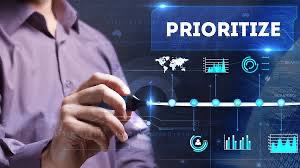 Strategic prioritization goes beyond ranking a list of projects. It is a core leadership function that requires analytical rigor, contextual intelligence, and a deep understanding of organizational capacity and ambition. It involves making disciplined tradeoffs and confronting the reality that not every desirable initiative can or should be pursued. Without a clear prioritization framework, organizations risk spreading themselves too thin, delaying critical outcomes, or missing key market opportunities. Ineffective prioritization often results in initiative overload, disengaged teams, redundant investments, and strategic drift. Prioritization also plays a key role in organizational resilience, as it forces decision-makers to revisit assumptions and dynamically adjust as new information or disruptions arise.
Strategic prioritization goes beyond ranking a list of projects. It is a core leadership function that requires analytical rigor, contextual intelligence, and a deep understanding of organizational capacity and ambition. It involves making disciplined tradeoffs and confronting the reality that not every desirable initiative can or should be pursued. Without a clear prioritization framework, organizations risk spreading themselves too thin, delaying critical outcomes, or missing key market opportunities. Ineffective prioritization often results in initiative overload, disengaged teams, redundant investments, and strategic drift. Prioritization also plays a key role in organizational resilience, as it forces decision-makers to revisit assumptions and dynamically adjust as new information or disruptions arise.
Participants will begin the module by exploring the foundational importance of prioritization in strategic execution. They will analyze common pitfalls in technology portfolio management, such as the lack of criteria for evaluating proposals, limited stakeholder engagement in prioritization decisions, and failure to revisit priorities as conditions change. Real-world examples are used to highlight how flawed prioritization undermines transformation efforts, whereas clear and disciplined prioritization leads to focused momentum, resource efficiency, and higher ROI. Through case studies, participants will see how companies that effectively prioritize can gain a first-mover advantage, streamline innovation, and drive competitive differentiation over time.
The module introduces a suite of tools and methods to support structured decision-making. These include the Eisenhower Matrix, which helps leaders categorize initiatives based on urgency and importance. The MoSCoW method, which segments initiatives into must-have, should-have, could-have, and will-not-have categories, provides clarity on non-negotiables versus tradeoffs. The Value versus Complexity Matrix supports risk-adjusted decisions by evaluating the strategic value and technical or organizational complexity of proposed initiatives. Leaders learn how to apply these models to technology-specific contexts such as enterprise platform modernization, data lake development, customer-facing application rollouts, or AI capability pilots. These frameworks enable structured thinking in the face of ambiguity and provide shared language across technical and non-technical stakeholders.
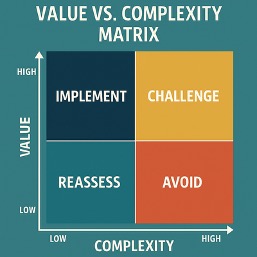 Participants will engage in exercises that simulate prioritization decision points. For instance, one scenario may require allocating a limited technology budget across a dozen competing proposals including a cybersecurity upgrade, a marketing automation tool, a legacy system refactor, and a new data analytics platform. Participants must assess each initiative based on multiple criteria including strategic alignment, impact potential, cost, resource availability, timing, and readiness. These simulations surface real-world tensions and force participants to navigate competing stakeholder interests, risk trade-offs, and timing constraints. Facilitated debriefs help participants understand the long-term consequences of short-term trade-offs and sharpen their ability to lead under pressure.
Participants will engage in exercises that simulate prioritization decision points. For instance, one scenario may require allocating a limited technology budget across a dozen competing proposals including a cybersecurity upgrade, a marketing automation tool, a legacy system refactor, and a new data analytics platform. Participants must assess each initiative based on multiple criteria including strategic alignment, impact potential, cost, resource availability, timing, and readiness. These simulations surface real-world tensions and force participants to navigate competing stakeholder interests, risk trade-offs, and timing constraints. Facilitated debriefs help participants understand the long-term consequences of short-term trade-offs and sharpen their ability to lead under pressure.
The module also focuses on the human side of prioritization. It is not enough to apply analytical frameworks. Leaders must also build consensus and communicate the rationale behind prioritization decisions in a way that earns trust and commitment. Participants explore how to lead prioritization conversations with transparency, empathy, and confidence. They practice engaging stakeholders in structured dialogue that surfaces assumptions, reveals hidden dependencies, and clarifies non-negotiables. Role-play sessions simulate executive committee meetings where competing business units advocate for their initiatives. Participants learn to guide the group toward aligned decisions without defaulting to the loudest voices or highest political capital. This section underscores the importance of inclusive facilitation, especially when balancing innovation with business continuity.
Adaptability is a key theme throughout the module. Technology priorities cannot be static in a world of disruption. Participants will explore how to create adaptive prioritization systems that incorporate real-time feedback and allow for responsive reprioritization. This includes setting regular portfolio review cadences, defining pivot triggers, and implementing rolling planning cycles. Leaders will learn how to differentiate between temporary disruptions and systemic shifts, enabling smarter recalibration without destabilizing execution teams. Agile principles are woven into this discussion, with emphasis on how to use backlog grooming, sprint planning, and program increment (PI) planning to maintain alignment. The ability to pivot intelligently is what separates reactive organizations from those that respond with clarity and purpose.
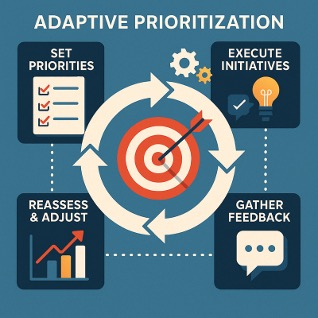 The module emphasizes integration with other strategic disciplines explored in earlier modules. Foresight and scenario planning provide context for future conditions that influence prioritization. Strategic alignment ensures that initiatives map to business goals. Gap analysis helps clarify which initiatives address critical capability shortfalls. Prioritization brings these insights into decision-making and sequencing. Participants will practice using prioritization frameworks as connective tissue that bridges vision with delivery and ensures investments remain focused and coherent. This cross-functional integration reinforces the message that prioritization is not just about IT. It is about creating value across the entire enterprise.
The module emphasizes integration with other strategic disciplines explored in earlier modules. Foresight and scenario planning provide context for future conditions that influence prioritization. Strategic alignment ensures that initiatives map to business goals. Gap analysis helps clarify which initiatives address critical capability shortfalls. Prioritization brings these insights into decision-making and sequencing. Participants will practice using prioritization frameworks as connective tissue that bridges vision with delivery and ensures investments remain focused and coherent. This cross-functional integration reinforces the message that prioritization is not just about IT. It is about creating value across the entire enterprise.
Data-driven decision-making is another critical element. Participants will explore how to use business cases, quantitative models, and strategic scorecards to support prioritization. They learn how to define and weigh evaluation criteria such as customer impact, revenue enablement, cost avoidance, compliance value, and brand relevance. Participants are introduced to prioritization scoring tools and dashboards that make decision tradeoffs visible and auditable. They also learn how to balance quantitative rigor with qualitative insights gathered from frontline teams, customer feedback, and executive intuition. This dual-lens approach ensures that prioritization remains both evidence-based and grounded in business context.
Participants will leave the module with a repeatable process for prioritizing technology investments. This includes steps such as setting evaluation criteria, collecting initiative proposals, conducting structured scoring, facilitating review workshops, and building executive consensus. They will also receive templates for visual prioritization tools and communication briefs to support alignment during and after decision-making. Participants are encouraged to develop a prioritization playbook tailored to their organizational context, including governance touchpoints, stakeholder roles, escalation paths, and feedback mechanisms. Having a playbook ensures consistency in how prioritization is approached, even during leadership transitions or organizational change.
As part of their applied learning, participants will draft a prioritization roadmap for an active or upcoming initiative in their organization. This roadmap will outline how decisions will be made, who will be involved, what data will be collected, and how the outcomes will be tracked and communicated. This applied exercise bridges theory and practice and gives participants immediate utility they can take back to their teams. The roadmap becomes a living document that fosters shared ownership and clarity as initiatives move forward.
By the end of this module, participants will be able to balance bold strategic intent with pragmatic execution discipline. They will understand how to choose the right technology investments, allocate resources with confidence, and build stakeholder support for difficult decisions. Prioritization will no longer be a periodic headache. It will become a continuous leadership practice that sharpens focus, accelerates progress, and reinforces enterprise alignment. Leaders will emerge with a clear lens to assess what matters most and the tools to act on that insight decisively and consistently. They will also be prepared to lead others in navigating ambiguity and pressure with structured thinking, confident communication, and adaptive planning.
Learning Objectives
By the end of this module, participants will understand the importance of aligning technology initiatives with strategic business objectives. They will gain clarity on how technology is not an isolated function but a core enabler of enterprise value. This includes recognizing the direct and indirect ways in which digital investments drive revenue growth, operational efficiency, customer experience, compliance, and innovation. Participants will explore how organizations that treat technology strategy as an extension of business strategy are more likely to achieve cohesion, relevance, and scalability in their programs. Through case examples and peer dialogue, they will identify the markers of strong alignment and the warning signs of misaligned or redundant technology initiatives. Leaders will learn to engage with executive peers to co-create technology priorities that directly support key business imperatives.
Participants will also learn to identify and assess key criteria for prioritizing initiatives. These criteria include impact, which measures the strategic and operational value of an initiative; feasibility, which assesses organizational readiness and technical complexity; urgency, which reflects timing considerations or market-driven pressures; and stakeholder alignment, which evaluates the level of buy-in across business functions. Participants will explore how each of these dimensions contributes to prioritization clarity. Exercises will challenge them to weigh multiple criteria simultaneously and assess where subjective perceptions differ from empirical data. Participants will also learn how to avoid prioritization traps such as pet projects, sunk cost bias, and prioritizing based solely on political influence. This enables more equitable and transparent decision-making.
Participants will apply structured prioritization tools such as the effort impact matrix and weighted scoring models. They will learn to design scoring rubrics based on their organization’s unique strategy, culture, and constraints. Through guided exercises, they will practice applying these tools to active portfolios or hypothetical scenarios. The effort impact matrix will help participants quickly surface low-hanging fruit, transformational bets, and high-cost distractions. Weighted scoring models will allow them to quantify initiative value across custom criteria and facilitate cross-functional comparison. These tools equip leaders with repeatable, evidence-based methods to support prioritization in executive discussions and planning cycles.
The module will also help participants evaluate the tradeoffs between short-term wins and long-term value creation. Leaders often face the pressure to deliver visible outcomes quickly while still investing in foundational capabilities that drive durable competitive advantage. This module provides strategies for balancing those demands. Participants will examine cases where organizations sacrificed long-term success for short-term optics and vice versa. They will learn how to sequence initiatives, stage investments, and build roadmaps that demonstrate both near-term momentum and long-term strategic relevance. Leaders will gain confidence in advocating for long-view investments by connecting them to quantifiable risk mitigation, scalability, or innovation potential.
 Participants will learn to design a portfolio of initiatives that balances innovation, risk, and resource constraints. They will explore how to segment initiatives by risk appetite, business model maturity, or customer impact. Through interactive portfolio mapping exercises, they will categorize initiatives by exploratory, exploitative, and enabling focus areas. Participants will examine how to avoid over-indexing on either core efficiency initiatives or speculative innovation without a sustainable funding or staffing model. By the end of this section, participants will be equipped to rationalize portfolios, sunset low-value projects, and justify new initiatives with clarity and confidence. They will also learn how to identify interdependencies and align execution timelines to avoid overextension.
Participants will learn to design a portfolio of initiatives that balances innovation, risk, and resource constraints. They will explore how to segment initiatives by risk appetite, business model maturity, or customer impact. Through interactive portfolio mapping exercises, they will categorize initiatives by exploratory, exploitative, and enabling focus areas. Participants will examine how to avoid over-indexing on either core efficiency initiatives or speculative innovation without a sustainable funding or staffing model. By the end of this section, participants will be equipped to rationalize portfolios, sunset low-value projects, and justify new initiatives with clarity and confidence. They will also learn how to identify interdependencies and align execution timelines to avoid overextension.
Finally, participants will learn how to communicate prioritization decisions effectively across cross-functional teams. This includes articulating the why behind choices, not just the what. Leaders will practice using storytelling, scorecard visuals, and sequencing logic to frame decisions in ways that resonate with stakeholders from diverse functions such as operations, marketing, legal, and finance. They will explore how to manage reactions to reprioritization, maintain team morale, and foster trust even when tough tradeoffs are required. Special focus will be placed on aligning prioritization conversations with organizational values and cultural tone. By mastering communication, participants ensure that prioritization becomes a collaborative practice rather than a top-down directive, increasing execution success and stakeholder buy-in.
Content Overview
The module begins by addressing a universal challenge faced by modern technology leaders: the problem of overload. With countless initiatives vying for attention and finite time, money, and talent to support them, organizations often find themselves stuck in a reactive cycle. In this environment, it is easy to default to decision-making based on the loudest voice in the room, the most politically influential stakeholder, or the flashiest trend. Leaders are introduced to common traps such as chasing innovation for its own sake, neglecting initiatives that yield long-term value, or relying on HiPPO decisions—the Highest Paid Person’s Opinion—rather than data or structured analysis. Participants explore how these traps undermine enterprise performance and erode team focus. Through real-world case examples, they study failed initiatives that consumed resources but delivered little impact, as well as success stories where rigorous prioritization created clarity, efficiency, and momentum.
To combat these pitfalls, participants are introduced to a suite of prioritization frameworks that enable them to evaluate initiatives using structured, transparent, and repeatable methods. These frameworks are applied in practice through group exercises, case simulations, and strategic planning scenarios. Each framework is positioned within a broader context of organizational readiness, stakeholder dynamics, and execution feasibility. By exploring each model in depth, participants are empowered to choose the tool that best fits their leadership environment and maturity level.
One of the first frameworks introduced is the Eisenhower Matrix. Originally developed for military and productivity planning, it helps leaders distinguish between urgent and important initiatives. Urgent initiatives require immediate attention but may not always align with long-term strategy. Important initiatives contribute directly to strategic goals but may not present themselves as pressing. Participants learn to map their initiatives across four quadrants: Important and Urgent, Important but Not Urgent, Not Important but Urgent, and Not Important and Not Urgent. This exercise helps teams recognize where they are spending disproportionate time on fire drills or low-impact tasks. By rebalancing their portfolios, participants gain insight into how to create more capacity for strategic priorities while managing immediate operational demands.
The module then explores RICE scoring, a prioritization model particularly popular in product management and agile environments. RICE stands for Reach, Impact, Confidence, and Effort. Participants learn how to assign numeric values to each of these components for a given initiative. Reach represents the number of people or transactions that the initiative is expected to affect. Impact estimates the degree of improvement the initiative will bring, often using a standardized scale. Confidence gauges how certain the team is about the impact and effort estimates. Effort captures the time or complexity involved in delivering the initiative. By calculating a RICE score, participants are able to rank initiatives not just on perceived value but on objective data. Exercises illustrate how this method helps reduce emotional bias and allows teams to compare projects of varying sizes on a common scale. RICE scoring also enables lean decision-making, especially in environments where data is available but must be interpreted with judgment.
Weighted Scoring Models are then introduced as one of the most flexible and customizable frameworks available. Participants are taught to define a list of evaluation criteria such as strategic alignment, potential ROI, level of innovation, compliance requirement, operational risk, or customer impact. Each criterion is then assigned a weight based on organizational priorities. For example, a company undergoing digital transformation might give higher weight to innovation and scalability, while a regulated industry might prioritize compliance and risk mitigation. Initiatives are then scored against each criterion, and the total weighted scores provide a prioritized ranking. This approach enables collaborative decision-making, especially in cross-functional settings where different stakeholders care about different outcomes. Participants also explore how to use weighted scoring models to support executive governance forums by making tradeoffs more visible and auditable.
MoSCoW prioritization is another tool explored in depth. This model segments initiatives into four categories: Must-haves, Should-haves, Could-haves, and Will-not-haves (at least for now). Participants learn how to facilitate MoSCoW conversations to quickly identify the non-negotiables versus the flexible features or programs. This model is especially helpful in situations with limited time or resources such as sprint planning, quarterly reviews, or roadmap refresh sessions. Participants are guided through simulated MoSCoW exercises where they must balance conflicting priorities from product, compliance, customer, and finance perspectives. They learn how to apply discipline to scope definition while remaining adaptable to feedback. The simplicity of MoSCoW makes it an effective tool for fast-moving environments, but the module also cautions against overuse or lack of rigor in defining categories.
In addition to these models, the module offers strategies for integrating prioritization into ongoing leadership rhythms. Participants are encouraged to view prioritization not as a static event but as a recurring dialogue. They explore how to embed prioritization into quarterly business reviews, sprint planning cadences, and program increment (PI) cycles. Emphasis is placed on the importance of setting evaluation criteria upfront and revisiting them regularly as strategies evolve. Participants are introduced to portfolio management dashboards and initiative tracking templates that help maintain visibility across multiple time horizons.
A significant portion of the module is dedicated to applying these frameworks to real-world case studies. For example, participants may analyze how a healthcare company used weighted scoring to phase a multi-year digital transformation. Another case may showcase how a retail firm used the Eisenhower Matrix to identify operational drains that were delaying strategic innovation. Participants dissect what worked, what failed, and what could be adapted to their own contexts. These examples serve to demystify the tools and highlight their practical application across different industries.
The module also provides guidance on selecting the right prioritization method based on organizational maturity, culture, and urgency. For high-velocity teams with lean governance, RICE or MoSCoW might be ideal. For enterprise programs involving multiple departments and funding gates, weighted scoring models provide more depth and rigor. Participants are encouraged to build a prioritization toolkit that can be flexibly deployed as conditions demand.
Throughout the module, participants reflect on their current prioritization processes and identify opportunities for improvement. They conduct a maturity self-assessment to evaluate whether prioritization is ad hoc, process-driven, or strategically embedded. Leaders are challenged to consider how to evolve their approach so that prioritization becomes a team discipline supported by data, facilitated by shared language, and reinforced through consistent action.
By the end of the module, participants will not only have a deeper understanding of prioritization frameworks, but also the confidence to lead prioritization sessions, advocate for evidence-based choices, and link prioritization outcomes to enterprise impact. They will leave equipped with practical templates, sample scorecards, and a prioritization roadmap tailored to their organization’s goals and constraints. Ultimately, the module reinforces that great strategy is not just about deciding what to do—it is equally about deciding what not to do and when to do it. This clarity of focus is what enables high-performing organizations to move faster, with greater purpose and fewer regrets.
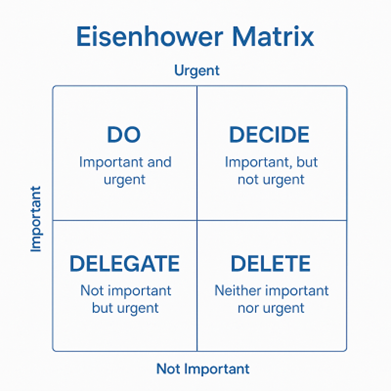
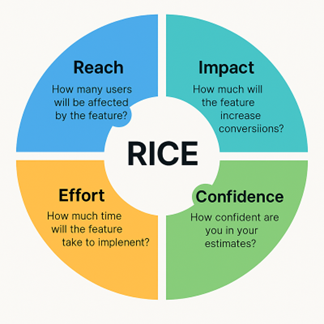
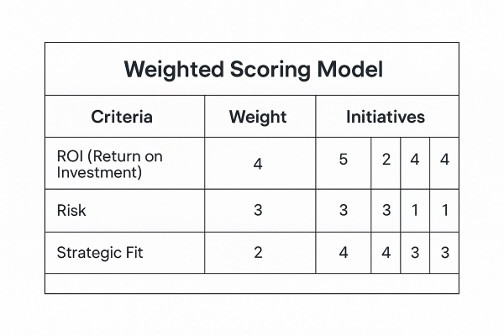
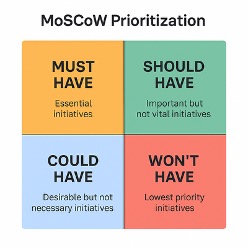
Participants are guided through selecting the right framework for their context and building custom criteria that reflect organizational goals, capacity, and culture. They then apply these tools to a portfolio of real or simulated initiatives.
The module also addresses stakeholder alignment. Participants learn how to present prioritization outcomes in ways that build trust, gain buy-in, and navigate conflicts. Techniques include creating initiative dashboards, trade-off discussions, and multi-scenario modeling.
Finally, the module focuses on sequencing initiatives. Participants learn to build implementation roadmaps that account for interdependencies, quick wins, high-risk projects, and change management timelines.
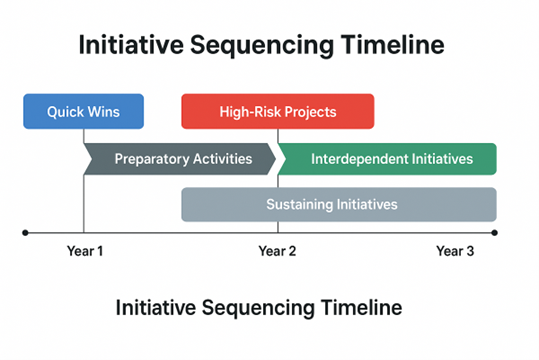

Case Study: Intel’s Transformation Through Strategic Prioritization of Technology Initiatives
Intel Corporation, the global semiconductor leader, offers a compelling example of how prioritizing technology initiatives at scale can drive strategic clarity, turnaround performance, and future readiness.
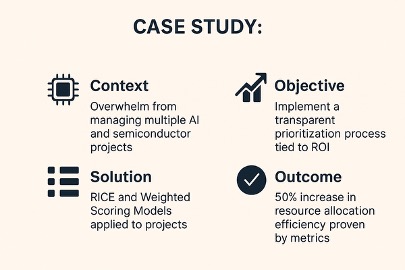
By 2021, Intel was facing mounting pressure from multiple directions: lagging behind in chip manufacturing innovation, rising competition from AMD and ARM-based architectures, and increasing investor dissatisfaction. Internally, the company was weighed down by fragmented R&D investments, overcommitment to low-impact projects, and a culture resistant to change. The absence of clear initiative prioritization had diluted execution across critical business units.
Pat Gelsinger, appointed CEO in 2021, initiated a sweeping strategic overhaul with a sharp focus on prioritization. His first move was to publicly reframe Intel’s long-term vision: to regain process leadership in chip manufacturing by 2025 and become a global leader in foundry services. To deliver on this vision, Intel would need to streamline its sprawling portfolio of technology investments.
Intel’s leadership used a three-tiered prioritization approach to manage over 200 R&D initiatives:
1. Portfolio Categorization
Projects were grouped into three categories: core (sustain current operations), strategic (support transformation goals), and exploratory (early-stage innovation). Each initiative was evaluated for its alignment with business outcomes, using a weighted scoring model based on:
-Technical differentiation potential
-Revenue impact (near- and long-term)
-Synergy with manufacturing roadmap
-Ecosystem dependency (e.g., foundry customers, OEMs)
Scores were calibrated through both leadership consensus and empirical data, including customer co-development signals.
2. Resource Reallocation and Sequencing
With categorization complete, Intel shifted billions of dollars from underperforming or duplicative programs toward priority initiatives. For example:
-Non-core investments in consumer-facing AI tools were deprioritized.
-Resources were rechanneled into advanced node development (e.g., Intel 4 and Intel 3 process technologies).
-Emerging technologies like RibbonFET and PowerVia were fast-tracked with cross-functional acceleration teams.
These moves were visualized in a company-wide roadmap, updated quarterly, and integrated into performance reviews for product leaders.
3. Transparent Decision Governance
Intel established a new Technology Development Governance Council (TDGC) composed of senior leaders across engineering, manufacturing, and product management. This group met monthly to evaluate proposed changes to the priority portfolio, using a dashboard that tracked initiative progress, milestones, and risk exposure.
One of the most significant outcomes of this prioritization was the launch of Intel Foundry Services (IFS), a new division that positioned Intel as a third-party manufacturer for other chipmakers. Although controversial internally, the decision was supported by deep market analysis, high revenue upside, and geopolitical tailwinds around semiconductor independence. It was classified as a “strategic moonshot” and prioritized accordingly.
Another example was Intel’s exit from non-core businesses. In 2022, the company divested its Optane memory business and winded down efforts in drone technology—moves that freed up capital and leadership focus for mission-critical efforts.
This rigorous approach yielded measurable outcomes:
-Intel’s 2023 financial results showed stabilization in margin pressure and improved capital efficiency.
-Engineering velocity improved, with Intel 4 entering production as scheduled.
-Organizational alignment increased through clearer initiative ownership and visibility.
Lessons for Technology Leaders:
-Prioritization must be linked to both financial impact and strategic vision.
-Frameworks like weighted scoring, portfolio categorization, and sequencing tools are essential in environments with high complexity.
-Governance mechanisms like cross-functional steering councils ensure agility without chaos.
-Saying “no” to projects—particularly ones with internal champions—requires cultural courage and strong executive alignment.
Intel’s transformation demonstrates that prioritization is not simply a tactical exercise. It is a strategic discipline that, when executed well, can become the lever that restores relevance, drives innovation, and reallocates energy to the future.

Group Exercise: Prioritization Strategy Lab
-Your organization’s main business priority
-One key resource constraint or limitation
-Customer Data Platform (CDP)
-AI-Based Demand Forecasting Tool
-Mobile App Redesign
For each initiative, rate from 1 (lowest) to 5 (highest) on:
-Strategic alignment
-Immediate business impact
-Ease of implementation
-Together, briefly outline:
-Your top-priority initiative
-One immediate action step to begin implementation
-One stakeholder critical for success
Confirm your chosen priority is clear, justified, and actionable.
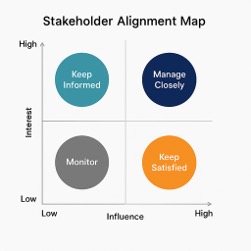
Summary
This module equips technology leaders with the tools and mindset to make strategic decisions when faced with competing initiatives. By applying structured prioritization frameworks such as the Eisenhower Matrix, RICE scoring, and Weighted Scoring Models, participants learn how to assess urgency, impact, feasibility, and alignment with business goals. Through detailed case studies and hands-on group exercises, leaders gain confidence in making trade-offs, managing resources, and sequencing technology efforts that deliver measurable value. Prioritization emerges as a critical leadership capability that ensures clarity, focus, and resilience in execution.

Course Manual 6: Scenario Planning for Agility (SPA)
Introduction
In an era marked by volatility uncertainty complexity and ambiguity traditional planning models often fall short. Linear forecasts and static roadmaps can no longer keep pace with the rapid evolution of markets technologies regulations and societal expectations. Scenario planning has emerged as a powerful discipline that allows leaders to embrace uncertainty stretch their thinking and make better decisions under conditions of change and disruption. This module explores scenario planning as both a strategic mindset and a practical toolkit that enables technology leaders to prepare for multiple possible futures rather than betting on a single prediction. It encourages participants to shift from reactive decision making to proactive anticipation equipping them to manage not only risk but also opportunity. As external forces become increasingly complex the ability to navigate ambiguity with composure becomes a defining trait of effective leadership.
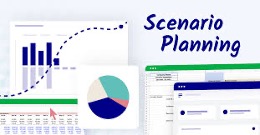 Scenario planning is not about predicting the future. Rather it is about preparing for plausible variations of it. It enables leaders to ask What if and to challenge the assumptions that often go unquestioned in strategic conversations. Participants will learn how to craft structured scenarios that illustrate different combinations of external drivers, internal choices and system dynamics. These scenarios serve as cognitive rehearsal tools allowing teams to anticipate emerging challenges rehearse potential responses and evaluate the resilience of their current strategies. In doing so scenario planning shifts organizations from a posture of control to one of adaptability. It also sharpens foresight by exposing decision makers to multiple perspectives and longer time horizons.
Scenario planning is not about predicting the future. Rather it is about preparing for plausible variations of it. It enables leaders to ask What if and to challenge the assumptions that often go unquestioned in strategic conversations. Participants will learn how to craft structured scenarios that illustrate different combinations of external drivers, internal choices and system dynamics. These scenarios serve as cognitive rehearsal tools allowing teams to anticipate emerging challenges rehearse potential responses and evaluate the resilience of their current strategies. In doing so scenario planning shifts organizations from a posture of control to one of adaptability. It also sharpens foresight by exposing decision makers to multiple perspectives and longer time horizons.
Participants begin by exploring the origins and principles of scenario planning including its use in military strategy energy forecasting and long-range innovation planning. They study how early pioneers like Royal Dutch Shell used scenario planning to prepare for geopolitical shocks in the oil industry and how companies today apply similar techniques to navigate the uncertainties of climate regulation technological disruption or shifting customer values. Scenario planning is positioned as a method for strategic agility helping leaders stay grounded in purpose while remaining flexible in tactics. The historical context helps participants understand that scenario planning has always been about high stakes high uncertainty decisions. By tracing its evolution, they recognize how its application can be customized across different industries and organizational scales.
The module then guides participants through the scenario creation process. This begins with identifying a focal question such as How will AI adoption reshape our industry or What forces could disrupt our supply chain in the next five years. From there participants conduct a structured environmental scan using frameworks like PESTLE or STEEP to identify relevant external drivers. These might include changes in political leadership economic cycles social behavior shifts technological innovation environmental risks and regulatory trends. Participants assess the degree of uncertainty and potential impact of each driver and use this analysis to define key uncertainties that form the axes of their scenarios. Special attention is given to distinguishing between predetermined elements that are likely to happen and critical uncertainties that will shape how futures unfold. This process ensures that scenarios are not speculative guesses but grounded projections that still allow for diverse and imaginative exploration.
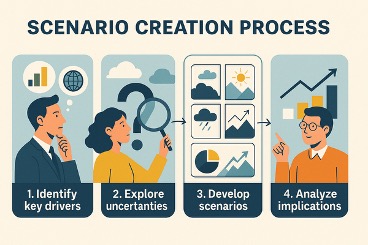
With these key uncertainties in hand participants develop a set of contrasting scenario narratives. For example a digital healthcare platform might develop one scenario where telemedicine becomes mainstream and reimbursable by all insurers and another scenario where regulatory pushback limits adoption to niche segments. Each scenario is described in a vivid narrative that captures how trends interact what opportunities and threats emerge and how the competitive landscape shifts. Participants learn to make scenarios both imaginative and plausible balancing creative thinking with rigorous logic. They are encouraged to include stakeholders from different functions or geographies in the scenario creation process to surface diverse perspectives. Visual storytelling tools and narrative arcs are also introduced to ensure scenarios resonate with both analytical and intuitive decision makers.
Once scenarios are drafted participants use them to stress test their current strategies. They ask Which of our current initiatives remain viable across all scenarios and where are we vulnerable if conditions change. This leads to the identification of robust strategies those that are likely to succeed regardless of how the future unfolds and contingent strategies those that require specific triggers or conditions to be effective. Participants explore how to define early warning indicators for each scenario allowing them to monitor which future is unfolding and adapt accordingly. This makes scenario planning not just an exercise in imagination but a discipline of active sensing and agile response. Leaders are also taught how to build dynamic dashboards that can flag which scenario trajectory is materializing in real time.
The module also explores how scenario planning supports innovation. By imagining disruptive futures organizations can identify whitespace opportunities that might not be visible through linear analysis. For example, a scenario involving rising geopolitical tensions might inspire a global logistics company to explore decentralized supply models. A scenario of accelerating AI integration in the workforce might lead a software provider to invest in human centered design capabilities. Participants learn how to use scenario planning as a stimulus for ideation strategic option development and portfolio diversification. This supports not only creativity but also practical investment decisions that keep the innovation pipeline fresh and adaptive.
Scenario planning also enhances leadership communication. Scenario narratives provide a compelling way to engage boards investors and teams in strategic dialogue. Participants learn how to present scenarios in a way that invites inquiry strengthens strategic cohesion and reduces fear. They practice articulating the strategic rationale for maintaining flexibility preserving optionality or building resilience into systems. This communication capability is critical during periods of volatility when stakeholders crave clarity and direction, but leaders must remain open to adaptation. Participants are encouraged to adopt a storytelling approach to scenario communication using personas inflection points and metaphors to anchor engagement.
Throughout the module participants work in teams to develop and present their own scenario planning projects. These may be based on their actual organizations or on case studies provided by the program. Teams define a focal issue map key uncertainties create scenario narratives and outline implications for strategy operations and leadership. They receive feedback on the plausibility creativity and strategic relevance of their scenarios. These projects help participants gain fluency in the scenario process and confidence in facilitating similar exercises within their organizations. The collaborative format also reinforces the value of diverse input and iterative refinement in scenario design.
The module concludes by exploring how to institutionalize scenario planning as part of enterprise strategy. Participants examine how leading organizations embed scenarios into annual planning risk management innovation pipelines and leadership development programs. They explore how to set up scenario review cadences integrate with strategy offices or foresight teams and use digital tools to track weak signals and scenario relevant indicators. The goal is to help participants not only learn scenario planning but build organizational capacity to sustain it as a leadership discipline. Leaders leave equipped with templates facilitation guides and governance checklists to begin implementation immediately.
 By the end of the module participants will understand that agility is not about reacting quickly but about being prepared thoughtfully. They will know how to use scenario planning to navigate complexity reduce cognitive bias and lead their teams with curiosity and confidence. Most importantly they will learn to treat uncertainty not as a threat but as an invitation to expand strategic imagination and build more resilient pathways forward. Scenario planning becomes a bridge between long term vision and day to day decisions a compass for navigating an uncertain world with clarity and intent. As participants carry these insights forward they will be better positioned to lead transformation with both boldness and foresight.
By the end of the module participants will understand that agility is not about reacting quickly but about being prepared thoughtfully. They will know how to use scenario planning to navigate complexity reduce cognitive bias and lead their teams with curiosity and confidence. Most importantly they will learn to treat uncertainty not as a threat but as an invitation to expand strategic imagination and build more resilient pathways forward. Scenario planning becomes a bridge between long term vision and day to day decisions a compass for navigating an uncertain world with clarity and intent. As participants carry these insights forward they will be better positioned to lead transformation with both boldness and foresight.

Learning Objectives
Participants will begin by understanding the purpose and principles of scenario planning as a foundational tool for building strategic agility. Scenario planning is not about predicting the future with certainty. Rather it provides a disciplined approach to imagining and preparing for multiple potential futures. This objective sets the stage for participants to shift their thinking from linear planning to adaptive leadership. It reinforces the value of flexibility as a strength in environments where change is frequent and conditions evolve rapidly. By understanding how scenario planning supports long term strategic thinking and operational resilience participants are better equipped to design organizations that thrive in uncertainty.
Participants will learn to distinguish between predictive forecasting and exploratory scenario design. Predictive forecasting uses historical data to project likely outcomes and is appropriate when conditions are stable and past trends remain reliable. Exploratory scenario design by contrast allows leaders to consider a range of plausible futures driven by critical uncertainties. This distinction helps participants avoid overreliance on narrow assumptions and encourages them to prepare for surprises. Through practical examples participants explore how scenario design opens the door to deeper insight more creative thinking and greater organizational preparedness. They will also examine the risks of conflating prediction with planning and how to maintain flexibility in strategic processes.
Participants will also gain experience identifying key external drivers and uncertainties that influence business direction. These drivers may include technological disruption climate policy demographic change geopolitical dynamics or shifts in consumer values. By conducting structured environmental scanning participants learn how to capture signals of change and organize them into strategic inputs. They will apply frameworks like STEEP and PESTLE to assess the level of uncertainty and potential impact associated with each factor. This analysis builds the foundation for designing scenarios that are both imaginative and grounded in reality. Participants learn to look beyond their industry for signals that may shape the broader business environment.
Participants will develop multiple plausible scenarios and assess their impact on current strategies. These scenarios represent distinct narratives that help organizations visualize how different futures might unfold. Participants will learn to write scenario stories that combine external drivers into coherent and plausible future worlds. Each scenario will be used to evaluate the resilience and adaptability of current strategic plans. This process helps surface both robust strategies that are viable across scenarios and contingent strategies that depend on specific conditions. Participants gain tools to connect scenario narratives directly to execution plans making the exercise relevant and actionable.
Participants will strengthen their decision making by stress testing initiatives across alternative futures. Using scenario planning tools participants simulate how specific strategies products or policies would perform under different conditions. They will identify which initiatives are vulnerable to disruption and which have adaptive potential. This activity improves their ability to prioritize investments design mitigation plans and maintain strategic coherence even when conditions shift. By testing assumptions in a structured way participants develop greater confidence in their leadership decisions and reduce the risk of blind spots or strategic rigidity.

Participants will learn how leading organizations integrate scenario thinking into strategic planning and innovation cycles. They will study case examples from companies in technology energy healthcare and finance that have used scenario planning to guide long term investment decisions navigate crises or spark innovation. These examples highlight the organizational structures processes and mindsets that support effective use of scenarios. Participants explore how scenario planning can be woven into annual planning board reporting product strategy and enterprise risk management. The emphasis is on practical integration not just one-off workshops or academic exercises. Participants come away with ideas for building internal support and scaling scenario practices.
Participants will apply scenario planning techniques to real world challenges in their industry or organization. Through hands on exercises and peer feedback participants build and test their own scenarios using a structured methodology. These scenarios focus on a focal issue that is relevant to the participant’s strategic context such as AI regulation sustainability mandates supply chain disruption or workforce transformation. Participants identify key uncertainties write scenario narratives and analyze implications for leadership decisions. This applied learning helps them see how scenario planning fits into their everyday responsibilities and positions them to lead similar efforts inside their teams.
Finally, participants will build confidence in navigating ambiguity through structured foresight conversations. They will develop skills in facilitating open ended dialogue about uncertainty across stakeholders with different priorities and risk appetites. Participants learn how to frame questions encourage exploration and manage differing perspectives without defaulting to premature consensus. These conversations are essential for aligning leadership teams around strategic options that can succeed in complex environments. The ability to create psychological safety and intellectual openness around future exploration becomes a core leadership skill. By practicing these techniques participants build the mindset and presence needed to guide their teams through uncertainty with clarity and conviction.
Content Overview
This module introduces participants to the concept of scenario planning as a strategic tool to anticipate multiple possible futures and enhance organizational agility. Scenario planning is particularly valuable in an era of rapid technological disruption shifting regulatory environments and evolving customer expectations. Rather than attempting to predict one correct future scenario planning equips leaders with structured methods to explore a range of plausible outcomes based on external drivers and internal uncertainties. This expanded perspective helps leaders and organizations recognize that while they cannot control the future they can prepare for it with clarity and resilience. Participants begin by understanding how scenario planning fits within the broader discipline of strategic foresight and why it is essential for navigating complexity and ambiguity. The goal is to expand the decision maker’s field of vision reduce blind spots and encourage proactive planning.
The session begins by examining the difference between forecasting and foresight emphasizing that agility stems not from accuracy but from preparedness and flexibility. Forecasting relies on historical data to extrapolate trends into the future which can be useful in stable environments but becomes fragile in times of volatility. Foresight on the other hand involves imagining a range of futures by surfacing underlying assumptions assessing the implications of emerging forces and exploring the edges of change. Participants are encouraged to let go of the idea that they must find the right answer and instead focus on building strategic options that can perform well under a variety of conditions. The module highlights how this mindset supports better leadership through confidence in decision making even without certainty. It also explores the psychological and organizational barriers to adopting a foresight orientation including risk aversion fear of ambiguity and a culture of over reliance on short term data.
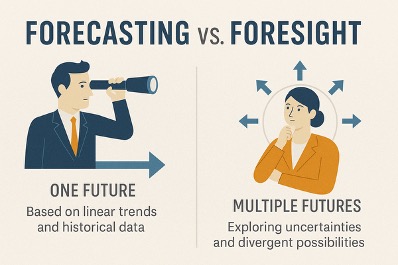
Participants will learn how to identify and analyze key uncertainties and driving forces using frameworks such as STEEP and Causal Layered Analysis to map long term shifts. STEEP encourages a structured examination of Social Technological Economic Environmental and Political factors to uncover slow moving trends and volatile disruptions. Causal Layered Analysis helps participants look beyond surface level issues to identify deeper worldviews myths and systemic structures that shape how change unfolds. These tools are applied through facilitated exercises where participants assess what drivers of change are predetermined and what variables remain uncertain. They will build futures wheels to explore second and third order effects and identify intersections where new risks or opportunities may emerge. The use of visual mapping and collaborative brainstorming encourages multidimensional thinking and enables a fuller picture of potential futures. These methods create a rich information base upon which to build meaningful and diverse scenarios.
The module presents various scenario typologies including inductive and deductive approaches the Shell scenario archetype method and the Four Futures matrix. Inductive approaches begin with observations and data points then build upward into scenario themes while deductive approaches start with pre-selected uncertainties and work down into narratives. Participants practice both methods to understand when each is most useful. The Shell method for example focuses on building internally consistent stories by selecting two critical uncertainties that form a matrix of four scenarios. This model has been used effectively by organizations to anticipate geopolitical energy and social developments. The Four Futures matrix categorizes scenarios by continuation constraint collapse and transformation enabling leaders to test how resilient their plans are in optimistic pessimistic or disruptive environments. Participants will analyze published scenario sets and evaluate their structure clarity and utility to draw lessons for their own scenario work.
Through real world examples drawn from a variety of case studies learners will see how organizations stress test their strategies for resilience. These cases show how foresight has informed decisions on supply chain decentralization AI investment climate policy and talent strategy. Participants will review how scenario planning has helped organizations respond to crises and policy shifts and how leaders engaged boards investors and employees in scenario conversations. Emphasis is placed on how scenario planning can unlock cross functional alignment because it focuses dialogue on shared challenges rather than functional silos. These examples are complemented by a discussion of failures where organizations did not engage in foresight and suffered as a result. The contrast reinforces the value of investing in structured futures thinking.
 Interactive exercises will guide participants through building their own scenario matrix identifying lead indicators and linking each scenario to strategic options. Participants will select a focal issue such as future customer expectations AI regulation sustainability goals or talent acquisition then define critical uncertainties relevant to that issue. They will use voting and prioritization techniques to choose the two most impactful and uncertain variables and create a matrix of four contrasting futures. Scenario narratives will be developed in teams and presented using visual storytelling techniques such as timelines infographics and persona journeys. After crafting scenarios participants will identify robust and contingent strategies that their organizations can adopt to succeed across these possible futures. They will also define lead indicators or early warning signals that help monitor which future is emerging. This allows organizations to build agility into their strategy through real time sensing and timely response. The exercises also include group critiques to strengthen peer feedback facilitation skills and collaborative intelligence.
Interactive exercises will guide participants through building their own scenario matrix identifying lead indicators and linking each scenario to strategic options. Participants will select a focal issue such as future customer expectations AI regulation sustainability goals or talent acquisition then define critical uncertainties relevant to that issue. They will use voting and prioritization techniques to choose the two most impactful and uncertain variables and create a matrix of four contrasting futures. Scenario narratives will be developed in teams and presented using visual storytelling techniques such as timelines infographics and persona journeys. After crafting scenarios participants will identify robust and contingent strategies that their organizations can adopt to succeed across these possible futures. They will also define lead indicators or early warning signals that help monitor which future is emerging. This allows organizations to build agility into their strategy through real time sensing and timely response. The exercises also include group critiques to strengthen peer feedback facilitation skills and collaborative intelligence.
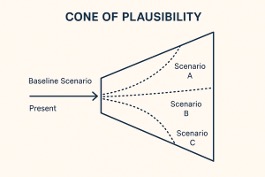 The module concludes by teaching participants how to integrate scenario insights into innovation investment and operational decisions through war gaming adaptive roadmaps and periodic review cycles. War gaming involves role playing how different stakeholders might respond in each scenario helping to anticipate resistance test assumptions and refine strategies. Adaptive roadmaps are introduced as living strategic documents that adjust to changes in external signals. Participants learn to build phased investment strategies that preserve optionality rather than lock in commitments too early. Review cycles are discussed as key mechanisms for refreshing scenarios updating assumptions and embedding foresight into business rhythms such as quarterly planning or risk reviews. Participants will explore the governance processes and cultural norms that support continuous scenario engagement including foresight councils, internal scenario champions and partnerships with external futurists. Tools for measuring the impact of scenario planning on decision quality innovation pipeline diversity and resilience metrics are also discussed.
The module concludes by teaching participants how to integrate scenario insights into innovation investment and operational decisions through war gaming adaptive roadmaps and periodic review cycles. War gaming involves role playing how different stakeholders might respond in each scenario helping to anticipate resistance test assumptions and refine strategies. Adaptive roadmaps are introduced as living strategic documents that adjust to changes in external signals. Participants learn to build phased investment strategies that preserve optionality rather than lock in commitments too early. Review cycles are discussed as key mechanisms for refreshing scenarios updating assumptions and embedding foresight into business rhythms such as quarterly planning or risk reviews. Participants will explore the governance processes and cultural norms that support continuous scenario engagement including foresight councils, internal scenario champions and partnerships with external futurists. Tools for measuring the impact of scenario planning on decision quality innovation pipeline diversity and resilience metrics are also discussed.
Scenario planning is positioned not just as a strategic tool but as a mindset and capability that empowers technology leaders to navigate uncertainty with foresight and confidence. By integrating scenario work into core leadership practice participants not only future proof their strategies but also strengthen their team’s ability to think systemically challenge assumptions and stay grounded in purpose. This transformation of mindset allows leaders to create environments where curiosity is valued strategic conversations are robust and organizations can remain mission driven in the face of change. As the module concludes participants reflect on how scenario planning can become a signature strength of their leadership brand and begin designing a plan to bring this capability to their teams. They leave with a toolkit and roadmap to build lasting foresight capacity and elevate strategic quality across their organizations.

Case Study: Royal Dutch Shell’s Long-Term Scenario Planning
The Royal Dutch Shell Group is widely recognized for pioneering one of the most rigorous and influential scenario planning processes in the corporate world. Beginning in the early 1970s, Shell developed a structured approach to navigating uncertainty, enabling its leadership to make bold, adaptive decisions in a volatile global environment. This case study traces how Shell embedded scenario thinking into its strategic fabric and how technology leaders today can learn from its example.
In the late 1960s, Shell faced unpredictable oil markets and mounting geopolitical tensions. Rather than relying solely on linear forecasts, Shell introduced scenario planning as a tool to consider multiple plausible futures. The core insight was that the future cannot be predicted, but organizations can be prepared. These scenarios were not predictions but structured narratives exploring how different forces like economic shifts, technological innovation, environmental concerns, and political developments could interact to shape Shell’s business context.
In 1973, the effectiveness of Shell’s approach became evident. While most oil companies were caught off guard by the OPEC oil embargo, Shell had already developed a “high-price oil” scenario. As a result, it adapted its supply chain and investment plans more quickly than its competitors. By the end of the decade, Shell had moved from seventh to second place among global oil companies by revenue.
Over the next several decades, Shell institutionalized its scenario planning. It built an internal team of experts who conducted interviews with policymakers, scientists, and thought leaders. These inputs were synthesized into a set of alternative futures, each with its own implications for regulation, customer behavior, capital access, and technology investment. These scenarios were used not only by the board but cascaded through functional teams such as R&D, exploration, digital transformation, and even marketing.
One of the most impactful exercises was the “Energy Scenarios to 2050,” which Shell published publicly in 2008. In this set, two core pathways, Scramble and Blueprints were articulated. Scramble reflected a world of short-term national self-interest, while Blueprints described a coordinated path toward sustainability and innovation. These divergent scenarios helped Shell stress-test its energy mix, determine long-range R&D investments, and evaluate new platform technologies such as carbon capture, hydrogen, and biofuels.
To make scenarios actionable, Shell linked each one to specific early indicators. For example, if more governments adopted carbon taxes, it would signal a shift toward the Blueprints world. Shell’s leadership teams monitored these signals to adjust strategies in real time, rather than waiting for crises.
Shell’s approach to scenario planning also emphasized cognitive diversity. Leaders from multiple functions, geographies, and backgrounds were invited to interpret each scenario and identify implications for their domains. This widened the range of internal perspectives and improved commitment to adaptive strategies.
Scenario planning was embedded into Shell’s strategic cadence. Every five years, a new set of long-range scenarios was developed and used to recalibrate strategies across business units. More recently, Shell has adopted shorter cycle scenarios to manage real-time uncertainty, especially around digital disruption, regulatory change, and geopolitical instability.
The strategic value of Shell’s scenario work lies not in prediction but in preparation. It helped the company become more resilient, avoid groupthink, and institutionalize agility. The scenarios gave leaders a language to discuss uncertainty, a framework to recognize shifts early, and the confidence to act before others did.
For today’s technology leaders, Shell offers several key lessons:
-Scenario thinking is a strategic discipline, not a one-time workshop. It requires structure, leadership buy-in, and continuous refreshment.
-Foresight without action is inert. Shell’s use of lead indicators and cross-functional application turned scenarios into real-time strategy tools.
-Strategic agility is a team sport. The inclusion of diverse voices and organizational levels was crucial in translating insights into momentum.
-The power of narrative matters. Shell’s scenarios were not sterile models but emotionally resonant stories that engaged leadership across cultures.
Shell’s experience proves that structured foresight can turn uncertainty into competitive advantage. While the specifics of the energy industry may differ from those of technology sectors, the underlying capability of building the muscle to anticipate, adapt, and align remains critical for any leader navigating complex and fast-moving environments.

Group Exercise: Scenario Planning for Disruptive Technology
Briefly state one critical strategic challenge your organization might face due to disruptive technology.
Identify two external uncertainties (e.g., regulatory shifts, rapid tech adoption) that will significantly affect your strategic challenge.
Use your two uncertainties to form a 2×2 scenario matrix, outlining four distinct future scenarios. Briefly label each scenario clearly.
As a group, briefly describe the scenario that feels most impactful, highlighting:
-Customer behaviors
-Competitor actions
-Key technology implications
Identify:
• One strategic move your organization should take
• One early warning signal to monitor, indicating this scenario is unfolding
Ensure your strategy is clear, actionable, and adaptable across uncertainties.
Summary
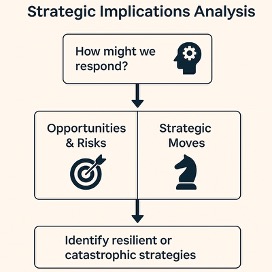
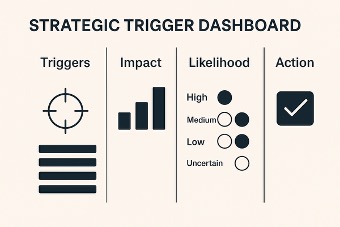
Scenario planning helps leaders shift from reactive to proactive mode. It provides a lens for evaluating uncertainty and making smarter, more adaptive strategic choices.
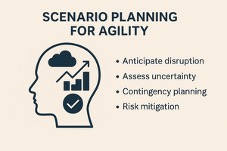
This module enables participants to internalize and implement scenario planning as a leadership discipline. By applying structured foresight, building multiple futures, and equipping teams with flexible plans, technology leaders ensure their organizations are not only prepared for the future, but poised to shape it.

Course Manual 7: Communicating a Strategic Vision (CSV)
Introduction
A strategic vision holds little power if it cannot be clearly and persuasively communicated. In the absence of effective communication even the most compelling vision may fail to inspire align or mobilize teams. Technology leaders must be skilled not only in developing vision but in sharing it with clarity consistency and conviction across multiple levels of the organization. Communication is the bridge that transforms abstract ambition into actionable momentum. It is the mechanism by which vision becomes embedded in culture and operationalized in daily decisions. When communication falters vision becomes fragmented misunderstood or deprioritized. This module builds the critical capability of translating strategic vision into messages that resonate and stick.
 This module explores how visionary leaders turn strategy into story. Storytelling is one of the oldest and most powerful leadership tools. It enables abstract ideas to be emotionally felt widely remembered and deeply internalized. Participants will learn how to adapt their messaging to different audiences how to use strategic narratives to build buy in and how to ensure that vision is embedded into organizational rituals symbols and systems. From executive boardrooms to frontline meetings a well communicated vision enables direction coherence and commitment. Participants will understand how communication sustains motivation connects teams to a larger purpose and builds trust during periods of uncertainty or transformation.
This module explores how visionary leaders turn strategy into story. Storytelling is one of the oldest and most powerful leadership tools. It enables abstract ideas to be emotionally felt widely remembered and deeply internalized. Participants will learn how to adapt their messaging to different audiences how to use strategic narratives to build buy in and how to ensure that vision is embedded into organizational rituals symbols and systems. From executive boardrooms to frontline meetings a well communicated vision enables direction coherence and commitment. Participants will understand how communication sustains motivation connects teams to a larger purpose and builds trust during periods of uncertainty or transformation.
Participants will engage with storytelling frameworks stakeholder mapping tools and visual communication strategies. These include narrative arcs derived from mythic structures such as the Hero’s Journey and Three Act storytelling as well as practical techniques for framing vision in ways that align with organizational identity. They will also study how effective leaders build vision alignment during times of change and how communication becomes the catalyst for engagement trust and cultural cohesion. Examples and simulations will illustrate how strategic messages evolve across mediums from memos to keynotes from team huddles to social channels.
Participants begin by exploring why vision communication fails. Through interactive discussion they surface common pitfalls such as using overly technical language overloading audiences with detail failing to connect emotionally or assuming that one announcement is enough. They examine how even well-crafted visions can fade if not reinforced through repetition symbols and leadership behavior. Participants review examples of communication breakdowns where vision failed to cascade and identify missed opportunities to reinforce alignment. The goal is to replace assumptions about communication with intentional design and empathetic delivery.
The module then introduces the concept of audience centric messaging. Not all stakeholders need to hear the same message in the same way. Participants map their internal and external audiences including executives, investors managers partners and operational teams. They analyze what each group cares about fears and influences. For example, board members may need to see how the vision drives financial returns and risk mitigation while engineers need clarity on the product roadmap and relevance to technical debt. Participants use stakeholder empathy maps to tailor messages and delivery styles. They practice shaping the same strategic message differently for three distinct audiences highlighting how tone detail and format vary.
Storytelling is then explored as a leadership strategy. Participants learn to use narrative arcs to structure their message beginning with context tension and stakes then moving to aspiration transformation and action. Frameworks such as the Hero’s Journey help leaders present the organization or team as the protagonist in a meaningful journey. Participants are challenged to go beyond buzzwords and articulate authentic compelling stories that reflect challenges and aspirations. They explore the use of metaphor contrast and analogies to make vision memorable and emotionally sticky. Real world examples are deconstructed to highlight why some strategic messages resonate while others fall flat.
Visual communication is another key focus. Participants explore how to pair verbal narrative with visuals that reinforce strategic direction. This includes vision maps future state illustrations roadmaps infographics and symbolic imagery. Participants are introduced to communication design principles such as cognitive load signal to noise ratio and visual hierarchy. They examine how visuals can make strategy tangible simplify complexity and serve as repeatable anchors in high volume communication environments. Teams experiment with sketching visual metaphors that reflect their vision and aligning visuals to different channels such as intranet slides or murals.
The module then explores how to embed vision into culture. Communication must move beyond one off presentations into the rhythms, rituals and touchpoints of organizational life. Participants examine how effective leaders use rituals such as quarterly reviews storytelling town halls onboarding programs and leadership offsites to reinforce vision. They also study how symbols such as badges environments internal campaigns and language influence how vision is perceived and adopted. Communication becomes not only verbal but behavioral symbolic and systemic. Participants are encouraged to think in layers repetition and cross functional engagement.
Communication during change is emphasized. When organizations pivot restructure or respond to crisis the need for clear vision messaging intensifies. Participants explore how to communicate transparently during ambiguity while maintaining trust and engagement. They examine the balance between realism and optimism detail and direction. Through case studies they analyze how leaders sustained alignment and belief during prolonged change journeys. They also learn how to address skepticism resistance or fatigue and how to listen actively as part of communication.
Participants work on building their own strategic communication plans. These plans include defining audience segments tailoring messages selecting channels determining cadences and building feedback loops. They apply what they learned in earlier modules about strategic vision foresight alignment and gap analysis and now focus on telling that story across the organization. Peer reviews help refine clarity emotional resonance and cultural relevance. By the end of the module participants present their vision communication plans and receive coaching on style presence and narrative structure.
The module concludes by reinforcing that communication is not a phase but a function of leadership. Participants reflect on their current communication patterns and identify ways to evolve from information providers to meaning makers. They commit to practicing visibility listening consistency and vulnerability. They leave with the tools to not only articulate strategy but to animate it across people platforms and moments. In doing so they elevate their credibility influence and capacity to move entire organizations toward a shared future.
By mastering strategic communication participants gain the confidence to lead not only with intelligence but with inspiration. They become translators of complexity storytellers of transformation and stewards of vision. This ability strengthens their presence sharpens their leadership brand and multiplies their impact as technology leaders.

Learning Objectives
By the end of this module participants will understand the role of strategic communication in leadership effectiveness. Strategic communication is not just about transmitting information it is about inspiring belief building alignment and reinforcing purpose. Leaders who communicate strategically shape how people think feel and act toward a shared goal. This module emphasizes that communication is a critical leadership function on par with decision making and execution. Participants learn how great leaders use message timing tone and content to build trust navigate change and drive culture. Through real world examples and reflective exercises participants explore how their own communication behaviors support or hinder leadership impact.
Participants will also learn to tailor vision messaging for executive teams and external stakeholders. Each audience has different priorities language preferences and trust thresholds. For example, executives may want to understand business impact and risk while frontline teams seek clarity on day-to-day changes and personal relevance. Participants practice segmenting audiences based on influence interests and information needs. They develop skills in customizing narratives delivery formats and follow up strategies to maximize engagement. This objective helps participants move beyond one size fits all messaging and toward intentional relationship centered communication.
They will apply storytelling structures to enhance message resonance and retention. Humans are wired to remember stories not spreadsheets. Participants study how to use classic storytelling arcs such as the Hero’s Journey to structure their communication around challenge transformation and shared victory. They practice identifying turning points building emotional contrast and highlighting character stakes. Through workshop activities participants develop their own strategic narratives that bring abstract strategies to life and make vision tangible. This objective strengthens participants’ ability to communicate with clarity energy and authenticity.
Participants will learn to use visuals metaphors and framing techniques to strengthen clarity. Words alone are rarely enough to cut through noise and complexity. Leaders must also communicate visually using diagrams illustrations and symbols that reinforce message hierarchy and intent. Participants explore how to use metaphor to create emotional bridges and how to frame ideas in ways that reflect shared values. They analyze case examples of effective communication design and experiment with visual thinking in their own plans. This objective equips participants with multi modal tools to engage diverse learning styles and improve message retention.
They will evaluate organizational readiness for vision communication using diagnostic tools. Even the most well-crafted message can fail if the culture systems and channels do not support it. Participants assess their organization’s communication landscape using frameworks that evaluate trust consistency cultural alignment and channel effectiveness. They identify gaps in leadership visibility feedback loops and symbolic alignment. This diagnostic work helps participants ground their strategy in reality and anticipate friction. The objective is to help participants become not just better communicators but better architects of the environment in which communication lives.
Finally, participants will develop a strategic communication plan aligned with business priorities and change milestones. A vision is only as effective as the plan to share it embed it and sustain it. Participants learn to build comprehensive plans that include messaging objectives audience maps communication timelines channel selection and feedback mechanisms. They align communication phases with change events such as new strategy launches system rollouts or cultural transformation programs. Through this objective, participants create a ready to implement plan that reflects best practices is rooted in their organizational context and demonstrates their leadership credibility. They leave the module not only inspired to communicate better but equipped to lead communication as a core leadership discipline.

Content Overview
The module begins by exploring why strategic communication is not merely dissemination but translation. Strategic messages often originate at the top of an organization and travel downward through layers of teams with different languages priorities and frames of reference. This process frequently dilutes or distorts the original intent of the message. Participants are introduced to the idea that effective communication bridges the gap between strategic vision and collective understanding. Through reflective discussions and real-world case studies participants identify the common points of failure where visions lose traction. These include over reliance on email announcements lack of consistent messaging across channels or leadership teams delivering mixed signals. The focus is on recognizing that strategy lives or dies in its translation and that leaders must become stewards of that translation. This foundation allows participants to understand communication as an act of leadership rather than administration.
Participants then learn to segment their stakeholders using structured stakeholder mapping techniques. They identify different audience groups such as board members C suite leaders, middle managers, frontline teams, external partners and customers. Each of these groups interacts with vision from a different vantage point. Participants examine what each audience values, fear and expects. For instance, board members may prioritize financial growth risk management and governance while customer service teams may be more focused on operational alignment and role clarity. Participants explore how to adapt tone detail medium and timing for each audience to maximize resonance. This segmentation process includes exercises on mapping influence versus interest diagnosing trust levels and designing communication strategies that align with the needs and concerns of each group. The result is a personalized communication strategy that moves beyond one size fits all messaging to intentional purpose driven dialogue. It reinforces the value of empathy in crafting strategic communication that truly connects.
Storytelling is introduced as a core leadership skill and a central component of vision communication. Participants are guided through narrative design methods that include the three act structure the Hero’s Journey and contrast-based storytelling. They practice transforming data into stories that highlight challenges decisions turning points and aspirations. The module reinforces that storytelling is not fictionalizing it is framing reality in a way that inspires and clarifies. Participants are taught to find the human element in strategy to emphasize struggle and transformation and to use narrative arcs to build emotional engagement. The training also includes work on metaphor framing where participants learn to use metaphors as tools for simplifying complex ideas and connecting them to shared values. They practice applying these techniques to recent strategic initiatives or change programs and receive peer feedback on structure emotional tone and clarity. By mastering these storytelling frameworks participants can lead with authenticity and purpose in every message they deliver.
Participants are also introduced to visual tools that support message clarity and strategic alignment. These include tools such as vision maps that visualize the future state strategic communication canvases that organize key messaging inputs stakeholder heat maps that prioritize audiences and communication cadences that schedule delivery. Through hands on activities participants use these tools to align message content timing and delivery method. They explore how visuals help distill strategy into accessible formats that resonate across diverse cognitive styles. Participants analyze examples of high impact visual messaging from real organizations such as murals infographics dashboard integrations and internal branding. They also discuss how the physical and symbolic environment from office design to internal events can reinforce or contradict the communicated vision. This segment of the module emphasizes the importance of message consistency across all modalities of leadership behavior and organizational symbols. Participants leave this section with a practical toolkit for making abstract ideas visible and repeatable.
The module then shifts to implementation strategy. Participants build detailed communication roadmaps that define kickoff moments, key messaging, milestone updates and cascading dialogue points. They consider how to engage their own leadership teams to become amplifiers and co storytellers of the vision. Participants learn about the importance of timing in communication and how to pace message delivery with organizational readiness. They also explore the mechanics of two-way communication such as feedback loops listening sessions and pulse surveys to ensure that communication is not just projection but conversation. The roadmap includes strategies for addressing resistance measuring message uptake and adapting communication based on feedback. Real world examples highlight how communication efforts that include iterative check ins visual storytelling and leadership visibility lead to higher engagement and faster alignment. In this section participants also explore how to manage competing communication priorities during periods of rapid change.
A major theme throughout the module is the idea of making vision a living narrative. Participants are challenged to move beyond the notion of vision as a poster or annual speech. They examine how vision can be reinforced through rituals such as weekly meetings recognition moments leadership reflections and cross functional storytelling. They explore the impact of leader visibility tone and narrative consistency on team alignment. Participants study how leaders embody vision through their actions and how organizational culture is both shaped and sustained through repeated shared language and symbols. The module underscores that communication is not a one-time task but a continuous leadership function that requires intentionality creativity and repetition. By elevating communication to the level of a ritualized practice leaders can build culture and drive change with integrity and coherence.
By the end of the module participants complete a capstone exercise that brings together all elements of communication planning. They select a current or upcoming strategic initiative and apply the frameworks to craft a multi audience communication plan. This includes the narrative the visual anchors the stakeholder segmentation the timing and rhythm of communication and feedback collection methods. Teams share their plans in a peer review setting where they receive feedback on clarity structure emotional resonance and adaptability. This hands-on approach ensures that participants leave not just with new ideas but with a ready to use plan that aligns to their real work environments. The feedback process also cultivates the skills of peer coaching and reflective critique vital tools for any modern leader.
Participants also engage in role play and scenario-based exercises where they must adapt their communication in real time based on shifting audience needs organizational dynamics or crisis events. These simulations build confidence and adaptability. The learning experience is deepened with video analysis storytelling practice and constructive coaching. Participants explore how to use tone body language and pacing to build trust and credibility. This multidimensional approach to communication helps leaders integrate strategy communication and leadership presence. Participants reflect on their personal communication style and experiment with adjustments that strengthen clarity alignment and influence.
In conclusion the module reinforces that communication is not the end of strategy but its beginning. Without a clear compelling and consistent message even the most brilliant strategy cannot achieve lift off. Leaders who master strategic communication are able to build coalitions energize teams defuse resistance and align daily activity with future ambition. They become translators of complexity amplifiers of culture and catalysts of trust. By turning strategy into story, they create a shared mental model that drives behavior across functions geographies and time zones. Communication becomes a leadership act that shapes the present and co creates the future. Participants leave this module with greater clarity confidence and capability to lead through voice vision and values. Ultimately they gain not only skills but also a renewed sense of purpose as communicators of change.
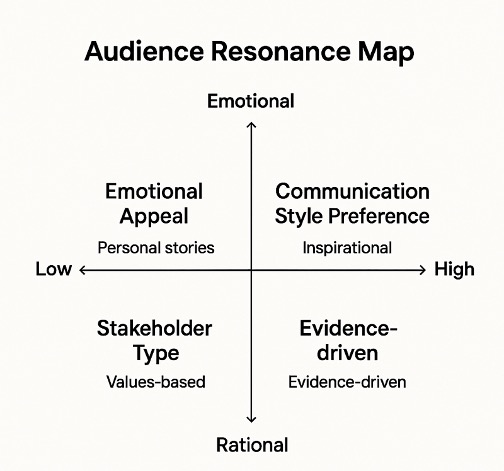
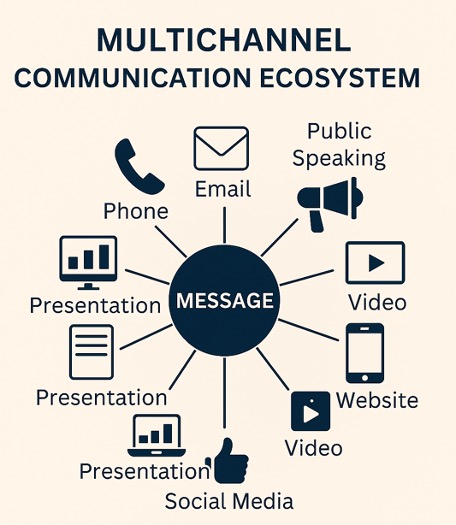

Case Study: Airbnb – Communicating Vision Through Crisis and Reinvention
In 2020, Airbnb faced one of the most severe strategic shocks in its history. As the COVID-19 pandemic spread globally, travel bookings plummeted by over 80 percent within weeks. Investors questioned the company’s viability. Employees feared layoffs. Hosts, the foundation of Airbnb’s supply lost income overnight. Amid the chaos, the leadership team had two options: retreat into operational triage or rise with clarity and vision.
They chose the latter.
Brian Chesky, co-founder and CEO, made the decision to communicate Airbnb’s long-term vision in a way that was emotionally honest, strategically sharp, and culturally resonant. The company’s original mission, “to help anyone belong anywhere” became the central narrative anchor. But rather than reiterating the phrase as a slogan, Chesky reframed it in light of the pandemic. The vision was no longer just about global travel; it was about human connection in uncertain times.
Chesky sent an open letter to Airbnb employees announcing layoffs affecting nearly 25 percent of the workforce. What made the communication extraordinary was not just the empathy or transparency. it was the narrative structure and strategic intent embedded within. He contextualized the decision by explaining Airbnb’s commitment to core values and future vision. Rather than pivoting to short-term profits or survival tactics, he affirmed Airbnb’s focus on hosting, experiences, and long-term community-building.
This letter became a benchmark in corporate communication. It followed what is essentially the Hero’s Journey format:
The Ordinary World: Airbnb as a fast-scaling tech unicorn disrupting hospitality.
Call to Adventure: The pandemic forces a radical disruption of global travel.
Crossing the Threshold: Airbnb chooses to refocus on its core and make difficult cuts.
Tests and Allies: It supports hosts with grants and redesigns its platform for longer stays and local travel.
The Transformation: Airbnb reemerges leaner, more values-driven, and attuned to post-pandemic shifts.
Return with the Elixir: In December 2020, Airbnb successfully goes public with a valuation exceeding $100 billion.
Beyond the internal letter, Chesky used investor communications, public interviews, and brand messaging to amplify this narrative. He consistently returned to the idea that Airbnb was not just a travel company—it was a platform for belonging. That emotional and strategic throughline created trust, inspired employees, and reframed how the market perceived the business.
To support this communication strategy, Airbnb adapted its stakeholder engagement using layered techniques:
Internal newsletters, manager toolkits, and town halls helped cascade the message to teams.
Press articles and social media gave external visibility to their mission-driven transformation.
Product updates reflected the same strategic choices, showing alignment between message and execution.
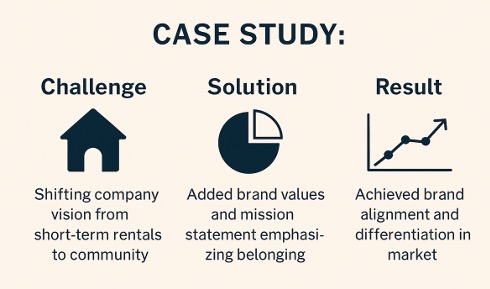
Key Lessons for Technology Leaders:
-Vision must adapt without breaking. Airbnb’s original mission remained intact but was refocused for relevance in a new reality.
-Crisis amplifies clarity. A clear message, structured through emotional storytelling and grounded in values, can unify teams during uncertainty.
-Strategic communication is a leadership discipline, not a marketing function. Airbnb’s leadership treated every channel, internal or external as an extension of their vision.
Technology leaders can draw from this by crafting communication plans that frame disruption as transformation, embed values in every message, and adapt narratives over time while staying true to purpose.
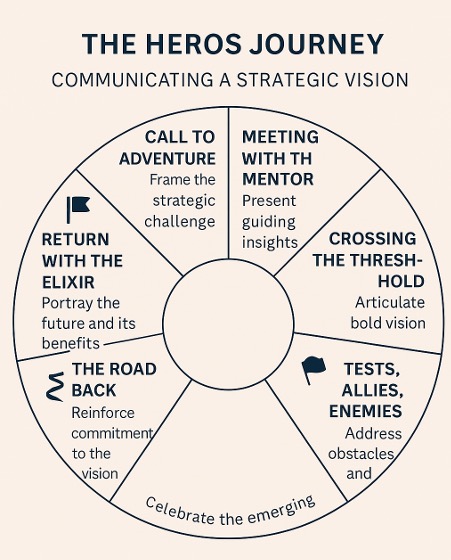

Group Exercise: Crafting and Delivering Strategic Vision Narratives
-Briefly articulate your chosen strategic
-Purpose of the initiative
-Intended impact or change
-Pick one key audience (employees, executives, customers, or partners). Briefly note:
-Their primary concern or interest
-Possible resistance or fears
Use a brief “Hero’s Journey” format:
-Current situation (status quo)
-Main challenge or disruption
-Key transformation or benefit if successful
-Write your narrative in clear, engaging language without jargon.
-Who will deliver this message?
-Preferred channel (meeting, video, email)
List one likely objection from your audience and a brief, reassuring response.
Ensure your narrative is concise, relevant, and emotionally resonant.
Summary
This module equips participants with the skills to communicate a strategic vision that inspires, aligns, and mobilizes. By examining the power of narrative, participants learn how to adapt their messaging for different audiences, anticipate resistance, and reinforce vision through consistent action and messaging. Tools such as the Hero’s Journey provide a structure for shaping emotionally resonant stories, while audience mapping and multi-channel planning ensure the message is both strategic and relevant. Leaders leave this module with the ability to translate vision into a compelling call to action that resonates across an organization and beyond.

Course Manual 8: Measuring Strategic Success (MSS)
Introduction
Strategic initiatives succeed not by intention alone but through consistent measurement and validation. As technology leaders drive vision into execution, it becomes imperative to define and track meaningful metrics that reflect both performance and progress. This module introduces participants to a structured approach for measuring strategic success with an emphasis on aligning key performance indicators with business outcomes, stakeholder expectations, and long-term value creation. The ability to measure success effectively is what allows organizations to move from aspirations to outcomes. It ensures that leaders know whether their strategy is working, where adjustments are needed, and how to communicate progress with confidence and credibility.
Measurement is more than data collection. It is an active discipline of feedback, refinement, and learning. Without clear success criteria, organizations risk misalignment between effort and impact. They may spend valuable resources on initiatives that do not yield desired outcomes or misinterpret success based on incomplete or misleading indicators. Technology executives must understand not only what to measure but also how to embed these metrics into the fabric of daily operations, strategic reviews, and executive communication. Measurement should not be a periodic afterthought, but a real-time capability that informs decisions, energizes teams, and enables continuous learning.
This module enables participants to move beyond vanity metrics and develop a performance framework that is both rigorous and adaptive. Vanity metrics are often those that look impressive on dashboards but do not drive meaningful action. Participants learn to distinguish between indicators that measure activity and those that measure impact. For example, tracking the number of system deployments is useful, but it is far more meaningful to assess how those deployments improve customer satisfaction, reduce error rates, or increase operational agility. Through case examples, peer discussions, and interactive activities, participants will explore the interplay between leading and lagging indicators, the balance between short-term wins and long-term objectives, and how to translate data into strategic insight.
One of the central themes of the module is the importance of aligning measurement with strategic intent. When metrics are disconnected from the organization’s goals, they can create false signals, distort priorities, and undermine accountability. Leaders must start with clarity on the outcomes they wish to achieve and then work backward to define how those outcomes can be observed and quantified. This includes developing a measurement hierarchy that links enterprise-level goals to team-level performance indicators. Participants learn how to create measurement plans that support vertical alignment across the organization and foster a shared understanding of success.
The module also addresses the human dynamics of measurement. Data can inform, but it can also intimidate. Metrics can create focus, but they can also create fear if perceived as tools of surveillance rather than tools of empowerment. Participants examine how to build a measurement culture that encourages transparency, collaboration, and improvement rather than blame. They explore how leaders can use measurement conversations as opportunities to engage teams, celebrate progress, and problem-solve in constructive ways. Participants learn to frame performance reviews as learning opportunities and to use dashboards not just as reporting tools, but as vehicles for dialogue.
Another key focus is selecting the right balance of metrics. Participants explore the difference between leading indicators, which predict future performance, and lagging indicators, which reflect past performance. Both are important, but they serve different purposes. Leading indicators allow for early intervention and course correction, while lagging indicators validate outcomes. For example, employee engagement scores may serve as a leading indicator for retention, while actual turnover rates provide a lagging view. Participants learn how to develop a balanced scorecard that includes financial, operational, customer, and innovation metrics. They also explore how to prioritize a small number of high-quality metrics over an overwhelming volume of low-value data points.
Participants are also introduced to tools and frameworks that help make measurement actionable. These include KPI trees, logic models, measurement dashboards, and OKR systems. They learn how to visualize the causal relationship between inputs, activities, outputs, and outcomes. These tools help participants avoid the trap of measuring what is easy instead of what matters. They also support strategic storytelling by linking data points to the broader narrative of transformation and progress. Participants work through examples where they must select, define, and refine metrics for different types of initiatives, from digital product launches to organizational change efforts.
In addition to quantitative measures, the module encourages participants to consider qualitative insights as part of their measurement strategy. Not all value can be expressed numerically. Interviews, focus groups, pulse surveys, and observational data can reveal sentiments, behaviors, and systemic patterns that numbers alone cannot capture. Participants learn how to triangulate quantitative and qualitative inputs to build a more nuanced understanding of progress. They also examine how to ensure data integrity, avoid measurement bias, and maintain ethical standards in data collection and use.
The module highlights the importance of timing in measurement. Metrics must be reported with enough frequency to inform decisions, but not so frequently that they create noise or fatigue. Participants explore how to set reporting cadences that align with decision cycles, project phases, and team rhythms. They learn how to distinguish between operational metrics that need daily or weekly review and strategic metrics that may require quarterly or annual evaluation. Timing also includes understanding when to introduce new metrics, sunset outdated ones, and evolve definitions as the organization matures.
A final theme is the role of leadership in sustaining measurement discipline. It is not enough to have good metrics on paper. Leaders must model curiosity, act on data, and hold themselves accountable to the same standards they set for others. Participants reflect on their own measurement behaviors and identify areas where they can improve as measurement leaders. They explore how to create rituals of reflection such as metric reviews in leadership meetings, learning retrospectives, and quarterly measurement checkpoints. These routines help keep measurement alive, visible, and meaningful.
By the end of the module, participants will have developed a personal measurement blueprint that includes a KPI framework, success criteria for a strategic initiative, and a communication plan for sharing progress. They will leave with the ability to design metrics that matter, use data to drive decisions, and build a culture where measurement is not a burden, but a source of clarity and motivation. Ultimately, they will understand that measuring strategic success is not about control, it is about learning, alignment, and impact.
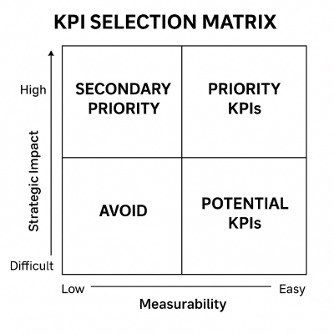
Learning Objectives
By the end of this module participants will be able to identify and define meaningful metrics that align with strategic goals and business outcomes. Participants will learn to move beyond generic reporting and instead focus on indicators that reflect real progress toward core organizational priorities. They will examine how to build clarity around what success looks like and how to track it effectively using business language that resonates with cross functional teams and executive leadership.
They will also be able to distinguish between leading and lagging indicators and apply them appropriately in different scenarios. Leading indicators offer predictive insight and allow for proactive adjustments while lagging indicators confirm outcomes after the fact. Understanding the strengths and limitations of each type helps leaders balance foresight with validation and prevents overreliance on reactive performance reviews.
Participants will develop a balanced scorecard tailored to technology initiatives that integrates financial operational customer and innovation perspectives. This ensures that measurement does not skew toward one narrow domain but instead reflects a holistic view of performance. Participants will explore how to customize scorecards based on initiative type maturity and business context to maximize relevance and usability.
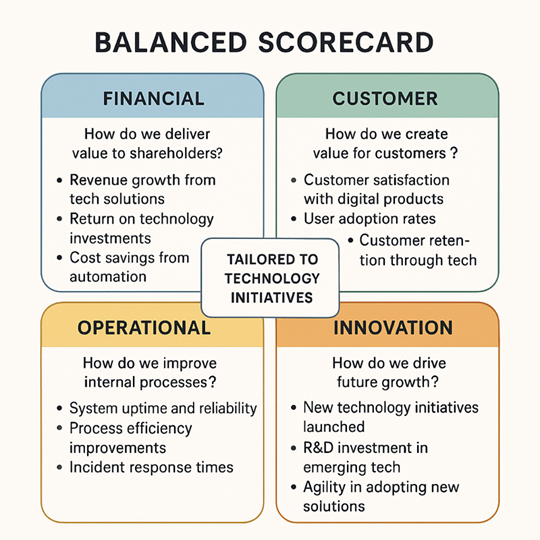
They will learn to translate qualitative goals into quantifiable performance benchmarks that can be tracked with confidence and shared transparently. Whether the goal is improved collaboration increased adoption or cultural alignment participants will design measurement criteria that make intangible progress visible and actionable.
The module will help participants establish success criteria for both long term initiatives and short-term milestones. They will practice setting realistic and inspiring performance targets that reflect ambition while accounting for execution risk. This objective also emphasizes the need to build in checkpoints that allow for learning and recalibration along the journey.
Participants will be able to integrate performance metrics into team workflows and executive reporting so that measurement becomes part of daily behavior not just quarterly dashboards. They will explore how to use tools like visual metrics boards metric based one on ones and cross functional updates to ensure ongoing visibility and accountability.
They will recognize common pitfalls in measurement and how to avoid misinterpretation of data. This includes detecting vanity metrics cherry picking confirmation bias and correlation versus causation errors. The module strengthens analytical thinking and cultivates a healthy skepticism that improves decision quality.
Participants will use measurement frameworks to facilitate continuous improvement and learning. They will design systems that treat metrics not as verdicts but as inputs into iteration retrospectives and performance reviews. This learning focused mindset turns every metric into a feedback loop.
They will align stakeholder expectations with measurable progress indicators to improve trust and reduce ambiguity. Participants will practice converting high level stakeholder goals into shared KPIs and building reporting formats that promote clarity and transparency.
Participants will be able to evaluate the effectiveness of technology strategies through data driven insights. They will analyze outcomes against intended value using quantitative and qualitative data and make informed adjustments to scope investment or process.
Finally, they will learn to communicate strategic results using clear and relevant visualizations. Participants will design reporting outputs that are concise audience specific and action oriented. By fostering a culture of accountability and transparency through measurement participants enhance credibility focus and trust at every level of leadership.
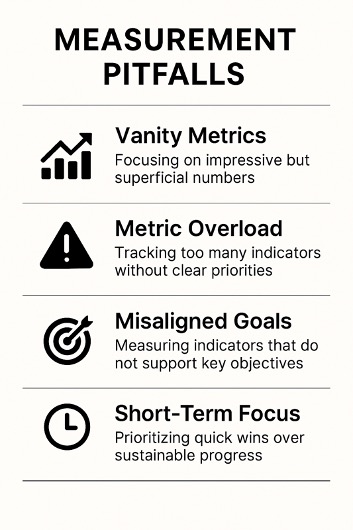
Content Overview
The course manual begins by exploring the foundational concept that measurement must be strategy driven. Participants will be guided through a step-by-step process to clarify what matters most to their organization and how those priorities translate into measurable outcomes. They will learn that without this alignment, measurement systems can easily drift toward what is easiest to quantify rather than what is most meaningful. Grounding measurement in strategy ensures that performance is not only monitored but aligned with organizational purpose. By anchoring metrics to vision, leaders can improve both accountability and engagement, ensuring that everyone knows what progress looks like and how to contribute toward it.
A key distinction is drawn between leading indicators and lagging indicators. Leading indicators are predictive. They provide early signals of progress or risk. Examples include employee training completion rates, customer onboarding satisfaction, or prototype validation in product development. Lagging indicators on the other hand are outcome based and confirm whether results have been achieved. These include metrics such as revenue growth, cost savings, customer churn, and operational uptime. Participants will analyze the interdependency between the two and learn that effective strategies must be monitored using a blend of both. The module includes examples from real organizations to show how neglecting either type can result in blind spots that delay course correction or exaggerate short term success.
To support holistic performance analysis, the module introduces the Balanced Scorecard framework. Participants will explore its four traditional dimensions including financial, customer, internal process, and learning and growth. They will consider how each dimension maps to different roles within a technology organization. Emphasis is placed on customizing the framework to reflect evolving business models, especially in organizations shifting from product to platform or from service to subscription. By personalizing scorecard dimensions, leaders ensure that every initiative is evaluated in a way that is consistent, meaningful, and outcome oriented.
The manual then covers how to identify high impact KPIs using a KPI Selection Matrix. This matrix plots each potential indicator on two axes: strategic impact and measurability. Participants use this tool to prioritize metrics that are both meaningful and reliable, while discarding or deemphasizing those that fall into the quadrant of low impact and high measurement difficulty. They work through examples of poor metric selection and practice refining KPIs for clarity, relevance, and feasibility. This matrix becomes a valuable decision-making support for any performance focused discussion.
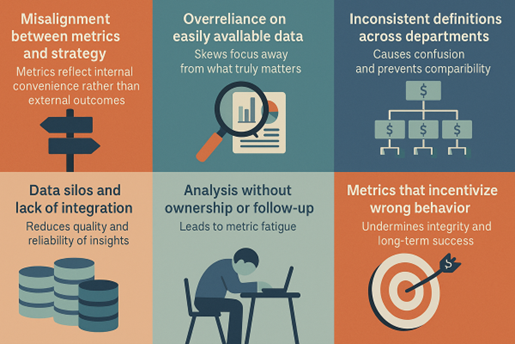
A full section is devoted to designing dashboards that communicate effectively across stakeholder groups. Participants will study dashboard design principles such as cognitive load, visual hierarchy, signal to noise ratio, and the importance of audience segmentation. For example, while an executive dashboard may focus on strategic indicators and trendlines, a team dashboard may present operational data at a more granular level. The use of color, interactivity, and real time data will be discussed as ways to enhance engagement and clarity. Participants learn how to structure dashboards not as static reports, but as interactive tools that drive action and insight.
Another major focus of the module is the establishment of a Measurement Rhythm Timeline. Participants will develop timelines that define when metrics should be reviewed, who should be involved in those reviews, and how action should follow insights. For instance, daily metrics may be reviewed by operational leads, weekly metrics by department heads, and quarterly metrics by senior executives. Participants will design a timeline suited to their organization’s structure and pace of change. By connecting measurement to regular reviews, participants embed performance thinking into business rhythms.
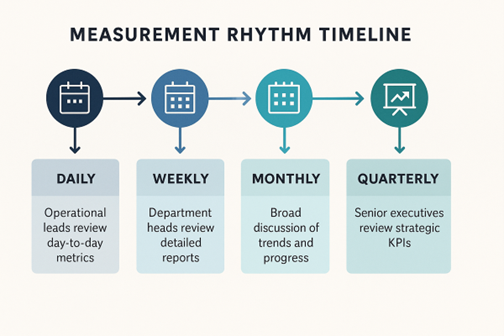
The course also addresses cultural dynamics in measurement. In many organizations, metrics are viewed through a lens of judgment or control. This inhibits transparency and learning. The module introduces the concept of psychological safety in measurement, creating an environment where teams view data as a mirror for learning, not a weapon for blame. Participants reflect on how measurement is perceived in their culture and develop strategies for shifting the narrative from compliance to commitment. They explore how inclusive dialogue around performance creates stronger ownership and trust.
To support this cultural shift, participants will also learn the principles of measurement storytelling. This includes structuring data presentations as narratives, using metaphors and framing devices, and avoiding jargon that alienates non-technical audiences. By crafting a compelling story around performance data, leaders can inspire action, foster alignment, and deepen trust. Participants practice presenting key metrics as a narrative arc to different audiences, enhancing retention and engagement.
The manual then explores measurement maturity models, which describe the stages through which an organization’s measurement capabilities evolve. Participants assess where their organization sits on this spectrum, from fragmented reactive reporting to integrated real time strategic analytics and identify the next set of capabilities to build. These include investment in automation tools, alignment between systems and KPIs, and consistent definitions across departments. Maturity assessments help participants set realistic goals and plot their measurement development roadmap.
Several practical challenges are addressed through a review of common pitfalls. One challenge is misalignment between metrics and strategy, where metrics reflect internal convenience rather than external outcomes. Another is over reliance on easily available data, which can skew focus away from what truly matters. Inconsistent definitions across departments can cause confusion and prevent comparability. Data silos and lack of integration reduce the quality and reliability of insights. Analysis without ownership or follow up leads to metric fatigue. And metrics that incentivize the wrong behavior can undermine integrity and long-term success. For each of these pitfalls, the manual offers examples, warning signs, and remediation techniques. Participants walk through real-life scenarios to recognize these challenges in action and explore how successful companies resolved them through cross functional collaboration and leadership engagement.
To further ground the learning in practical application, the course manual includes a walkthrough for creating a Measurement Playbook. This playbook is a living document that captures several essential components. The first is a clear articulation of the strategic objectives being supported, ensuring that all measurement ties directly to organizational intent. The second component is a prioritized set of KPIs, each with precise definitions and documented data sources, so that ambiguity is minimized. The playbook also outlines the roles and responsibilities for data collection, analysis, and reporting, ensuring accountability is distributed and clear.
Next, the playbook specifies the cadence of reviews and escalation protocols. This includes who meets when, what is reviewed, and what happens when a metric falls outside tolerance. The format and communication strategy for visualization is then documented, highlighting how dashboards will be shared and interpreted. Finally, a learning loop is established to periodically review the relevance and performance of the KPIs over time. This allows metrics to evolve along with strategy, keeping the measurement framework adaptive and resilient. Participants will draft the first version of this playbook for a strategic initiative within their own scope of influence. This output serves as both a personal artifact and a reference template for future initiatives, embedding measurement thinking into everyday practice.
By the end of this course manual, participants will have built a foundation to use measurement not as a compliance mechanism but as a core leadership tool. They will be equipped to design frameworks that reflect strategy, foster learning, drive accountability, and adapt to change. With a robust approach to measurement in place, their strategic initiatives will not only stay on course but also evolve with clarity, confidence, and measurable impact. The manual positions measurement as a dynamic leadership lever, enabling thoughtful iteration, deeper insight, and continuous alignment. Participants will leave with tools to not only monitor results but also tell compelling stories of progress that shape future decisions and culture.

Case Study: Cisco’s Strategic Metrics for Transformation Success
Cisco Systems, a global leader in networking and IT infrastructure, experienced significant complexity as its product lines and customer base expanded. In the early 2010s, the company faced internal challenges around inconsistent performance tracking across business units. Different teams reported success using their own metrics, which made it difficult for executives to assess progress against the company’s strategic objectives. Despite continued innovation and strong market presence, Cisco recognized that a lack of measurement clarity was undermining strategic alignment and operational focus.
To address this, Cisco initiated a company-wide transformation to standardize how success was measured. The leadership team implemented a balanced scorecard framework that aligned financial performance, customer outcomes, internal operational excellence, and innovation. This framework became the foundation for performance reviews and strategic planning discussions across business units. Dashboards were introduced to track progress against key metrics in real time, and common reporting standards were embedded across engineering, marketing, and sales functions.
In its cloud and software-as-a-service segments, this new approach revealed a disconnect between customer acquisition rates and product adoption. By refining its metrics to emphasize usage patterns, churn rates, and customer success milestones, Cisco was able to shift focus from volume-based targets to value-based outcomes. These insights led to changes in product design, support services, and go-to-market strategies, ultimately improving customer satisfaction and revenue retention.

What leaders can learn from this case is that strategic measurement is not about tracking every data point. It is about selecting the few indicators that truly reflect progress toward long-term goals. Cisco’s experience demonstrates how the adoption of a shared measurement framework can create alignment, improve decision-making, and elevate organizational focus. Leaders who commit to consistent measurement practices are better equipped to navigate complexity, communicate progress, and build accountability across teams.

Group Exercise: Designing Your Strategic Dashboard
-Briefly state your strategic initiative and clearly note:
-Its primary purpose.
-One clear outcome defining success.
-Identify two key metrics:
-One leading indicator (predictive measure).
-One lagging indicator (result-focused measure).
Determine:
-How often metrics will be reviewed.
-Who is responsible for review.
-How progress will be communicated to stakeholders.
List one possible measurement challenge and briefly describe how you’ll address it.
Confirm your measurement plan is clear, actionable, and effectively aligned with strategic goals.
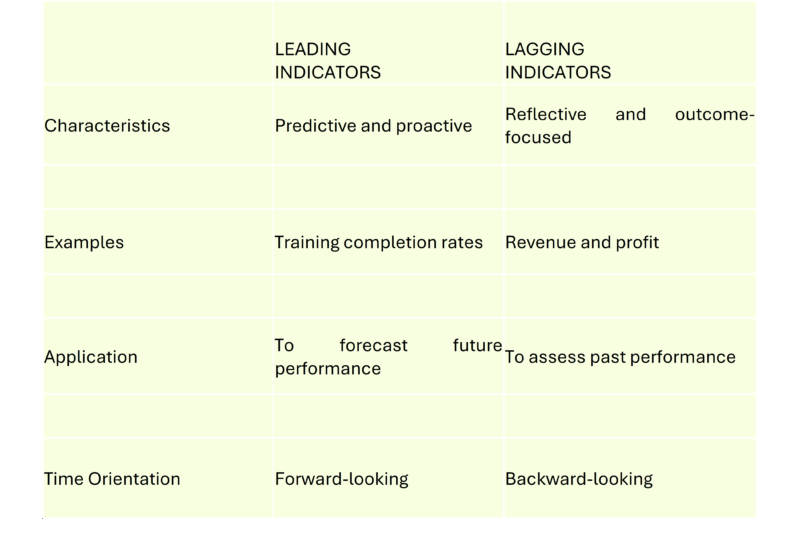
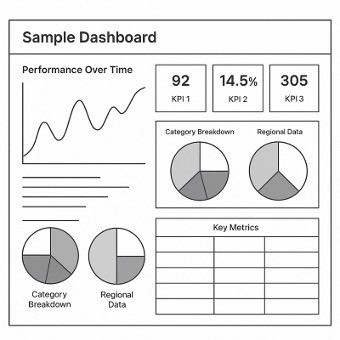
Summary
Without measurement, vision becomes aspiration. This module equips technology leaders with the skills to ground strategic ambition in metrics that matter. By building strong KPI frameworks and communication routines, leaders increase transparency, accountability, and adaptability.
Participants leave with a blueprint for defining success and reinforcing it consistently – turning measurement into a daily leadership practice that fuels progress, trust, and innovation.

Course Manual 9: Leadership & Cultural Alignment (LCA)
Introduction
Technology transformations succeed or fail not only because of strategy or innovation, but because of people. A brilliant roadmap, a cutting-edge platform, or an ambitious vision can all fall flat if the culture of the organization is not aligned to support them. Culture is the invisible operating system of any enterprise it influences how people make decisions, take risks, collaborate, and respond to change. For a vision to be implemented effectively, the organizational culture must support it, and leadership must actively shape that culture through intention, behavior, and consistent reinforcement.
In this module, participants explore how to align leadership behaviors and cultural values with strategic goals. Leaders are not only responsible for setting direction they are also stewards of meaning, trust, and belief. Culture lives in stories, rituals, language, and habits, and leaders have the power to influence all of these. When leadership values are consistent with the organizational vision, change gains momentum. When they are not, skepticism spreads and transformation stalls. Participants will learn how to examine the implicit and explicit dimensions of culture, and how to make those dimensions visible, measurable, and changeable.
Cultural misalignment can sabotage even the most technically sound initiatives. For example, a company might launch an agile transformation initiative but operate with a command-and-control management style that discourages autonomy. Or an organization might espouse innovation as a core value but punish experimentation and failure. In such environments, employees receive mixed signals, and trust erodes. This module helps participants recognize these inconsistencies and create alignment between what the organization says it values and how it actually behaves. Through case studies and diagnostic frameworks, participants will assess how leadership actions, incentives, communication, and systems reinforce or undermine cultural aspirations.
Innovation, agility, collaboration, and customer centricity require cultural reinforcement from the top down and bottom up. It is not enough to have posters on walls or values in slide decks. These aspirations must be embedded into hiring decisions, performance reviews, team rituals, learning programs, and daily conversations. Leaders must be able to translate cultural values into tangible practices and reinforce them consistently. For example, if customer centricity is a stated value, customer stories might be shared at weekly all hands meetings, and feedback loops with customer service might be baked into product development cycles. Participants will explore these strategies and learn to craft mechanisms that bring values to life.
This module provides practical tools for leaders to assess cultural readiness, drive alignment, and model behaviors that sustain transformation. Cultural readiness assessments help leaders identify both the enablers and inhibitors of change. They surface hidden norms, beliefs, and fears that may be influencing team behavior. Participants will work with tools such as culture mapping, alignment gap analysis, and leadership behavior audits to evaluate their current environment. By doing so, they gain a clearer picture of the cultural levers they need to pull to create alignment.
Modeling behavior is a central theme of the module. Leaders shape culture most powerfully through what they consistently do, not just what they say. Participants will reflect on how their own habits, communication style, and decision-making processes either reinforce or contradict the culture they wish to build. For instance, if a leader wants to cultivate psychological safety but shuts down dissenting views in meetings, the intended culture is quickly undermined. Through peer coaching and feedback, participants will explore how to develop behavioral integrity aligning actions with values and increase their influence by leading with authenticity.
Participants will also learn how to manage resistance, which is a natural part of any change effort. Resistance is not necessarily negative; it often signals areas where people need more clarity, support, or engagement. The module explores the different sources of resistance such as fear of loss, confusion, past trauma from failed initiatives, or misalignment of incentives and offers strategies for addressing them constructively. Leaders learn to surface concerns early, create forums for honest dialogue, and co create solutions with those affected by change. They also explore how to shift mindsets over time by celebrating small wins and reinforcing desired behaviors.
Creating psychological safety is essential for cultural alignment. When people feel safe to speak up, admit mistakes, and challenge assumptions without fear of punishment, innovation and learning thrive. Psychological safety enables open feedback, continuous improvement, and honest conversations all critical for cultural transformation. Participants will study the building blocks of psychological safety and assess the safety climate within their teams. They will also practice strategies such as inclusive facilitation, active listening, and modeling vulnerability to foster trust and inclusion.
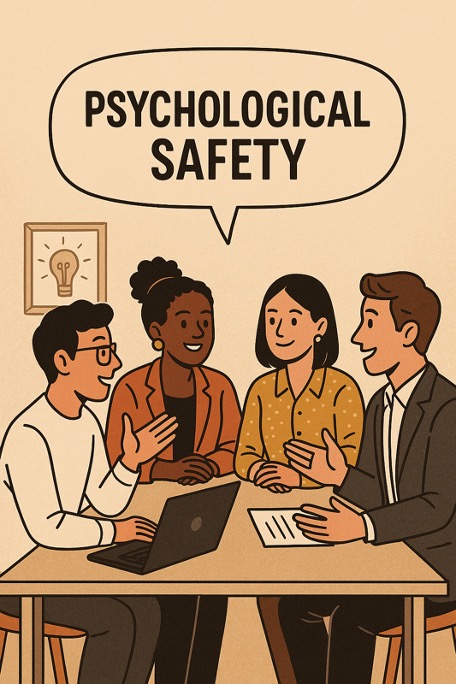
The module emphasizes that culture is not changed through mandate, but through consistent rituals and reinforcing symbols. Participants will explore how rituals such as onboarding practices, team reflections, recognition events, and leadership storytelling can be intentionally designed to reinforce cultural values. They will also examine how symbols, such as office layouts, language patterns, internal communications, and visual branding, either align with or contradict the intended culture. For example, if a company values transparency but leaders hold decision making meetings behind closed doors, the cultural message becomes diluted. Participants will identify key rituals and symbols within their own organizations and propose adjustments that align with strategic priorities.
A key takeaway from the module is that cultural alignment is not a one-time project it is an ongoing process of sense making, action, and adaptation. As strategy evolves, so must culture. Participants will explore how to sustain cultural alignment through feedback loops, regular measurement, and iterative learning. They will review how successful organizations institutionalize cultural practices, monitor culture health, and equip leaders at all levels to be cultural stewards. The goal is to create a resilient culture that can adapt without losing coherence, and that empowers people to bring their best selves to work.
Through immersive exercises, participants will draft a cultural alignment blueprint for a strategic initiative. This blueprint includes cultural aspirations, current gaps, reinforcing behaviors, rituals, communication strategies, and metrics for progress. It serves as both a personal leadership commitment and a tool for engaging their broader teams. Participants leave the module not just with insight, but with a practical plan for aligning culture with strategy in their own context.
In summary, this module challenges the notion that culture is intangible or unchangeable. Instead, it offers a roadmap for how technology leaders can actively shape culture as a strategic lever for transformation. By understanding how beliefs, behaviors, and systems interact, leaders gain the capacity to cultivate environments where people thrive, strategy accelerates, and change endures. In doing so, they move from managing change to leading transformation from reacting to culture to architecting it with clarity and purpose.

Learning Objectives
By the end of this module participants will understand the role of culture in enabling or obstructing strategy. They will examine how cultural norms shape daily decision-making communication styles risk tolerance and engagement levels. Participants will reflect on how culture can serve as a strategic multiplier when aligned or as a source of friction when misaligned.
They will define leadership traits required for vision aligned execution. This includes authenticity empathy consistency and the ability to communicate with clarity and conviction. Participants will explore how leadership presence influences team norms and how leaders can model behaviors that support innovation resilience and trust.
Participants will assess organizational culture using qualitative and quantitative methods. These include culture surveys focus groups observational diagnostics and heat maps of cultural enablers and blockers. They will interpret data to uncover patterns blind spots and leverage points for cultural change.
They will identify cultural gaps that hinder transformation. These may include gaps between stated values and actual behavior between leadership and employee perspectives or between legacy systems and future strategy. Participants will prioritize which gaps most directly affect strategic success and design plans to address them.
They will develop alignment strategies tailored to organizational maturity. Whether the organization is early in its transformation or already undergoing change participants will design scalable interventions that build momentum over time. This includes phase-based approaches communication milestones and leadership visibility plans.
Participants will model leadership behaviors that reinforce strategic values. They will evaluate their own habits and behaviors to ensure alignment and identify opportunities to lead by example. Peer coaching will support behavior modeling with real time feedback and reflection.
They will build trust and psychological safety during periods of change. This includes creating space for open dialogue acknowledging fear validating input and responding with transparency. Participants will learn specific language tone and behaviors that foster psychological safety.
They will design rituals and routines that embed new cultural norms. Examples include structured reflections storytelling sessions recognition programs and leader led learning activities. Participants will design at least one ritual to reinforce a priority value within their team.
Participants will engage middle managers as cultural ambassadors. They will learn how to empower managers with clarity tools and messaging to cascade change. This ensures alignment between senior leadership intent and frontline execution.
They will manage resistance with empathy and data. Rather than push back against resistance participants will use feedback to understand concerns and adapt change strategies. This includes distinguishing between healthy skepticism and structural barriers.
Finally, participants will align HR practices including hiring performance management and learning and development with strategic culture. They will review how incentives training and career progression reflect or contradict cultural values. Participants will identify adjustments to embed culture into people processes.
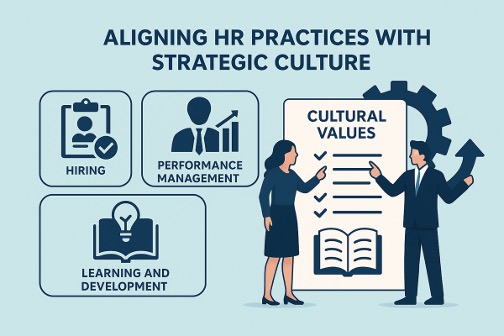
They will monitor cultural shifts over time using feedback and behavioral data. This includes pulse surveys storytelling audits engagement metrics and retrospective interviews. Participants will create a simple dashboard or scorecard to track progress and guide ongoing alignment efforts.
Content Overview
The session begins by exploring the invisible force of organizational culture. Participants examine how culture shows up not only in formal processes but also in informal habits, power dynamics, and day to day interactions. They consider how culture manifests in decisions, meetings, incentives, communication styles, and customer interactions. Culture influences everything from how risk is perceived to how feedback is delivered and how innovation is supported. Through guided exercises participants are encouraged to identify cultural strengths and blind spots within their own organizations. They assess how these cultural characteristics either support or hinder strategic goals and transformation efforts. This opening section lays the foundation for understanding culture not as a soft intangible element but as a concrete force that leaders can influence. By engaging with real case scenarios participants begin to contextualize how cultural factors have contributed to success or stagnation in key organizational initiatives. These insights help deepen their appreciation of culture as both a strategic asset and a potential liability. Participants also discuss how organizational subcultures within different departments can evolve and clash and how to create bridges between them.
Next the module introduces structured frameworks such as the Competing Values Framework and the Denison Organizational Culture Model to help participants assess cultural dynamics. The Competing Values Framework provides a lens to examine how organizations balance competing tensions such as flexibility versus control or internal versus external orientation. Participants map where their organization currently sits and where it needs to evolve based on strategic direction. The Denison Model introduces dimensions such as mission adaptability involvement and consistency. Participants use these dimensions to identify cultural gaps and areas of strength. They learn how to conduct culture audits through interviews focus groups surveys and behavioral observation. These methods help uncover both visible and invisible norms within the workplace. Emphasis is placed on triangulating data to create a balanced and actionable cultural profile that informs leadership decisions. Participants will then connect these insights with transformation readiness metrics and develop hypotheses for cultural intervention points. They will also reflect on how these tools can be used to initiate inclusive discussions across departments and roles. This analysis is enhanced by mapping historical culture shifts and identifying patterns that explain the current environment.
The focus then shifts to the role of leadership in shaping and sustaining culture. Participants reflect on how their own behaviors either reinforce or contradict strategic values. Through leadership journaling and peer feedback exercises they explore how visible habits such as meeting facilitation listening styles decision making and recognition practices either support or erode the cultural tone. Case studies are used to explore leadership alignment challenges during digital and agile transformations. For example, a leader who promotes agile values but insists on centralized control may send mixed signals that confuse teams. Participants learn how to resolve these contradictions through behavior modeling and aligned decision making. They also explore how leadership vulnerability authenticity and consistency build cultural trust and credibility. This reflection includes examining how micro behaviors and informal communication patterns signal cultural expectations. Participants will be encouraged to document one behavior change they can implement immediately to demonstrate cultural alignment in their teams. Additionally, they will review how leaders at different levels influence culture through symbolic gestures resource allocation and public communication.
Tools such as the Culture Canvas and Behavioral Anchors Matrix help participants design initiatives that influence hiring onboarding feedback loops recognition programs and learning strategies. The Culture Canvas allows participants to map values behaviors symbols and systems in a structured way. It helps them identify where alignment is strong and where interventions are needed. The Behavioral Anchors Matrix links abstract values to observable actions making it easier to train reward and evaluate culture aligned behaviors. For instance, if collaboration is a value behavioral anchors might include cross functional problem solving and shared decision making. Participants work through these tools using real examples from their own contexts. They design pilot initiatives that reinforce desired shifts including structured onboarding messages coaching protocols recognition criteria and peer learning models. Each initiative is crafted to be both culturally resonant and operationally feasible. These tools help operationalize culture and prevent it from remaining a conceptual aspiration. Participants also build crosswalks between these cultural practices and performance metrics used in existing systems such as OKRs or competency frameworks. They will simulate conversations with HR and learning teams to ensure alignment and long-term adoption.
The module concludes with strategies for embedding culture through storytelling symbolic actions and peer driven accountability. Participants explore how stories about success failure resilience and change—become vehicles for transmitting values and shaping identity. They learn how to collect and curate stories that align with strategic priorities and how to tell them in a way that inspires and connects. Symbolic actions such as how leaders respond to failure what gets celebrated and who gets promoted send strong cultural signals. Participants identify high leverage symbolic opportunities within their own organization. They also explore how to build peer driven accountability structures such as team norms feedback rituals and cross team learning circles that reinforce shared ownership of culture. Leaders learn to make values visible celebrate small wins and create rituals that embody the change. Examples include value-based recognition programs storytelling events and reflection practices during retrospectives or town halls. These rituals can become powerful reinforcement mechanisms especially during periods of change and uncertainty. Participants also discuss how to adapt these rituals in hybrid or remote environments to preserve cohesion and morale. They evaluate how rituals and stories can evolve over time without losing their core message and how cultural artifacts can be shared across distributed teams.
In summary this content overview helps participants understand that cultural alignment is not a side project but a core lever of strategy execution. Through frameworks tools and personal reflection leaders are empowered to diagnose their current culture and take intentional steps to shift it in ways that accelerate transformation. The session prepares participants to think systemically act authentically and lead with cultural clarity. They leave with a practical plan and renewed sense of agency for shaping the culture they lead. This equips them to not only lead their current initiatives with greater integrity and effectiveness but also to become long term cultural stewards within their organization. Ultimately cultural alignment becomes a continuous leadership practice that shapes the organization’s identity resilience and capacity to thrive in an evolving world. Participants are encouraged to form learning alliances with peers from the session to exchange insights as their cultural journeys unfold. The module closes with a commitment reflection where each leader identifies one cultural action they will take in the next 30 days and how they will measure its impact.

Case Study: Intuit’s Cultural Transformation to Enable Customer-Driven Innovation
In the mid-2000s, Intuit—known for software products like TurboTax and QuickBooks, was a well-established leader in the financial software space. However, innovation had slowed, and newer startups were beginning to gain market share. The CEO Scott Cook recognized that the company’s internal culture, dominated by risk-averse, efficiency-focused thinking was no longer sufficient to compete in a rapidly evolving digital landscape.
To reignite innovation, Intuit underwent a cultural transformation centered around customer obsession, rapid experimentation, and design thinking. The success of this shift was driven by intentional leadership and alignment of cultural values with the company’s new strategic priorities.
Establishing a Clear Innovation Mindset
Cook introduced a new cultural goal: “Design for Delight (D4D).” This philosophy encouraged teams to fall in love with customer problems, not just their own solutions. D4D focused on deep customer empathy, broad ideation, and rapid experimentation marking a significant cultural departure from Intuit’s legacy of cautious, methodical product development.
Executive-Led Cultural Modeling
Intuit’s top leaders including the CEO and CTO actively participated in and facilitated D4D workshops. This visible modeling from leadership sent a strong message that the new values were not just slogans – they were a required mindset. Leaders spoke regularly about customer stories, celebrated failed experiments, and shared personal learning moments.
Embedding Cultural Change into Daily Work
Rather than run culture initiatives as HR programs, Intuit embedded cultural practices into product team workflows. Agile rituals such as standups, retrospectives, and rapid prototyping became the norm. Leaders ensured that these rituals were practiced across all levels, from engineering to marketing. They also introduced the “Lean StartIN” program, which helped employees run short-term experiments and pitch ideas internally bringing entrepreneurial energy into the organization.
Measuring Cultural Adoption
Intuit developed internal tools to track how frequently teams used D4D practices and how those practices correlated with customer metrics. This data was used not to punish underperformance, but to coach leaders and teams on where cultural reinforcement was needed.
Scaling Through Champions
To scale the cultural shift, Intuit trained and deployed hundreds of “Innovation Catalysts”—internal coaches who mentored teams on D4D, agile, and customer-centric practices. These catalysts became culture carriers who could influence without formal authority, ensuring the message wasn’t confined to senior leadership.
Impact
Intuit’s Net Promoter Score (NPS) rose significantly across product lines. Time-to-market for new features and products shortened dramatically. Internal employee engagement scores improved, especially in product and engineering teams. Intuit regained its reputation as an innovation leader, launching successful new platforms such as Mint, QuickBooks Live, and TurboTax AI Assist.

Group Exercise: Leadership & Cultural Alignment Workshop
As a group, list two essential cultural attributes needed to achieve your strategic goals.
Briefly discuss:
-One existing behavior aligning well with desired attributes.
-One behavior clearly misaligned or lacking.
Select one significant barrier preventing cultural alignment. Clearly state why this barrier is critical.
Define a simple, actionable step to overcome the barrier, specifying:
-Action to take.
-Stakeholder responsible.
-A clear metric for measuring success.
Each participant briefly states one specific commitment they’ll make to reinforce the desired culture.
Confirm the actions and commitments are clear, practical, and will effectively strengthen cultural alignment.
Summary
Culture is not a backdrop to strategy. It is the environment in which strategy lives or dies. Leaders who understand how to shape culture through communication, behavior, and systems are far more likely to realize their vision.
This module prepares participants to lead cultural transformation intentionally. It reinforces that the soft stuff: trust, values, mindset is in fact the hardest and most critical lever for sustainable strategic success.

Course Manual 10: Execution & Roadmap Development (ERD)
Introduction
Even the most compelling vision, the most aligned culture, and the most strategic plans will fall short without execution. For technology leaders, the ability to translate strategy into action and action into results is the true test of leadership. Execution bridges the gap between intent and impact, and roadmap development is the foundation on which that bridge is built. It transforms abstract goals into concrete milestones and ensures that efforts are not just aligned but also sustained over time.
Image too small
Technology environments today are marked by volatility, complexity, and constant evolution. Strategic clarity is essential, but it must be paired with a disciplined approach to execution. In this module, participants explore what it means to lead execution not just as a technical process but as a leadership capability. They examine how execution creates credibility, fosters trust, and builds organizational momentum. Poor execution, on the other hand, can erode even the strongest strategies and create cycles of disengagement and rework.
This module provides a structured approach to executing technology strategies with clarity and momentum. Participants begin by exploring the distinction between strategy formulation and execution. While strategy defines the direction, execution determines whether that direction is ever realized. Leaders must be skilled in both disciplines and understand how to shift between long-term thinking and immediate action. The module emphasizes that execution is not the endpoint of strategy but a continuation of it, expressed in movement and delivery.
Participants will focus on breaking down strategic objectives into executable workstreams. They will learn techniques such as decomposition, prioritization, and milestone mapping. These tools help translate complex goals into manageable initiatives that can be tracked, resourced, and delivered. For example, a strategic goal of becoming a data-driven enterprise may translate into multiple initiatives, such as data infrastructure upgrades, data literacy programs, and analytics capability development. Participants will practice mapping these connections and clarifying ownership and sequencing.
Sequencing is another major focus of the module. Leaders often struggle not with what needs to be done, but with when and in what order. Poor sequencing can lead to bottlenecks, resource overload, and stakeholder fatigue. Participants learn to use readiness assessments, dependency mapping, and phased delivery models to plan initiatives in a way that balances ambition with capacity. They explore how to identify critical path activities, how to stagger interdependent projects, and how to time efforts with change readiness across the organization.
The module also introduces dynamic roadmap development as a living discipline rather than a static plan. Participants will build roadmaps that reflect both strategic intent and operational flexibility. These roadmaps must accommodate new information, changing conditions, and iterative learning. The ability to pivot without losing direction is key to resilient execution. Participants will work with roadmap templates that include quarterly themes, initiative milestones, performance checkpoints, and stakeholder communication plans. These tools help teams stay focused while remaining adaptable.
Execution is also deeply tied to communication and visibility. Participants learn how to establish routines such as leadership standups, delivery forums, and cross-functional syncs that reinforce alignment and accountability. They explore the role of visual management tools, such as kanban boards and delivery dashboards, in keeping teams focused and informed. Emphasis is placed on surfacing blockers early, celebrating progress, and maintaining shared understanding throughout the execution journey.
Participants also study how to manage execution risks, including scope drift, stakeholder disengagement, and competing priorities. They learn mitigation techniques such as phase gates, delivery scorecards, and rapid escalation protocols. Leaders are encouraged to foster an execution culture that combines discipline with empathy. This includes making space for team retrospectives, acknowledging setbacks without blame, and encouraging psychological safety even in high-stakes delivery environments.
The module highlights that effective execution requires energy management as much as resource management. Participants examine the human dynamics of execution: how burnout occurs, how morale is sustained, and how to create pacing that motivates without overwhelming. Leaders are encouraged to view their execution plan not only as a delivery vehicle but as a leadership rhythm—one that guides momentum, energizes teams, and builds shared purpose. They explore cadence-building practices such as quarterly planning days, monthly review huddles, and weekly pulse checks to create structure without rigidity.
Participants will also explore how to incorporate agile delivery principles into roadmap execution. While not every organization operates in an agile environment, the underlying principles of iteration, feedback, and continuous improvement can benefit all types of execution models. The module introduces hybrid approaches that combine agile flexibility with waterfall clarity. For example, using sprints to deliver milestones within a longer-term roadmap structure or building in retrospectives even in fixed-scope programs. These blended models allow for adaptability while maintaining direction.
The importance of stakeholder engagement throughout execution is another core focus. Participants examine how to keep stakeholders aligned and informed through regular touchpoints, transparent reporting, and proactive issue resolution. They learn techniques to manage executive expectations, keep cross-functional partners in the loop, and build trust through follow-through. Participants also explore how to tailor updates and progress narratives to different audiences, from board members to frontline teams.
The final segment of the module helps participants build their personal execution blueprint. This includes defining their strategic initiative, decomposing it into delivery streams, sequencing key activities, identifying metrics, and mapping leadership routines. The blueprint becomes both a tactical plan and a leadership commitment. It represents the participant’s approach to not just getting things done, but getting the right things done in the right way. Participants leave the session with a roadmap they can take back to their teams and use as a foundation for immediate execution.
Throughout the module, real-world case studies are used to illustrate both successful and failed execution efforts. These examples highlight the nuances of execution—how the same strategy can succeed in one context and fail in another due to execution gaps. Participants engage in reflection exercises where they map past initiatives and evaluate where execution strengthened or undermined impact. These reflections deepen their understanding of execution as a systemic leadership challenge, not just a delivery task.
In summary, this module redefines execution as a strategic leadership act. It empowers participants with tools, frameworks, and practices to deliver results with focus, agility, and integrity. Execution is not simply the implementation of a plan; it is the daily discipline of transforming strategy into value. With a clear roadmap, aligned rituals, and resilient pacing, leaders become architects of progress. They ensure that strategy is not just spoken but realized, and that impact is not just intended but achieved.
Learning Objectives
By the end of this module, participants will be able to develop technology execution plans that reflect strategic priorities. They will learn how to move from abstract strategic themes to specific delivery plans that align with enterprise goals. Participants will focus on selecting initiatives that drive measurable impact and using prioritization frameworks to ensure efforts stay aligned with long-term direction.
Participants will also be able to translate long-term goals into actionable short-term milestones. They will learn how to break down multi-year objectives into quarterly and monthly goals that create a sense of momentum and focus. This includes establishing workstreams, setting measurable targets, and assigning accountability across teams.
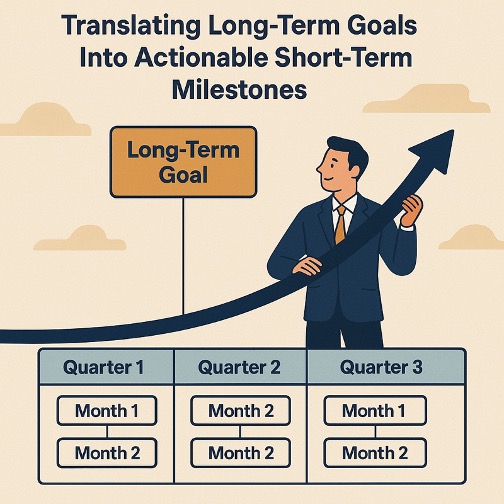
They will build clear and adaptive roadmaps using agile and hybrid frameworks. Participants will explore how to sequence initiatives, map dependencies, and integrate flexibility into execution. They will learn how to use visual roadmaps as communication tools that keep cross-functional teams aligned and leadership stakeholders informed.
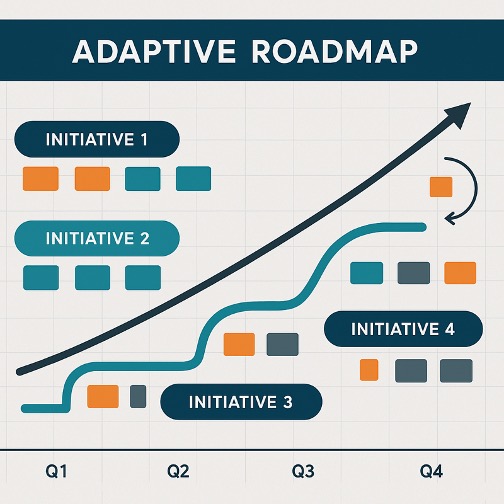
Participants will manage interdependencies across cross-functional teams. They will assess how coordination challenges arise when initiatives overlap or compete for shared resources. Strategies will include dependency mapping, joint planning sessions, and rhythm-of-business routines that facilitate collaboration.
They will identify execution risks and create mitigation strategies to handle scope creep, delays, and resource bottlenecks. Participants will learn to apply risk assessment techniques such as RAID logs and early warning indicators. They will also develop contingency plans to minimize the impact of disruptions.
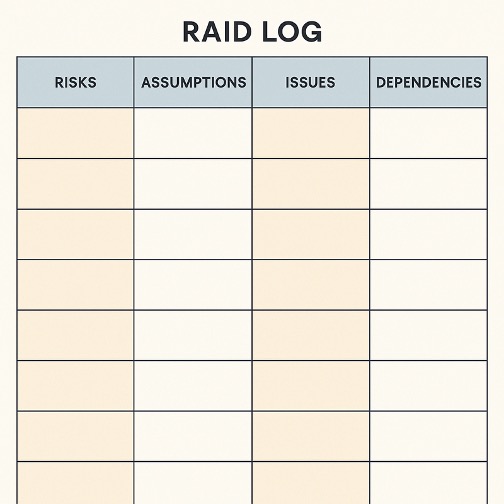
Establishing governance and accountability structures for initiative delivery is another core objective. Participants will define roles, escalation paths, and progress tracking systems to ensure initiatives stay on course. They will also design leadership review cadences that enable regular oversight and agile decision-making.
Participants will integrate roadmap planning into budgeting and resource allocation cycles. They will learn how to align financial planning with delivery timing and ensure that resources—both people and capital—are available at key execution moments.
They will align teams around common execution metrics and success definitions. Participants will define clear outcomes, shared KPIs, and aligned dashboards that support cross-team visibility and performance clarity.
Applying agile practices to increase delivery cadence and responsiveness is a key learning area. Participants will explore how agile ceremonies, such as sprint planning and retrospectives, can enhance momentum and create feedback loops for continuous improvement.
Participants will also learn to communicate progress to stakeholders with transparency and clarity. They will create communication plans that define what gets shared, with whom, how often, and through which channels. Emphasis will be placed on tailoring the message to different audiences.
Finally, participants will adjust plans dynamically in response to business or market shifts and foster a culture of disciplined execution and iterative learning. They will establish review loops, promote experimentation, and instill accountability systems that support learning while driving delivery. Together, these competencies equip leaders to turn vision into measurable impact and navigate complexity with discipline and agility.
Content Overview
The module begins by reframing execution as a leadership discipline rather than simply a project management function. Participants are introduced to the concept that execution is not the tail end of strategy but the embodiment of it. The ability to consistently deliver on what has been envisioned and committed to is not just an operational necessity but a direct reflection of leadership capability. Through guided discussions and reflective exercises, participants examine past strategic initiatives that either stalled or fell short. They analyze root causes that go beyond technical breakdowns to include unclear ownership structures, overambitious timelines, lack of prioritization, and failure to build momentum early. Participants also review examples where a lack of communication or insufficient stakeholder engagement undermined well-designed plans. This segment invites leaders to see execution challenges as cultural and structural in nature, offering a more holistic lens for diagnosing and addressing them. Participants also begin to form a mental model for execution as an evolving discipline, one that requires leadership maturity and organizational empathy.
Next, participants learn how to deconstruct strategic initiatives into phases, outcomes, and deliverables. This decomposition process is essential for turning broad aspirations into manageable execution units. The module provides a step-by-step guide to breaking down large programs into coordinated workstreams. Emphasis is placed on defining clear success outcomes for each phase and identifying interdependencies early. Participants explore how to align team workflows with strategic objectives while maintaining focus on value creation. Agile and hybrid planning models are introduced as flexible scaffolds that support iteration without sacrificing strategic clarity. For example, leaders might use quarterly roadmaps for thematic planning and combine these with bi-weekly sprints to deliver increments of value. Case examples show how organizations shift from rigid waterfall models to more fluid, responsive planning frameworks that allow for faster learning and course correction. Additional emphasis is placed on how to evaluate which planning frameworks best fit specific organizational contexts based on complexity, culture, and resource capacity.
A significant focus is placed on the principle of Minimum Viable Delivery (MVD). Participants learn that delivering early value is not just a tactical move—it is a strategic behavior that builds credibility, motivates teams, and reduces risk. MVD emphasizes that progress is best measured not by effort but by visible impact. Leaders are encouraged to identify and sequence low-lift, high-value deliverables that demonstrate movement and enable learning. Early wins are positioned as morale boosters and strategic signals to the broader organization that execution is underway. Through hands-on exercises, participants map out early wins and pressure-test them for feasibility and alignment. They explore how early successes can be used as communication assets to rally stakeholder support and attract additional investment or sponsorship. The concept of MVD is also linked to the idea of adaptive leadership, reinforcing the importance of building momentum even in the face of ambiguity.
Participants are then guided through the roadmap creation process. They are taught how to define execution initiatives, assign realistic timeframes, and map dependencies with precision. This includes identifying long-lead tasks, coordinating cross-functional inputs, and avoiding common scheduling traps such as overloading critical paths. Roadmaps are not presented as static documents but as visual thinking tools that support prioritization, sequencing, and visibility. Participants explore the benefits and limitations of various visualization formats including Gantt charts, Kanban boards, swimlane timelines, and OKR trackers. They experiment with different formats to suit different leadership audiences and decision contexts. For instance, a detailed Gantt may be useful for project-level operations, while a strategic OKR roadmap may better suit executive reviews. Participants also explore how color coding, icons, and annotations can increase clarity and invite engagement from nontechnical stakeholders. Leaders are encouraged to tailor roadmaps not just to fit the plan but to enhance collaboration and accelerate buy-in.
Another critical element explored in the module is execution governance. Participants review how governance structures can either empower or hinder delivery. Leaders are encouraged to move beyond the idea of governance as mere oversight and embrace it as an enabler of speed and alignment. They learn to create steering committees that include both decision-makers and influencers, ensuring that strategic blockers are surfaced and resolved quickly. Cadence rituals such as weekly standups, monthly health checks, and quarterly retrospectives are introduced as mechanisms for maintaining alignment without adding bureaucratic weight. Participants evaluate which rituals fit their own context and learn how to tailor governance cadences for fast-moving initiatives versus long-horizon transformations. Escalation pathways are also explored. Leaders learn how to formalize escalation rules, define thresholds for issue surfacing, and build psychological safety into escalation culture. The goal is to reduce decision latency while maintaining alignment and engagement. Participants also examine the role of executive sponsors in removing roadblocks and reinforcing accountability throughout the execution lifecycle.
Throughout the module, execution is positioned not as a one-time phase that follows strategy, but as a continuous, adaptive process that evolves with new insights and changing priorities. Participants discuss the risks of treating execution as a linear journey and instead explore models for iterative execution. The concept of rolling roadmaps is introduced—where plans are updated quarterly or monthly based on feedback, performance data, or changes in the external environment. Participants are shown how to incorporate metrics such as delivery velocity, resource load balancing, and stakeholder confidence scores into roadmap review cycles. These metrics are used not just for monitoring but for coaching and improvement. Leaders are encouraged to view each review cycle as an opportunity to reset expectations, celebrate progress, and reinforce cultural norms around ownership and delivery. This reinforces the belief that great execution is a learning journey, not a one-time task.
The module emphasizes the leadership behaviors that support effective execution. These include consistency, follow-through, transparency, and presence. Leaders must be visible not just during planning sessions but throughout the execution lifecycle. Through simulation activities, participants practice responding to execution setbacks, re-aligning teams under pressure, and communicating delivery narratives with honesty and optimism. They explore how to use storytelling and data in tandem to keep teams engaged and stakeholders informed. For example, participants draft “progress scripts” they can use to narrate execution milestones in town halls or board updates. These scripts blend facts with framing to convey not only what has happened but why it matters and what is next. Participants also reflect on how their tone, presence, and resilience impact team energy during times of execution stress or resource constraints.
Finally, participants create a customized Execution Blueprint. This output synthesizes the module’s content into a practical tool they can use in their real-world initiatives. The blueprint includes execution objectives, key initiatives, milestones, early wins, dependency maps, risk registers, governance rhythms, stakeholder engagement plans, and metrics dashboards. It is designed to serve both as a delivery plan and a communication artifact. Participants present their blueprints to peers for feedback and coaching. The collaborative review process deepens understanding and builds accountability. Participants leave the session with a living artifact they can use to align teams, update sponsors, and manage delivery in real time. The blueprint becomes a centerpiece for ongoing leadership conversations and a signal of execution maturity.
In summary, this content overview grounds execution in leadership practice. It equips participants with tools, templates, and behaviors that help them turn vision into value consistently and credibly. Execution is no longer the afterthought to strategy—it becomes the heartbeat of enterprise leadership. With strong roadmaps, resilient rhythms, and clear governance, technology leaders are empowered to deliver results that are both strategic and sustainable. Participants gain not just methods but the mindset to lead execution with agility, transparency, and integrity in today’s evolving business landscape.

Case Study: IBM’s Hybrid Cloud Transformation Roadmap
In 2018, IBM undertook one of its most significant strategic transformations—pivoting its core business toward hybrid cloud and AI. This shift required the integration of legacy infrastructure services with modern cloud platforms, retraining a global workforce, and the successful acquisition and integration of Red Hat.
IBM’s success was rooted in a well-structured execution and roadmap development process that spanned multiple business units and geographies.
Defining the Transformation Outcomes
IBM’s leadership began by clearly articulating the outcomes they wanted to achieve – grow cloud revenue, improve developer experience, retain enterprise clients during the transition, and deliver a unified hybrid cloud platform. These were broken down into key execution themes – platform integration, developer tooling, go-to-market alignment, and cultural reskilling.
Developing the Roadmap
Each theme was translated into phased initiatives with clear milestones. For example, the Red Hat integration was divided into short, medium, and long-term actions, including containerization of key software, sales team alignment, and platform bundling.
Visual roadmaps were developed across three horizons: 6-month tactical execution, 18-month strategic rollout, and 3-year innovation pipeline. These were updated quarterly and used in global strategy syncs.
Governance and Cadence
IBM created cross-functional steering committees for each roadmap track, including business, engineering, product, and operations leads. Each committee followed a monthly operating rhythm, supported by agile planning tools and metrics dashboards.
Risk Management and Adaptation
Execution risks such as client migration churn and talent gaps were addressed through targeted mitigation strategies such as client retention incentive programs and upskilling bootcamps for key technical roles.
Impact
By 2022, IBM had transformed its business mix with over half its revenue tied to hybrid cloud and AI. Red Hat’s open-source platform became a strategic engine for innovation within IBM’s ecosystem. The transformation not only revitalized IBM’s relevance in enterprise IT but demonstrated that disciplined execution, paired with strategic clarity, can accelerate a pivot even in a legacy organization.

Group Exercise: Execution & Roadmap Development Workshop
Briefly state two strategic objectives that your roadmap must achieve. Objectives should be clear, measurable, and achievable.
Define three simple phases for executing your strategy:
-Initial actions (foundation)
-Main implementation (development)
-Completion and refinement (deployment)
Identify a primary accountable stakeholder for each phase, noting any key dependency that could impact success.
List one clear milestone per phase and one key metric (KPI) for tracking progress.
Briefly describe one significant risk and a simple action to mitigate it.
Confirm your roadmap is clear, practical, and aligned with strategic goals and capabilities.
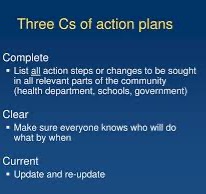 Summary
Summary
Execution is where strategy becomes reality. Without a clear plan, rhythm, and system for delivery, even the boldest vision will stall. This module empowers technology leaders to lead with discipline, urgency, and adaptability building roadmaps that deliver measurable value and sustain strategic momentum.
Participants will leave with a roadmap development toolkit and the leadership practices to turn plans into progress, navigating complexity with clarity and building trust through delivery.
Conclusion & Action Plan
At the end of this workshop, participants will:
Have a well-defined strategic vision for technology leadership
Understand how to align technology with business strategy
Develop concrete plans for execution and stakeholder alignment
Gain tools to measure and adjust strategic direction over time

Final Exercise: Presenting Your Strategic Vision
Step 2: Prepare a five-minute presentation.
Step 3: Deliver your presentation to a panel for feedback.
Step 4: Incorporate feedback into a refined version of your strategic vision.
Step 5: Develop a follow-up plan to implement and measure success.
Project Studies
Project Study (Part 1) – Strategic Vision
Introduction:
Visualize a future scenario (within a 1 to 3-year horizon) in which your organization has successfully adopted a clearly articulated strategic vision aligned with its core mission. Describe the most significant changes this vision would produce. Which changes are most desirable, and why?
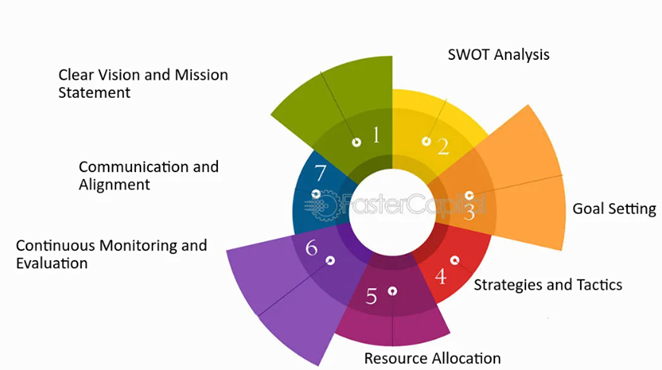
Strengths of Your Organization:
Analyze your organization’s unique strengths and capabilities that will facilitate the achievement of your strategic vision. Describe cultural attributes, technical competencies, and organizational characteristics that are distinctive and valuable. Specify how you intend to leverage these assets to realize your vision.
Key assets might include:
• A strong brand or reputation
• Established customer base
• Proprietary technology or processes
• Skilled workforce
• Strategic partnerships and networks
• Robust financial position
External and Internal Analysis:
• Conduct an external analysis to identify at least three critical industry or market trends influencing your organization’s strategic positioning.
• Complete an internal readiness assessment highlighting current strengths, weaknesses, opportunities, and threats (SWOT) relevant to achieving your strategic objectives.
• Identify gaps between your current state and desired future state, including resource, capability, and technological requirements.
Strategic Vision Statement:
Develop a clear, concise, and compelling Strategic Vision Statement that integrates your organization’s mission, identified market trends, and internal analysis insights. The vision should inspire and guide stakeholders throughout your strategic journey. Example:
“Our organization aims to be the industry leader in innovative digital solutions, empowering businesses through cutting-edge technology, exceptional customer experiences, and agile operational excellence within the next three years.”
Action Plan – Strategic Vision Implementation:
Detail specific steps you will take within the next month to communicate and begin implementing your strategic vision, including:
Stakeholder Communication:
• Develop customized messaging for different stakeholder groups (executives, managers, employees).
• Schedule and conduct initial strategic vision presentations and discussions.
Capability Building:
• Identify training or hiring requirements to fill critical skill gaps.
• Initiate first-round training or recruitment activities.
Resource Alignment:
• Reallocate or secure necessary financial and technological resources to support early-stage initiatives.
Monitoring & Feedback:
• Establish metrics and monitoring tools to track early progress.
• Plan initial feedback sessions to assess stakeholder response and refine strategy execution.
Expected Outcomes:
• Clear organizational understanding of the strategic vision and its implications.
• Enhanced alignment and motivation among stakeholders.
• Identification and initial addressing of critical capability and resource gaps.
• Established mechanisms for ongoing feedback and strategy refinement.
Action Plan Review:
At the end of the one-month period, assess your progress against the planned actions. Document successes, challenges encountered, stakeholder feedback, and lessons learned. Adjust your strategic implementation plan accordingly to ensure continued progress towards your vision.
Inputs:
• Internal and external environmental analyses
• Organizational capability assessments
• Strategic visioning exercises from workshop sessions
Outputs:
• Comprehensive Strategic Vision Document
• Detailed action plan with clear milestones
• Initial stakeholder communication outcomes
• First-stage implementation progress report and strategic adjustments
Note:
This document will serve as a foundational blueprint guiding strategic initiatives, ensuring clarity, alignment, and structured implementation to achieve your organization’s future goals.
Project Study (Part 2) – Strategic Foresight
Introduction:
Visualize a scenario (within a 1 to 3-year horizon) in which your organization has effectively integrated strategic foresight practices into its regular planning processes. Describe the key changes and benefits this integration would yield. Which of these changes are most desirable, and why?
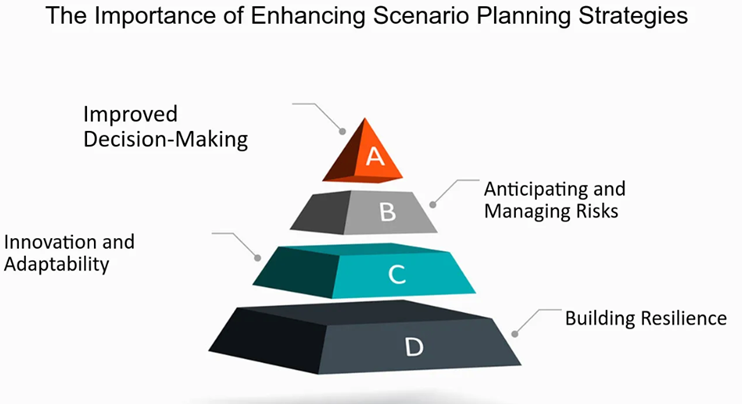
Strengths of Your Organization:
Assess and detail your organization’s inherent strengths and capacities that will facilitate the adoption and practice of strategic foresight. Outline specific cultural, technical, and organizational attributes that position your organization uniquely to benefit from foresight methodologies.
Key assets might include:
• Adaptability and responsiveness to change
• Strong analytical and data-driven capabilities
• A culture supportive of innovation and experimentation
• Proactive risk management practices
• Established channels for internal and external communication
• Cross-functional collaboration capabilities
External and Internal Analysis:
• Conduct an external trend analysis identifying at least three key future-oriented trends or disruptions that could significantly impact your organization or industry.
• Perform an internal assessment to evaluate your organization’s current preparedness and capability to engage effectively in strategic foresight activities, detailing strengths, weaknesses, opportunities, and threats.
• Identify existing gaps between current organizational practices and the requirements for robust foresight integration.
Strategic Foresight Statement:
Develop a clear and actionable Strategic Foresight Statement that synthesizes insights from your external and internal analyses. This statement should guide proactive decision-making and risk management.
Example:
“Our organization proactively navigates future uncertainties by continuously identifying and evaluating emerging trends and risks, leveraging foresight methodologies to foster strategic agility and sustained competitive advantage within the next three years.”
Action Plan – Strategic Foresight Implementation:
Detail concrete actions you will undertake within the next month to integrate and initiate your strategic foresight practices:
Stakeholder Communication:
• Develop targeted communications explaining the value and purpose of strategic foresight to executives, managers, and operational teams.
• Schedule and facilitate initial workshops or informational sessions to introduce strategic foresight concepts and their organizational relevance.
Capability Building:
• Identify and plan foresight training programs to equip team members with necessary skills such as trend analysis, scenario planning, and forecasting.
• Begin initial training or certification programs in strategic foresight for key personnel.
Resource Alignment:
• Allocate or secure budget and technological tools (such as forecasting software) essential for foresight activities.
Monitoring & Feedback:
• Develop specific metrics to measure early-stage adoption and effectiveness of strategic foresight practices.
• Schedule initial review meetings to collect feedback, gauge stakeholder engagement, and adjust implementation strategies accordingly.
Expected Outcomes:
• Increased organizational awareness and understanding of strategic foresight.
• Improved capability to anticipate and respond to emerging trends and disruptions.
• Strengthened preparedness and resilience against future uncertainties.
• Established continuous improvement and adaptation mechanisms.
Action Plan Review:
At the conclusion of the one-month period, evaluate progress against your defined action steps. Document achievements, barriers encountered, stakeholder reactions, and insights gained. Refine your foresight integration plan to maintain momentum and ensure sustained organizational readiness.
Inputs:
• External trends analysis
• Internal capability assessments
• Strategic foresight exercises and outcomes from workshop sessions
Outputs:
• Comprehensive Strategic Foresight Document
• Detailed action plan outlining implementation milestones
• Initial communications and training program outcomes
• Preliminary monitoring results and strategic adjustments
Note:
This document serves as a foundational guide for embedding strategic foresight within organizational practices, promoting continuous learning, agility, and long-term strategic resilience.
Project Study (Part 3) – Aligning with Business Goals
Introduction:
Visualize a scenario (within a 1 to 3-year horizon) where your organization successfully aligns technology initiatives with overarching business goals. Identify the key improvements and benefits this alignment would produce. Highlight the most impactful and desirable changes and explain their significance.

Strengths of Your Organization:
Examine your organization’s unique strengths and attributes that will facilitate the effective alignment of technology initiatives with business goals. Outline the specific cultural, technical, and operational characteristics that distinctly position your organization for successful alignment.
Key assets might include:
• Clear and strong executive sponsorship
• Effective internal communication mechanisms
• A culture of collaboration across business units
• Robust strategic planning processes
• Established performance measurement systems
• Highly skilled and adaptable workforce
External and Internal Analysis:
• Conduct an external analysis identifying at least three critical industry trends or competitive pressures necessitating closer alignment of technology initiatives and business strategies.
• Undertake an internal analysis evaluating your organization’s current alignment effectiveness, highlighting strengths, weaknesses, opportunities, and threats (SWOT).
• Determine key gaps between current practices and desired alignment levels, including capability, structural, and technological gaps.
Alignment Strategy Statement:
Formulate a concise and strategic Alignment Strategy Statement integrating insights from your external and internal analyses. This statement should clearly articulate the approach and desired outcomes for aligning technology initiatives with organizational objectives.
Example:
“Our organization will systematically align technology initiatives with strategic business objectives, ensuring optimized resource allocation, enhanced operational effectiveness, and sustained competitive advantage within the next three years.”
Action Plan – Business Goals Alignment Implementation:
Define concrete actions to initiate the alignment of technology initiatives with business goals within the next month:
Stakeholder Communication:
• Develop customized communication strategies emphasizing the importance and benefits of alignment for executives, department leaders, and operational teams.
• Plan and execute initial alignment workshops and collaborative sessions.
Capability Building:
• Identify necessary skill development or knowledge gaps and plan targeted training sessions or hiring initiatives.
• Launch initial alignment training sessions focusing on strategic planning and integrated project management.
Resource Alignment:
• Identify and realign financial, technological, and human resources to support prioritized aligned initiatives.
Monitoring & Feedback:
• Establish key performance indicators (KPIs) and monitoring systems to track alignment progress and effectiveness.
• Schedule initial feedback sessions to assess stakeholder perspectives and refine alignment strategies.
Expected Outcomes:
• Improved clarity and consistency in organizational priorities and resource allocation.
• Enhanced efficiency and effectiveness of strategic technology investments.
• Increased organizational agility and responsiveness to market dynamics.
• Establishment of robust continuous improvement practices.
Action Plan Review:
After one month, evaluate progress against your action plan. Document key successes, encountered obstacles, stakeholder responses, and gained insights. Refine and update your alignment implementation plan to ensure ongoing effectiveness and strategic coherence.
Inputs:
• External and internal alignment analysis
• Organizational capability and readiness assessments
• Strategic alignment exercises and workshop insights
Outputs:
• Detailed Alignment Strategy Document
• Comprehensive action plan with defined milestones
• Outcomes from initial communication and training sessions
• Early-stage alignment monitoring results and strategic adjustments
Note:
This document will serve as a strategic guide to effectively align your organization’s technology initiatives with its broader business objectives, ensuring cohesive progress towards achieving strategic organizational goals.
Project Study (Part 4) – Gap Analysis for Strategic Decision-Making
Introduction:
Visualize a scenario (within a 1 to 3-year horizon) in which your organization systematically conducts gap analyses to support strategic decision-making effectively. Outline the primary improvements and strategic advantages resulting from this systematic approach. Highlight which improvements are most impactful and why.
Image too small
Strengths of Your Organization:
Analyze and document the unique strengths of your organization that will enable effective gap analyses for strategic decision-making. Describe the cultural attributes, technical capabilities, and operational characteristics that uniquely position your organization to conduct thorough and insightful gap analyses.
Key assets might include:
• Strong analytical capabilities
• Robust decision-making processes
• A culture of continuous improvement
• Effective cross-departmental collaboration
• Reliable data collection and management systems
• Clearly defined roles and responsibilities
External and Internal Analysis:
• Perform an external analysis to identify at least three significant trends, disruptions, or pressures that necessitate regular gap analyses to inform strategic decisions.
• Conduct an internal analysis to evaluate your current practices related to gap analysis and strategic decision-making, clearly documenting strengths, weaknesses, opportunities, and threats (SWOT).
• Identify critical gaps between your existing methodologies and the ideal state required for consistently impactful strategic decisions.
Gap Analysis Strategy Statement:
Develop a concise and actionable Gap Analysis Strategy Statement that synthesizes external trends, internal capabilities, and strategic priorities. This statement should outline the organization’s commitment to utilizing gap analyses for informed strategic decision-making.
Example:
“Our organization will systematically employ rigorous gap analysis methodologies to identify critical performance and capability shortfalls, facilitating strategic decisions that drive competitive advantage, operational efficiency, and sustainable growth within the next three years.”
Action Plan – Gap Analysis Implementation:
Define clear, actionable steps to implement systematic gap analysis practices within the next month:
Stakeholder Communication:
• Craft tailored communication strategies highlighting the purpose, value, and methodology of gap analyses for different stakeholder groups (executives, managers, operational teams).
• Plan and conduct initial workshops or informational sessions to introduce gap analysis techniques and their strategic importance.
Capability Building:
• Identify and plan necessary training to build expertise in gap analysis methodologies and strategic decision-making.
• Initiate targeted training sessions for selected team members.
Resource Alignment:
• Allocate necessary resources, including analytical tools, data management systems, and expert personnel, to support gap analysis initiatives.
Monitoring & Feedback:
• Establish clear metrics and evaluation criteria for assessing the effectiveness and outcomes of gap analyses.
• Schedule initial review sessions to gather stakeholder feedback, assess early outcomes, and make necessary adjustments.
Expected Outcomes:
• Enhanced clarity and precision in identifying critical gaps affecting organizational performance.
• Improved strategic decision-making processes informed by data-driven insights.
• Increased organizational agility and responsiveness to emerging trends and internal needs.
• Institutionalization of continuous improvement practices.
Action Plan Review:
At the end of the one-month period, evaluate your organization’s progress relative to the defined actions. Document key successes, challenges, stakeholder feedback, and insights gained. Refine the implementation plan to ensure continuous improvement and alignment with strategic objectives.
Inputs:
• External market and industry trend analyses
• Internal capability and process evaluations
• Workshop outcomes related to gap analysis methodologies
Outputs:
• Comprehensive Gap Analysis Strategy Document
• Detailed action plan with measurable milestones
• Initial communication and training outcomes
• Preliminary monitoring and feedback results, and plan refinements
Note:
This document will serve as a strategic blueprint for incorporating systematic gap analysis practices into the organization’s decision-making processes, ensuring informed, effective, and strategically coherent outcomes.
Project Study (Part 5) – Prioritizing Technology Initiatives
Introduction:
Envision a scenario (within a 1 to 3-year horizon) in which your organization effectively prioritizes technology initiatives to maximize strategic impact. Clearly outline the primary benefits and improvements this prioritization approach would bring. Specify the most significant benefits and explain their importance to organizational success.
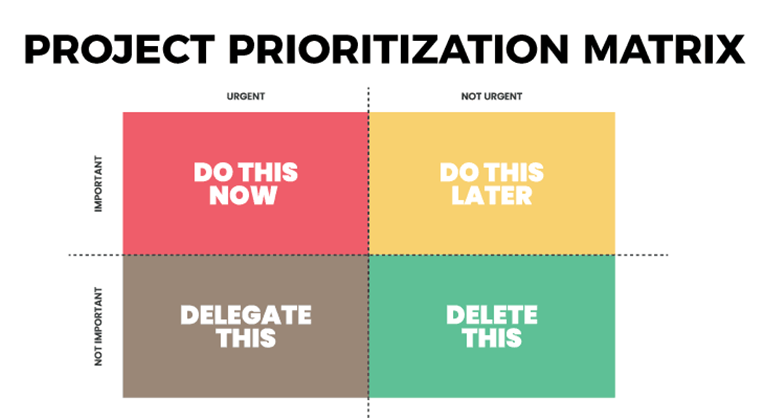
Strengths of Your Organization:
Detail your organization’s specific strengths and capabilities that will enable effective prioritization of technology initiatives. Highlight cultural attributes, technological proficiencies, and organizational frameworks uniquely suited to systematically prioritize initiatives.
Key assets might include:
• Established strategic planning frameworks
• Robust criteria for evaluating project impacts
• Strong executive sponsorship and support
• Cross-functional collaboration and alignment
• Effective resource allocation mechanisms
• Skilled project management personnel
External and Internal Analysis:
• Conduct an external analysis identifying at least three significant technological trends or industry dynamics that influence the necessity for prioritizing technology initiatives.
• Perform an internal evaluation of your current prioritization methods and identify strengths, weaknesses, opportunities, and threats (SWOT).
• Highlight critical gaps between your current prioritization approach and the optimal methods required for achieving your strategic goals.
Technology Prioritization Statement:
Formulate a clear and strategic Technology Prioritization Statement that synthesizes insights from your external and internal analyses. This statement should provide a clear direction on prioritizing technology initiatives effectively.
Example:
“Our organization will systematically prioritize technology initiatives by aligning them closely with strategic objectives, employing transparent evaluation criteria, and allocating resources efficiently to drive innovation, enhance competitiveness, and achieve sustainable growth over the next three years.”
Action Plan – Technology Prioritization Implementation:
Outline specific actions to initiate the prioritization of technology initiatives within the next month:
Stakeholder Communication:
• Develop targeted communication strategies highlighting the rationale and criteria for prioritizing technology initiatives to various stakeholders (executives, managers, and project teams).
• Conduct initial workshops or sessions explaining prioritization methodologies and engaging stakeholders in collaborative discussions.
Capability Building:
• Identify and plan training sessions to enhance capabilities in strategic evaluation and prioritization techniques.
• Begin initial training programs focusing on impact assessment, resource allocation, and prioritization methodologies.
Resource Alignment:
• Review and realign financial, human, and technological resources to ensure support for prioritized technology initiatives.
Monitoring & Feedback:
• Define specific metrics to evaluate the effectiveness and impact of prioritized initiatives.
• Schedule initial feedback sessions to review prioritization outcomes and stakeholder perceptions, making necessary adjustments based on insights.
Expected Outcomes:
• Enhanced clarity and transparency in decision-making processes related to technology investments.
• Improved strategic alignment and resource utilization.
• Increased organizational agility and proactive responsiveness to emerging opportunities and threats.
• Established continuous improvement practices.
Action Plan Review:
After one month, assess the organization’s progress relative to the defined prioritization actions. Document key successes, encountered obstacles, stakeholder feedback, and insights gained. Refine and adjust your prioritization plan accordingly to ensure ongoing strategic alignment and effectiveness.
Inputs:
• External technological and industry trend analyses
• Internal evaluation of current prioritization practices
• Insights from prioritization exercises conducted during workshops
Outputs:
• Comprehensive Technology Prioritization Document
• Detailed action plan with clear milestones
• Initial stakeholder communication and capability-building outcomes
• Early-stage monitoring and feedback results, along with strategic refinements
Note:
This document serves as a foundational guide for systematically prioritizing technology initiatives, ensuring alignment with strategic objectives, effective resource allocation, and maximized organizational impact.
Project Study (Part 6) – Scenario Planning for Agility
Introduction:
Visualize a scenario (within a 1 to 3-year horizon) where your organization has successfully integrated scenario planning practices to enhance agility and responsiveness. Outline the primary improvements and strategic advantages gained from this approach. Highlight which improvements are particularly valuable and explain why.
Strengths of Your Organization:
Evaluate your organization’s distinct strengths and capabilities that facilitate effective scenario planning. Identify specific cultural, technical, and operational attributes that position your organization uniquely to leverage scenario planning for agility.
Key assets might include:
• Proactive strategic planning culture
• Strong data analytics and forecasting capabilities
• Adaptable organizational structure
• Cross-functional collaboration and integration
• Experienced leadership in crisis management
• Effective communication channels
External and Internal Analysis:
• Conduct an external analysis identifying at least three critical future trends, disruptions, or uncertainties relevant to your organization’s strategic environment.
• Complete an internal analysis to evaluate current scenario planning practices, clearly documenting strengths, weaknesses, opportunities, and threats (SWOT).
• Identify key gaps between current capabilities and the ideal scenario planning practices needed for strategic agility.
Scenario Planning Strategy Statement:
Develop a concise and clear Scenario Planning Strategy Statement synthesizing insights from your external and internal analyses. This statement should articulate your organization’s strategic commitment to leveraging scenario planning for increased agility.
Example:
“Our organization will proactively employ scenario planning methodologies to anticipate and prepare for multiple future states, enabling agile responses, informed decision-making, and sustained competitive advantage over the next three years.”
Action Plan – Scenario Planning Implementation:
Outline concrete actions to initiate systematic scenario planning within the next month:
Stakeholder Communication:
• Craft targeted communication strategies to articulate the purpose and benefits of scenario planning to various stakeholders (executives, department heads, and operational teams).
• Schedule and execute initial scenario planning workshops to engage stakeholders and foster buy-in.
Capability Building:
• Identify skill development needs and plan targeted training sessions in scenario analysis and contingency planning methodologies.
• Initiate training sessions to build expertise among key staff in scenario planning techniques.
Resource Alignment:
• Ensure allocation of necessary resources, including analytical tools, scenario modeling software, and expert personnel, to support scenario planning activities.
Monitoring & Feedback:
• Establish specific metrics to track the effectiveness and organizational adoption of scenario planning practices.
• Schedule initial feedback meetings to evaluate early outcomes and stakeholder engagement, refining strategies as needed.
Expected Outcomes:
• Enhanced strategic preparedness and organizational agility in response to future uncertainties.
• Improved risk management and decision-making capabilities.
• Increased capability to swiftly adapt to changing external environments.
• Embedded continuous learning and adaptation practices within organizational culture.
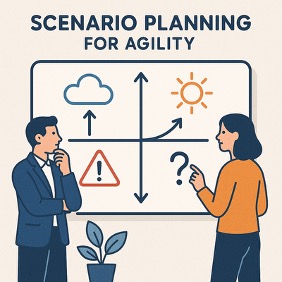
Action Plan Review:
• After one month, review the organization’s progress against defined scenario planning actions.
• Document successes, challenges faced, stakeholder feedback, and lessons learned.
• Adjust and refine the scenario planning implementation plan accordingly to ensure ongoing strategic effectiveness and agility.
Inputs:
• External trend and uncertainty analyses
• Internal assessment of scenario planning capabilities
• Scenario planning exercises and workshop insights
Outputs:
• Comprehensive Scenario Planning Strategy Document
• Detailed action plan with measurable milestones
• Initial stakeholder communication outcomes and training effectiveness
• Preliminary monitoring feedback results and strategic adjustments
Note: This document serves as a strategic blueprint to effectively embed scenario planning within the organizational framework, ensuring preparedness, strategic flexibility, and sustained agility in the face of future uncertainties.
Project Study (Part 7) – Communicating a Strategic Vision
Introduction:
Visualize a future scenario (within a 1 to 3-year horizon) where your organization has successfully communicated its strategic vision, leading to enhanced organizational alignment and engagement. Identify the most impactful results of effectively sharing your vision. Which outcomes are particularly desirable, and why?
Image too small
Strategic Benefits:
Evaluate specific strategic benefits your organization stands to gain from effectively communicating its vision. Consider benefits related to alignment, employee engagement, stakeholder buy-in, clarity of purpose, and coordinated actions. Highlight at least three critical strategic benefits and explain their significance in achieving your organization’s objectives.
Potential strategic benefits might include:
• Improved organizational alignment and coherence
• Increased employee motivation and productivity
• Enhanced stakeholder trust and support
• Clarity in strategic direction and decision-making
Implementation Roadmap:
• Develop a detailed roadmap outlining steps to effectively communicate your organization’s strategic vision.
• Identify key communication activities, platforms, and tools, such as town hall meetings, digital communications, and storytelling methods.
• Assign clear responsibilities to ensure accountability and consistency in message delivery.
Evaluation Metrics:
Define clear metrics to evaluate the effectiveness of your vision communication strategy. Include measures related to stakeholder awareness, understanding, engagement, and feedback mechanisms.
Example metrics could include:
• Employee engagement scores related to vision comprehension
• Frequency and effectiveness of vision-related communications
• Stakeholder feedback on clarity and relevance of strategic messages
Conclusion:
Summarize the anticipated long-term benefits of a robust strategic vision communication strategy. Reflect on how continuous, effective communication can strengthen organizational culture, promote strategic alignment, and drive collective achievement of organizational goals.
Project Study (Part 8) – Measuring Strategic Success
Introduction:
Imagine your organization has successfully established a robust system for measuring the achievement of its strategic vision within a 1 to 3-year horizon. Clearly outline the scenario, focusing on how measurement and tracking have positively impacted strategic execution and organizational performance. Identify and justify the outcomes most essential to your organization’s long-term success.

Strategic Benefits:
Evaluate and describe the specific strategic advantages your organization will gain by effectively measuring strategic success. Highlight improvements in decision-making accuracy, accountability, goal alignment, and performance optimization. Identify at least three strategic benefits, explaining why each is crucial for realizing your organization’s vision and mission.
Potential strategic benefits might include:
• Enhanced accountability and transparency
• Improved alignment of efforts toward strategic goals
• Increased responsiveness to changing conditions
• Strengthened organizational learning and adaptability
Implementation Roadmap:
• Outline a clear and detailed roadmap for implementing metrics and measurement systems aligned with your organization’s strategic vision.
• Define the specific processes and methodologies to track strategic objectives, such as balanced scorecards, dashboards, and periodic reviews.
• Specify roles and responsibilities clearly to ensure ownership and accurate reporting of performance metrics.
Evaluation Metrics:
Clearly define key performance indicators (KPIs) and metrics your organization will use to assess progress toward achieving its strategic goals. Include both qualitative and quantitative metrics that address performance, efficiency, stakeholder satisfaction, and strategic alignment.
Example metrics could include:
• Revenue growth and profitability benchmarks
• Customer satisfaction ratings (Net Promoter Score, customer feedback)
• Employee engagement and retention rates
• Operational efficiency improvements (cycle times, defect rates)
Conclusion:
Summarize the anticipated long-term benefits of consistently measuring strategic success. Emphasize how robust measurement practices can enhance strategic alignment, accountability, organizational learning, and ultimately drive sustainable success and growth.

Project Study (Part 9) – Leadership & Cultural Alignment
Introduction:
Envision your organization successfully aligning leadership practices with its organizational culture within the next 1 to 3 years. Describe a scenario where leadership behaviors, decision-making processes, and organizational values are effectively synchronized. Highlight the most impactful outcomes of achieving such alignment and justify their importance to the organization’s strategic success.
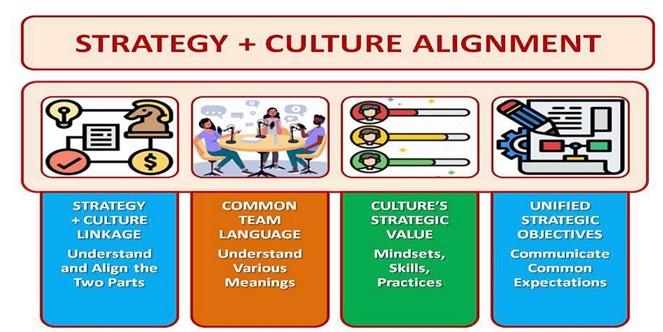
Strategic Benefits:
Identify and elaborate on specific strategic benefits your organization will realize from effective leadership and cultural alignment. Consider aspects such as enhanced collaboration, improved decision-making quality, increased employee engagement, and strengthened organizational identity. Select at least three strategic benefits and provide rationale for each in relation to achieving organizational objectives.
Possible strategic benefits include:
• Greater consistency in leadership behaviors and practices
• Enhanced employee motivation and retention
• Improved organizational agility and responsiveness
• Increased trust and credibility among stakeholders
Implementation Roadmap:
• Develop a structured roadmap detailing the steps your organization will take to foster alignment between leadership practices and organizational culture.
• Outline specific initiatives such as leadership training, cultural workshops, and alignment assessments.
• Clearly specify roles, responsibilities, and accountability measures to ensure successful execution of alignment initiatives.
Evaluation Metrics:
Clearly define measurable indicators and metrics to evaluate the effectiveness and impact of your leadership and cultural alignment initiatives. Include both qualitative and quantitative measures that address alignment outcomes, employee perceptions, leadership effectiveness, and organizational performance.
Example metrics could include:
• Leadership effectiveness ratings from employee surveys
• Cultural alignment and values adherence scores
• Employee engagement and satisfaction levels
• Reduction in turnover and increased employee retention
Conclusion:
Summarize the anticipated long-term benefits of effectively aligning leadership practices with organizational culture. Emphasize the role of leadership alignment in driving cohesive, effective, and high-performing organizational environments capable of achieving strategic goals sustainably.

Project Study (Part 10) – Execution & Roadmap Development
Introduction:
Visualize your organization effectively executing its strategic initiatives and clearly communicating a comprehensive roadmap within the next 1 to 3 years. Describe a scenario in which strategic projects are systematically managed, milestones are clearly defined, and stakeholders are well-informed. Highlight the most significant benefits realized through robust execution and roadmap clarity and explain their strategic importance.

Strategic Benefits:
Identify and outline specific benefits your organization will achieve through effective execution and roadmap development. Consider benefits such as improved strategic clarity, enhanced accountability, increased operational efficiency, and stronger stakeholder confidence. Provide at least three key strategic benefits and clearly justify their importance.
Possible strategic benefits include:
• Improved project delivery and timeline adherence
• Greater transparency and accountability
• Enhanced stakeholder alignment and engagement
• Increased strategic agility and responsiveness
Implementation Roadmap:
• Create a clear and actionable roadmap detailing the phases, key activities, and timelines required for strategic execution.
• Specify critical milestones, dependencies, and resources necessary for successful project delivery.
• Clearly define roles and responsibilities for stakeholders and project teams to ensure accountability and efficient execution.
Evaluation Metrics:
Define specific metrics to measure the effectiveness of your execution and roadmap initiatives. Include indicators related to timeline adherence, milestone achievement, resource allocation, and stakeholder satisfaction.
Example metrics could include:
• Percentage of projects delivered on time and within budget
• Achievement rate of predefined strategic milestones
• Stakeholder satisfaction ratings regarding roadmap clarity and communication
• Operational improvements and efficiency gains
Conclusion:
Summarize the long-term strategic benefits expected from effective execution and roadmap development. Emphasize how clear and actionable execution plans contribute to achieving organizational objectives, enhancing stakeholder confidence, and sustaining strategic success.
Program Benefits
Information Technology
- Digital transformation
- Cloud integration
- Cybersecurity resilience
- AI adoption
- System automation
- Data governance
- Scalable infrastructure
- Network optimization
- Software efficiency
- IT agility
Management
- Strategic vision
- Leadership agility
- Decision efficiency
- Change management
- Performance tracking
- Risk mitigation
- Process standardization
- Team alignment
- Productivity boost
- Innovation culture
Finance
- Cost reduction
- Budget optimization
- Automated reporting
- Risk assessment
- Revenue growth
- Financial forecasting
- Expense management
- Profitability analysis
- Compliance tracking
- Investment strategy
Client Telephone Conference (CTC)
If you have any questions or if you would like to arrange a Client Telephone Conference (CTC) to discuss this particular Unique Consulting Service Proposition (UCSP) in more detail, please CLICK HERE.
